






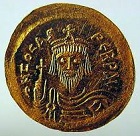
















TLW's Byzantine Emperorscope™ (Byzantine Emperor Historyscope) |
By T.L. Winslow (TLW), the Historyscoper™ |
© Copyright by T.L. Winslow. All Rights Reserved. |
Original Pub. Date: Mar. 8, 2016. Last Update: Dec. 18, 2022. |

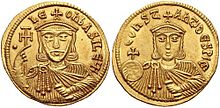
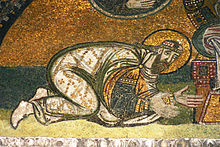


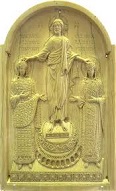


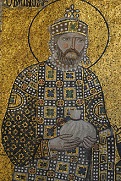



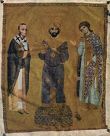


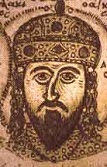
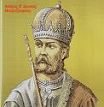
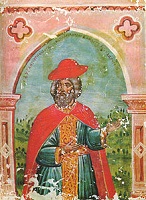


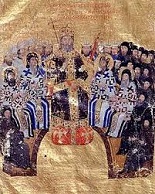


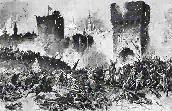
Westerners are not only known as history ignoramuses, but double dumbass history ignoramuses when it comes to Byzantine emperor history. Since I'm the one-and-only Historyscoper (tm), let me quickly bring you up to speed before you dive into my Master Historyscope.
The busy bee Byzantine emperors begin in 330 C.E. and go for 99 emperors until the fall of Constantinople in 1453 C.E., a happy-sad tale of a proud new Latin-speaking trailblazing nation-state at the border between Europe and Asia that became the last hope of the Western Roman Empire but went Greek and split-off from the Roman Catholic Church for a thousand years, holding off the Asiatic hordes while the West regained its strength, only to end up an encircled border town which was swallowed alive by Muhammad's Great Jihad after their estranged Western brothers cut them loose.
In 676 B.C.E. Greeks from Megara colonize Chalcedon on the Asiatic side of the Hellespont, and it becomes known as "the city of the blind" because the settlers missed the better site of Byzantium on the European shore.
In 667 B.C.E. Greeks from Megara found a colony at Byzantion (Byzantium) on the site of the Thracian fishing village of Lygos on the Golden Horn (an arm of the Bosporus), and name it after King Byzas (Byzantas) of Thrace, who was told by the oracle of Apollo at Delphi to settle there, marrying Lygos gov. Barbysios' daughter Phidalia.

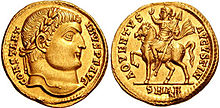
On Nov. 8, 324 after getting pissed-off at the opposition of the still pagan Roman Senate to his courtship of Christianity, Roman emperor #57 (306-337) Constantine I the Great (272-327) announces a dream he had to transform the Greek city of Byzantium into the new crackalackin' mamajama holy Christian capital city of New Rome, AKA Constantinople, which is already laidout on seven hills, just like Rome; construction begins on the W wall. On Nov. 26, 329 Constantine I lays the foundations of New Rome (Roma Nova), later called Constantinople; meanwhile his real capital is in Nicomedia until the plaster and paint dry. Lucy and Ricky ditch run-down New York for bright sunny L.A.? On May 11, 330 after using the spoils from pagan temples in Greece and Asia to pay for it, the new improved city of Byzantium commanding the strategic Bosporus Straits, renamed New Rome is formally dedicated by Roman emperor #57 (306-37) Constantine I (the Great) (Flavius Valerius Aurelius Constantinus) (271-337) as a new Rome 800 mi. E of the old Rome; it becomes known as Constantinople (Constantine's town), becoming the foundation of the busy-bee Byzantine Empire, which lasts 1123 years (until 1453); the city's longtime crescent symbol, of Diana, goddess of the hunt (Hecate, goddess of the crossroads?) is kept, with the star symbol representing the Virgin mary added; the myth that Constantine I Da Great was divinely appointed by God to found the city causes it to develop a mythical aura which is later used to scare off invaders, and it is usually referred to as Great City (megalopolis), Queen City (basileuousa), or simply The City (polis); located at the crossroads of the trade routes between Europe and Asia at the hub of the great eastern trade centers of Ephesus, Antioch, and Alexandria, it is within striking distance of the Danube River and the eastern front, and close to the Balkans where the finest soldiers come from, plus it's at the entrance to the Bosphorus on a point of land jutting out from Europe separating the Sea of Marmora on the W from the long natural Golden Horn harbor on the east, which is a natural defense point; after finally being conquered by the Muslims in 1453, it is later (1930) renamed Istanbul (Gr. "eis ten polin" = "into the city"); Constantine I imports a mob of the "Roman people" (proletariat) to give the city a Roman flavor, and founds a new Roman govt. in Constantinople complete with a Roman-style Senate (although both are limited to governing the city) and two annual consuls, and lures leading Roman citizens to move in by offering them exact reproductions of their homes and palaces; to attract the hoi poloi he begins offering free circuses and 80K loaves of bread a day, which backfires as Constantinople becomes a Greek rather than Latin city by the 6th cent.; he issues the new pure gold solidus coin, which reestablishes monetary stability and remains the standard coinage of the Eastern Empire until 1070; there are 72 coins per lb. of gold, compared to 60 in Diocletian's aureus; intending New Rome to be the Christian capital of the world, binding people of all nationalities with a common religion, Constantine I orders the building of the finest churches ever, incl. the Church of Holy Wisdom (Hagia Sophia), Church of the Holy Apostles (Imperial Polyandreion), and the Church of the Holy Peace (Hagia Irene or Eirene); the Basilica of Saint Paul Outside the Walls is built over the alleged burial place of St. Paul where followers had erected the Cella Memoriae memorial; he gives the bishop of Byzantium the title of patriarch; a few large pagan temples are closed, and the others are looted for gold; he allegedly prohibits the making of sacrifices to "false gods", and makes Latin the official language of the city; he loots Greece and Asia Minor for art treasures and places them about the city, turning it into a giant museum, incl. 400 statues in front of the Hagia Sophia; he orders libraries built and filled with Greek mss. (not that anybody reads them if they're by pagans?); the churches in the East lose their independence and come under state control; the armies of the empire are restationed so as to protect the new capital and the E borders, leaving the West and its old capital poorly defended, which dooms it in the coming cent.; meanwhile the new idea of the emperor as God's vicar on Earth complete with divine attributes was born, becoming the #1 theme of European politics until the 12th cent.




On Apr. 3, 337 (Easter Sun.) after banishing Jewish rabbis from his empire, Constantine I (b. 271) falls ill (poisoned by the Athanasians with a Trinity treat?), travels to Helenopolis, then Nicomedia, is baptized by Arian (yes!) bishop Eusebius of Nicomedia (-341), and dies on May 21/22, wearing the white robes of a Christian neophyte (no shamrocks in sight?); the still mainly pagan Roman Senate places him among the pagan gods, while his sarcophagus is placed in the Church of the Apostles in an effort to make him the 13th Apostle (his birth was the most miraculous event since the Resurrection?); as soon as he grows cold, the "massacre of the princes" purges many of his relatives, and in late summer his nephews Flavius Dalmatius Caesar and Annibalianus Caesar are murdered by the army; on Sept. 9 Constantine I's three sons Constantius II (Flavius Valerius Julius Constantius) (317-61) (Arian), Constantine II (Flavius Valerius Claudius Constantinus) (316-40) (Athanasian), and Constans I (Flavius Valerius Julius Constans) (320-50) (Athanasian and gay?) meet in Pannonia, and each assumes the rank of Augustus (Roman emperors #63, #64, #65), and divide the empire: Athanasian Constantine II rules the West (prefectures of Italy, Gaul and Egypt); Arian Constantius II rules the East except for Macedon, Thrace, and Achaea, which go to Athanasian Constans I, who also gets Illyricum and part of Africa; Constantius II promulgates a law making the marriage of a Jewish man to a Christian woman punishable by death, and in 339 ups it to making conversion to Judaism itself a criminal offence subject to confiscation of all property; Persian shah Shapur II invades Mesopotamia to take on Constantius II, beginning the Sixth Roman-Persian War (ends 363).

Speaking of Jedi Knights? In 361 with the Creed of Constantinople simmering things down, just when maybe, Constantius II replies to Julian's messengers that he must step down and surrender to Gallic Arian bishop Epictetus, with the promise of a pardon, and Julian sees through this and sends Constantius' ambassador, questor Leonas back with a declaration of war, and publicly renounces the whole blasted confounded Christian religion weeks after celebrating the Christian festival of the Epiphany, declaring himself the implacable enemy of both his uncle Constantius (who murdered his family and inexplicably spared him, and which he now suddenly remembers?) and Christ, and lamenting the long years when he had to put up the pretend act; his praetorian prefect Nebridius brashly stands up for Constantinus, and a soldier cuts off one of his hands, causing him to fall at Julian's feet, who protects him with his purple mantle, but replaces him with Flavius Sallustius of Spain, who promises to cut taxes, after which Nebridius marries rich Constantinople babe St. Olympias (360-408) and does okay for himself; Julian then sends an army of 10K under cavalry Gen. Nevitta to Rhaetia and Noricum in Illyricum, hoping to rally the people to his side and capture their gold and silver mines, and a 2nd army under Gens. Jovius and Jovinus through the Alps to N Italy; Julian then makes a secret supermarch wih 3K soldiers through the Black (Marcian) Forest, captures a fleet of ships and sails down the Danube, arriving at Sirmium before his opponent even knows he has left the Rhine, and is received as a conquering hero, celebrating the games at the circus, then takes the narrow Succi Pass on Mt. Haemus which separates Thrace and Dacia; the Roman Senate smells the roses and recognizes him as emperor; meanwhile Sapor retreats from Syria, and Constantius II gives a speech in his camp in Hierapolis how he will soon have his rival's head adorning the city gates; as he prepares to march against him he sends Gaudentius to Africa to stop grain shipments to Rome, which puts a dent in Julius' plans; meanwhile some Sirmium legions whom Julian had coopted turn on him and hole up at Aquileia, causing Julian to send Gen. Jovian to siege them, where they prove the place virtually impregnable, giving Julian another worry, but on Nov. 3 (the gods be praised?) 45-y.-o. Roman emperor (since 337) Constantius II (b. 317), last surviving son of Constantine I dies of a fever in the town of Mopsucrene 25 mi. from Tarsus after magnanimously naming Julian as his successor, and after a little commotion caused by eunuch Eusebius trying to get another emperor elected at Constantinople, Julian the Apostate (Flavius Claudius Julianus) (331-63) becomes Roman emperor #71 (until June 25, 363), and is met at Heraclea (60 mi. away) by the pop. of Constantinople, who conduct him triumphantly to the capital, where he attends the funeral of Constantius without his diadem dressed in mourning and shedding tears; he pardons the Aquileia rebels after they kill their leaders, publicly renounces the Christianity his elders had tried to brainwash him into, proclaims his belief in Mithraism and Neo-Platonism, but instead of taking advantage of the situation and stamping out the pesky Christians (still in a minority) with a new persecution, the tolerant Emperor Julian issues an edict of toleration, permitting all religions, even intolerant Christianity freedom of worship, while unsuccessfully attempting to reinstitute a tolerant paganism with himself as an ascetic, vegetarian, razor-spurning, bath-despising, floor-sleeping philosopher-king, who is head of a polytheistic church, where "one should diligently study the systems of Pythagoras, of Plato, and of the Stoics, which unanimously teach that there are gods; that the world is governed by their providence; that their goodness is the source of every temporal blessing; and that they have prepared for the human soul a future state of reward or punishment"; under his patronage, pagan philosopher Sallust (Sallustius) (the pretorian prefect of Gaul?) writes On the Gods and the Cosmos, with the aim "to parry the usual onslaughts of Christian polemic", and "meet theology with theology"; Julian dismisses the herd of palace eunuchs, slaves, and parasites, tries and executes the eunuch chamberlain Eusebius and other ministers in Chalcedon (under Sallust Secundus, prefect of the East), revokes govt. support of Christian clergy, shifts imperial funding to the old pagan cults, forbids Christians to teach Greek and Latin lit., and allows all banished Christian clergy of every stripe to return, incl. Athanasians, Donatists, Novatians, Macedonians, and Eunomians, inviting them all into his palace to argue with each other before trying in vain to convert them to paganism with eloquent speeches; "Hear me! The Franks have heard me, and the Alamanni!"; "And though he exerted the powers of oratory to persuade them to live in concord, or at least in peace, he was perfectly satisfied, before he dismissed them from his presence, that he had nothing to dread from the union of the Christians"; he restores pagan sacrifices, and insists on slaughtering animals and reading their hearts and livers himself; nobody's perfect, so he does passively condone attacks on Christian churches? Julian appoints Sixtus Aurelius Victor as prefect of the Second Pannonia, and executes Gaudentius, praetorian viceregent of Africa, and Duke Artemius of Egypt in Antioch. During his long poontang-free winter nights in Constantinople this year and Antioch next year, Julian writes The Misopogon (Beard-Hater) (satirical essay on philosophers), The Caesars, and the bestseller Twenty Years a Christian Slave and Ten More a Christian Hypocrite, or, Why the Christian Religion Sucks and Paganism Rocks, an elaborate refutation of Christianity beloved of pagans, which is later suppressed and only survives in quotations in a polemic by St. Cyril of Alexandria; too bad, all this only causes the Nicene party of the West to harden around their homoousios position? After declaring Jehovah a "great god" and ending Jewish persecution, then asking Jewish leaders why they still don't perform animal sacrifices, and being told that they can only do it in the Temple of Jerusalem (demolished in 70 C.E.), Emperor Julian the Apostate allows the Jews to return to Jerusalem, calling it "holy Jerusalem, which you have for many years longed to see rebuilt"; too bad, flames burst from the ground twice as the foundations are being dug, killing several workmen, causing Christians to rejoice that God is against them.
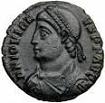
In spring 363 pagan philosopher-king Roman emperor (since 361) Julian the Apostate (b. 331) invades Persia, forces a passage over the Tigris River, and in May sieges the Persian city of Ctesiphon, pushing Persian forces back S into the city without capturing it, concluding a peace by which Rome returns the territories W of the Tigris River, ending the Sixth Roman-Persian War (begun 337); on June 26 on his way back home he is KIA in a battle on the Persian frontier near Samarra by a Persian cavalryman's lance, ending the line of Constantine, and the next day Jovian (Flavius Jovianus) (331-64), a Christian is elected Roman emperor #72 (until Feb. 17, 364) by the army, going on to copy Julian and issue an edict of gen. toleration; too bad that Christanity has penetrated the army so fully that all future emperors are Christians, although it takes almost 30 years before official persecution begins again; meanwhile the Persians take over Mesopotamia, and recapture Nisibis without a fight despite pleas from the pop. to emperor Jovian that they are willing to fight, causing the Roman pop. to move to Amida and the Christian School of Nisibis led by Ephrem the Syrian to flee to Edessa; Roman historian Ammianus Marcellinus, who is in Nisibis at the time later disses Jovian in his writings. The reconstruction of the Temple of Jerusalem is halted by Julian's death, opposition by the rabbis, and an earthquake on May 19, which also destroys half of the ancient city of Petra (where Indiana Jones finds the Holy Grail?); the old restrictive laws are reenacted and made more severe, and the Jews are again banned from Jerusalem, causing Jerome to report that the Jewish pop. of Palestine is "but a tenth part of their previous multitude". Eusebius of Vercelli returns to Vercelli, where he gleefully stamps out Arianism.

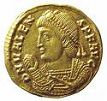
On Feb. 17, 364 after making a humiliating peace with the Persians under Shapur II the Great, who recover their Mesopotamian territories ceded by Narses in 298, as well as Nisibis and Singara, Roman emperor (since 363) Jovian (b. 331) dies under suspicious circumstances, and on Feb. 26 Valentinian I (Flavius Valentinianus) (321-75) is proclaimed Roman emperor #73 of the West by the army; on Mar. 28 he appoints his pagan brother Flavius Julius (Iulius) Valens (328-78) as Roman emperor #74 of the East (until 378); Valentinian and Valens renew Jovian's edict of gen. toleration, but begin confiscating non-Christian temple lands while leaving the temples open.

In 378 after many Visigoths are allowed to enlist in the Roman army only to be mistreated by Roman officers, the Visigoths banish Athanaric, and Fritigern becomes their new leader, immediately standing up to the bungling imperial officials, refusing to disarm, and planning an attack on Constantinople; too late, the Romans belatedly decide to correct their mistake and renege on an agreement to let them cross the Danube River to the S and settle in Roman territory as good little boys and girls, but the Visigoths say stuff it and defeat and massacre two-thirds of the Roman army under Roman emperor (since 364) Valens (b. 328) on Aug. 9 at the Battle of Adrianople (Adrianopolis) (after he gets tired of waiting for reinforcements and goes ahead without them), becoming the worst Roman D since the 216 B.C.E. Battle of Cannae, as well as their first cavalry battle (during which the Roman cavalry flee); Valens is mortally wounded by an arrow, and retreats to a country house (small wooden hut?), which is set on fire by the Goths, killing him; the Goths then give up on taking Constantinople and ravage Thrace; Western emperor Gratian appoints Spaniard (son of Valentinian I's magister equitum) Flavius Theodosius (Gr. "God's Gift") I "the Great" (347-95) to lead the Eastern Roman armies; the Western Roman Empire and its broken military can be stuck with a fork, and the Rhine-Danube frontier is broken for all time, with the barbarians able to invade at will, making it critical to absorb the *?*!* Goths and use them as a buffer, which doesn't end up working out?; Bishop Ambrose of Milan identifies the pesky Goths with Ezekiel's Gog, and calls the demise of pagan-protecting Valens a sign from God, issuing the soundbyte: "The End of the World is coming upon us."
On Jan. 19, 379 after some military successes, Gratian hails Theodorius I as his co-Augustus of the East (Roman emperor #77) (until 395) in succession to Valens in Sirmium; ever since Adrianople last year the Roman army is seen as out of date, and Theodosius I attempts to recruit more cross-kissing baptized cavalry units.



395 On Jan. 17, 395 Roman emperor (since 379) Theodosius I (b. 346) dies in Milan, becoming the last to rule over both halves of the empire, and his 18-y.-o. son Flavius Arcadius (377-408) succeeds to the more important Eastern throne in Constantinople as Roman emperor #79 (until May 1, 408), while 11-y.-o. son Flavius Honorius (384-423) succeeds to the less important Western throne in Ravenna as Roman emperor #81 (until 423); Arles in S Gaul becomes the seat of the praefecture of Gaul, also governing Spain and Armorica (Brittany); "The genius of Rome expired with Theodosius, the last of the successors of Augustus and Constantine who appeared in the field at the head of their armies, and whose authority was universally acknowledged" - Gibbon, Ch. 29; Gen. Stilicho is made guardian of his sons Arcadius and Honorius by Theodosius I on his deathbed, virtually ruling the West; Dacia and Macedonia are split off from Illyricum and become part of the Eastern Roman Empire, along with Syria and the no-longer-great learning center of Rhodes, leaving Noricum, Pannonia, and Dalmatia to Honorius; Singidunum (modern-day Belgrade) ends up on the NW border of the Eastern Roman Empire; Albania begins to be ruled by the Byzantines (until 1204); "The boundary in Europe was not very different from the line which now separates the Germans and the Turks; and the respective advantages of territory, riches, populousness, and military strength, were fairly balanced and compensated in this final and permanent division of the Roman Empire" - Gibbon, Ch. 29; cruel crafty Gaul-born ultra-religious-acting Rufinus, master of the offices under Theodosius I becomes prefect of the East, dominating over the young Arcadius while getting rich and plotting to marry his daughter to him, and plotting against Stilicho; "His avarice, which seems to have prevailed in his corrupt mind over every other sentiment, attracted the wealth of the East by the various arts of partial and general extortion" - Gibbon, Ch. 29; early in the year Stilcho crosses the Alps, revives the Roman garrisons on the Rhine, and suppresses the Germans, obtaining a "firm and honorable peace", then returns to Milan; Alaric I (370-410), who had hoped for a career in the Roman service gets pissed off at Theodosius' death and Stilicho's promotion in his place, is declared king of the Visigoths (until 410), and, conspiring with Rufinus, immediately renounces his allegiance to Rome, claiming an interruption of the subsidy; in late winter "The barriers of the Danube were thrown open; the savage warriors of Scythia issued from their forests; and the uncommon severity of the winter allowed the poet [Claudian] to remark 'that they rolled their ponderous wagons over the broad and icy back of the indignant river'" - Gibbon, Ch. 30, crossing to Thrace, then Dalmatia, then to the gates of Constantinople, which they can't take, then W across Macedonia and Thessaly into Greece, which had last seen Gothic hordes in 267-8, while Rufinus plots to let him conquer it by having his proconsul Antiochus recall the troops guarding the Pass of Thermopylae ("a road capable of admitting only a single carriage" - Gibbon); the lucky (with Greek women) Visigoths sack Phocis and Boeotia, bypass 7-gated Thebes in their haste, and spare Athens in exchange for a heavy ransom, plus a free bath and banquet for Alaric; they then continue on to ravage Corinth, Argos, and Sparta, raping Greek women and stealing vases and statues, and wiping out the last remains of paganism with the help of happy monks who follow along; the Eleusinian Mysteries at the Temple of Eleusis are no longer celebrated after this; meanwhile Arcadius gets Stilicho to come to Greece with Western troops in ships which land near the ruins of Corinth, where they take on Alaric I in Arcadia (home to Pan and the Dryads), causing him to retreat to the mountains of Pholoe, where he is sieged and starved, the Alphaeus River being diverted to take away the water supply; too bad, instead of sticking around, half-barbarian Stilicho goes off to enjoy Greek poontang and theater, leaving his soldiers free to rape the land themselves, and allowing Alaric and his host to sneak away and escape over the Gulf of Corinth, then conclude a treaty with Constantinople which orders Stilcho to get out of "their" empire, and makes Alaric master-gen. (prefect) of Illyricum, becoming the ruler of the cities he had just raped; this example encourages other barbarians to get their own piece? - give a mouse a cookie and he'll ask for a glass of milk?


On May 1, 408 Roman emperor #79 (since 395) Arcadius (b. 377) dies, causing the planned Western Roman attack on the Eastern Roman Empire to be abandoned, pissing-off Alaric I and causing him to demand two tons of gold as an indemnity; Arcadius' 7-y.-o. son Theodosius II (Flavius Theodosius Junior) (the Calligrapher) (401-50) becomes Roman emperor #83 of the East (until July 28, 450), with his eldest sister (a dedicated virgin) Aelia Pulcheria (Lat. "beautiful") (399-453) as regent and real ruler, and Praetorian Prefect Anthemius as co-regent (until 414), who has the Theodosian Walls built, incl. a new W wall for Constantinople to protect the rapidly-growing suburbs, and a connecting seawall; Constantine III makes Arles in S Gaul his capital.
In 431 the Third (3rd) Council of Ephesus, called by Theodosius II and Valentinian III and attended by 250 bishops convenes, presided over by (St.) Cyril of Alexandria (376-444), going on to condemn Chiliasm (Millennialism) (Millennium Fever) (MF) as a dangerous superstition, and condemning Montanus as a heretic, which doesn't stop his sect from surviving until Pope Leo I forcefully exterminates them by 461; the council also condemns the nasty nested heresy of Nestorius (386-451) (which denies the Theotokos, or that Mary is the Mother of God, but allows her the title of Christokos, or Mother of Christ), deposing him as patriarchate of Constantinople on June 22; it also endorses the Hypostatic Union, the doctrine that Jesus had two natures, and was/is truly God and truly man simultaneously, but without mixture (alteration, absorption or confusion) of the two; Celestine I tries to impose himself as the supreme pontiff of Christianity, but is brushed off (leave it to the Church historians to fix up the history books ex post facto)?; of course, the well-nested Nestorians won't change, and split from the Byzantine Church as the Assyrian Church of the East, helping to split the East from the West in conjunction with the struggles over Monophysitism, becoming the early-warning tremors of the East-West Church Schism; meanwhile Bishop Rabbula of Edessa burns the writings of Theodore of Mopsuestia, and the Christian School of the Persians in Edessa is closed by the Romans.

In July 450 Roman emperor (since 408) Theodosius II (b. 401) is thrown from his horse into the Lycus River near Constantinople, and dies several days later on July 28 at age 50 after reigning 43 years; his eldest sister (supposedly a virgin) Aelia Pulcheria (399-453) is proclaimed Roman emperor #92 of the East, becoming the first female ruler of the Romans; she has the eunuch Chrysaphius executed before the city gates without a trial, and the move is so unpopular that to cover her butt she marries 60-y.-o. Thracian-born tribune and senator Marcian (Flavius Marcianus) (392-457), who becomes Roman emperor #93 of the East (until 457) (last of the House of Theodosius), being crowned by the Constantinople patriarch on Aug. 25 (the first religious coronation of an emperor); too bad, he makes the big mistake of sending ambassador Apollonius to Attila to demand an end to the annual tribute, causing the latter to send ministers to both the Eastern and Western emperors with the message, "Attila, my lord and thy lord, commands thee to provide a palace for his immediate reception"; thinking the East is too easy, he prepares an attack on the more wealthy West first?
When and how did boy Jesus realize his superhuman nature and/or powers and/or mission, and how did he deal with it? Ask Anne Rice? On Oct. 8-Nov. 1, 451 the Council of Chalcedon (Fourth Ecumenical Council) of 500 bishops in Chalcedon across from Constantinople, called by Emperor Marcian and presided over by the patriarch of Constantinople accepts Pope Leo I's interpretation of the Trinity, and promulgates the doctrine of Mariolatry (worship of the Virgin Mary), causing a split between the Syriac Orthodox Church of Antioch, Coptic Orthodox Church of Alexandria, and later the Armenian Apostolic Church on one hand, and the Latin Roman and Greek Byzantine Churches on the other over the life-death matter of whether Christ, who was both God and man, had one composite incarnate nature "from two" natures, human and divine, now known as the Orthodox doctrine, or was "in two natures", known as the Monophysite ("single nature") doctrine, with Christ's human nature "dissolved like a drop of honey in the sea" in his divine nature, and thus had a divine soul or mind combined with a human body; the emperor sides against the Monophysites, and the council affirms the power-drive Chalcedonian formula that Jesus had two natures, and was/is truly God and truly man simultaneously, but without mixture (alteration, absorption, or confusion) of the two, and declares the 449 Second Council of Ephesus a "robber synod" and annuls its proceedings, causing the persecution of Monophysite churches in Egypt and Syria to begin, which ends up adding to the permanent split between the Eastern and Western empires, although for the time being the council grants the See of Constantinople the same privileges of honor as the See of Rome, with the primacy going to the Roman See; Armenian abbot (St.) Euthymius the Great (377-473) of Palestine is instrumental in getting the eastern monks to accept the council's decrees, but Egypt, Syria, Mesopotamia, and Armenia end up going non-Chalcedonian just as the pesky Sassanid Persians are threatening, allowing them to take advantage of the religious divisions.


On Jan. 27, 457 Roman Byzantine emperor (since 450) Marcian (b. 392) dies, and after being chosen by Gothic army CIC Flavius Ardabur Aspar (400-7171), is succeeded by (St.) Leo I the Thracian (401-74) as Roman emperor #96 of the East (until 474), becoming the first to be crowned by the patriarch of Constantinople; Ricimer retains power by securing the consent of Leo I to his nominee Majorian (Julius Valerius Majorianus) (420-61), who becomes Roman emperor #97 of the West; Leo I goes on to become a capable ruler, overseeing many plans and schemes to save the teetering Western Roman Empire, and becoming the first Eastern emperor to legislate in Greek rather than Latin; too bad, he starts out a puppet of Aspar, but begins using the Isaurians as a counterweight to his Goths, marrying his daughter Ariadne to Isaurian leader Zeno (Tarasicodissa); meanwhile the Vandals head E and lay Greece waste, followed by Dalmatia, then threaten Constantinople, causing Marjorian to make a major but unsuccessful attempt to stop them.
In 471 Emperor Leo I and the Isaurians conspire successfully to assassinate Gothic army CIC Aspar (b. 400) and his son Ardabur, ending Gothic domination of the Byzantines.




On Jan. 18, 474 Roman Byzantine emperor (since 457) St. Leo I (b. 401) dies of dysentery, and is succeeded by his infant grandson (son of Zeno and his daughter Ariadne) Leo II (the Little) (467-74) as Roman emperor #101 of the East (until Nov. 17); on Feb. 9 his daddy, Ariadne's Isaurian husband Trascalisseus (Trasicodissa) makes himself co-emperor Zeno (426-91), Roman emperor #102 of the East (until 491); in June after Leo I names him to stop Glycerius, Dalmatian cmdr. Julius Nepos ("nephew") (430-80), husband of Leo I's niece marches into Ravenna and claims the purple as Roman emperor #103 of the West (until 480), and Glycerius gives up without a fight, being made bishop of Salona (Solin) in Dalmatia; the Western Roman Empire now consists of Italy, part of the Balkans, and footholds in N and S Gaul; the Vandals begin launching pirate attacks on the coasts of Italy; too bad, on Nov. 17 Leo II dies, and Zeno (whose wife Ariadne probably poisoned him) becomes sole Eastern emperor, causing Leo I's widow Aelia Verina (-484) to depose "the worthless and ungrateful servant on whom she alone had bestowed the sceptre of the East" (Gibbon, Ch. 39), and replace him with her brother Flavius Basiliscus (-477) as Roman emperor of the East #104 (until 477); the game of Backgammon is first mentioned, under the name Tabula (table).
In 484 Pope Felix III, pissed-off at the Monophysite-leaning Henoticon excommunicates Byzantine emperor Zeno and the patriarch of Constantinople, beginning the Acacian Schism (ends 519) - just because we're down on the political scene, we ain't kissing your butts theologically?

On Apr. 9, 491 Byzantine emperor (since 474) Zeno (b. 426) dies, and is succeeded as Roman Byzantine emperor #103 (until July 9, 518) by Anastasius (Dicorus) I (431-518) (nicknamed Dicorus or two-pupiled for having one black eye and one blue eye), an elderly palace domestic raised to the throne by Zeno's widow Ariadne and her mother Verina to public acclaim with the chant "Reign as you have lived!"; he marries Ariadne and removes the Isaurians from power, causing a serious revolt in Isauria which takes until 497 to suppress; too bad, he is a Monophysite, causing revolts to brew.
In 512 after Monophysite Byzantine emperor (491-518) Anastasius I Dicorus official adopts the Miaphysite (Henophysite) (Gk. "mia" = single) dogma, which claims that Jesus unites divinity and humanity in himself without separation, confusion, or alteration, changing the form of the Trisagion prayer, pissing-off the Chalcedonians, Gothic orthodox Catholic pretender Vitalian (-520), cmdr. of the Bulgarian federati leads a revolt with an army of 50K-60K men, who are doubly pissed-off at the frugal emperor's refusal to supply their provisions (annonae), marching on Constantinople and encamping in the suburb of Hebdomon, sending his senior officers into the city to negotiate with the emperor, who promises them the Moon, causing Vitalian to break camp after eight days and return to Moesia.
In 513 Emperor Anastasius I sends an army under Gen. Cyril to attack Vitalian, who bribes the guards of his camp in Odessus and sneaks in at night, capturing him in his residence and killing him, pissing-off Anastasius I, who declares him a public enemy and sends an 80K-man army under Gen. Hypatius and Alathar the Hun, which wins a minor V before being pushed back towards Odessus by fall, and surprised-attacked and defeated at night at Acris on the Black Sea, with both cmdrs. taken POW and held for ransom.
In 514 Vitalian attacks Constantinople by land and sea, with 200 ships from Black Sea ports, causing a riot in the streets, causing Anastasius I to fold and pay a ransom of 5K lbs of gold for the release of Hypatius, and appoint Vitalian as magister militium of Thrace, then restore the Trisagion, allow the restoration of the deposed Chalcedonian bishops, and order a gen. church council next July 1, which never happens, and after the emperor reneges about the bishops, Vitalian plans another attack.
In Nov. 515 Vitalian again marches toward Constantinople, capturing the suburb of Sycae (modern-day Galata) across the Golden Horn, and encamping there, allowing a Byzantine fleet under praetorian prefect Marinus to defeat them at the entrance to the Golden Horn using Greek fire then land and dfeat the army on the shore, causing the rebels to flee at night, after which Anastasius I leads a procession in Vitalian's old HQ of Sosthenion; Vitalian goes into hiding.

On July 9, 518 Monophysite emperor (since 491) Anastasius I Dicorus (b. 431) dies after a reign of 27 years, during which he reformed the tax system and coinage, leaving a substantial surplus in the treasury (160 tons of gold?), and after palace eunuch Amantius makes the mistake of bribing the cmdr. of the imperial bodyguards to help his puppet onto the throne, 68-y.-o. humble Illyrian Justin (Justinus) I (Flavius Iustinus) (the Elder) (450-527), a feeble and illiterate old man (husband of Euphemia) who started out as a boy shepherd and worked his way up the military ladder starting with Emperor Leo I to gen., senator, and cmdr. of the guards becomes Byzantine emperor #104 (until Aug. 1, 527), founding the Justinian Dynasty (ends 602), going on to enact laws de-emphasizing the influence of the old Roman nobility; he makes the literate Proclus his questor; within days of the elevation, numbnuts Amantius is framed on conspiracy and heresy charges and beheaded, and his intended emperor candidate is murdered in a dungeon and thrown into the sea.
In 519 Justin I makes peace with Rome, repudiating the Monophysite-friendly Henoticon of 482, ending the Acacian Schism with Rome (begun 484).
In July 520 after Justin I and Justinian I trick him into coming into Constantinople, where he is acclaimed a hero and given the titles of consul and general (sucker!)?, in the 7th mo. of his consulship Chalcedonian orthodoxy champion Vitalian is stabbed to death at a royal banquet in the Great Palace along with his secy. Paulus and aide Celerianus, and Justinian I takes over his spoil, being promoted by his uncle (without any prior military service) to master-gen. of the Eastern armies, in line for the throne, which he doesn't just sit around and wait for, but actively plots to make a sure thing? - by hiring a PR firm, taking acting lessons and making contributions to all the right PACs?


On Aug. 1, 527 C.E. Byzantine emperor (since July 518) Justin I (b. 450) dies from an old war wound in the foot or thigh, and is succeeded by his previously (Apr.) crowned co-emperor, his nephew (St.) Justinian I (the Great) (Flavius Petrus Sabbatius) (Flavius Ancius) (482-565), who becomes Roman Byzantine emperor #105 (until Nov. 14/15, 565), ruling a good long 38 years, 7 mo., 13 days; he immediately seats his well-bathed ex-ho wife Theodora (500-48) on the throne as his equal; "Let greatness own her, and she's mean no more" (Warburton); together they rule 64 provinces and 935 cities, increasing the schism with the Roman Christians while sending missionaries to the pagans in Ethiopia and elsewhere, and immediately begin spending the treasury left by Anastasius like water on lavish living, building projects (countless churches and cloisters, whole towns to public baths, and hundreds of forts along the frontiers with a system of limitanei or frontier forces) and wars, ending up with army veterans having to beg for food, while taxing the wealthy heavily for the first time in the history of the empire, ultimately turning them against him; he promotes young Belisarius (505-65) to active command on the Persian front, alienating many slower-rising generals who are passed over. Paganism has now had it in both halves of the Roman Empire, and becomes dangerous or lethal to practice openly without an army, not to mention Catholicism of the wrong flavor of the month - maybe this is why "pagan" Islam starts out so militant?


On Jan. 11, 532 C.E. (Tues.) former Macedonian peasant Emperor Justinian I (who now is Thrice August, the Anointed of the Lord, the Vicar of God on Earth, and Equal of the Apostles, living in the Sacred Palace, and issuing Celestial Commands under the "providence of the Holy Trinity", and before whom officials must lie face down on the floor and kiss his feet and hands) attends the festival of the Ides of January in the Hippodrome in his royal purple (wearing a cross rising from a circle representing the Earth on his right shoulder) before a crowd of 40K subjects (whom he thinks have "dumbass" written on their foreheads?); when the Greens interrupt the 22nd race the emperor gives a speech to the crowd, turning the Greens against him and causing them to renounce allegiance, which causes the Blues to attack them, and the Nika Revolt (Riots) spreads to the streets; the govt. decides to hang a mixed group of seven Blues and Greens, and the ropes of two of them (one Blue, one Green) break, and the monks of St. Conon give them sanctuary at the St. Lawrence Church; the emperor gives another speech in the Hippodrome apologizing on the Bible, but they don't buy it, and when he refuses to release "the two who were condemned by your prefect and yet spared by God", referring the matter to his minister Eudaemon, both sides feel outraged and vindicated at the same time, and after killing the soldiers guarding the church and saving the prisoners they begin burning Constantinople and fighting the army, burning and looting the Hagia Sophia, the Baths of Zeuxippus, and part of the royal palace, along with many churches and buildings for five days while shouting "Nika!" (victory!); the emperor beats a hasty retreat to the palace, and to appease the mobs the hated ministers Tribonian and praetorian prefect (head tax collector) (a bear of a man?) John of Cappadocia are removed from office; the revolt escalates again as it becomes Arian (Green) vs. Orthodox (Blue), and Hypatius and Pompey, two rich nephews of former emperor Anastasius I fund the Greens, and on day 6 Hypatius is crowned by the Greens as new emperor, and Justinian is about to give up and flee when his ballsy wife stops him, telling him to make a last stand, saying, "I adhere to the maxim of antiquity, that the throne is a glorious sepulchre"; with the aid of Gen. Belisarius and eunuch Gen. Narses (478-573) and 3K veteran troops of the imperial lifeguards, who block the Blues and Greens in the Hippodrome and massacre them in a bloodbath which kills 30K (too late the Blues flip-flop and claim to be loyal to the emperor again?); the lead conspirators Hypatius and Pompey are executed with 18 high ranking accomplices, and the hippodrome closed for several years; Justinian orders a new Church of Hagia Sophia (pr. "ah-YEE-ah so-FEE-ah") to be built, designed by architects Anthemius of Tralles (474-534) and Isidore of Miletus (finished 537).
541 The Plague of Justinian (bubonic plague) strikes the Byzantine Empire (ends 542), killing 33%-60% of the pop. of the Mediterranean region, a total of 100M; actually, way less?
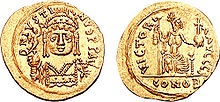
565 On Nov. 14/15, 565 emperor (since 527) Justinian I (b. 482) dies at age 83 after 38 years on the throne, leaving Greek Novellae Constitutiones Post Codicem (The Novels) (begun 514), a collection of 168 of his own "novel" decrees on social and private life, and after sacred bedchamber provost Callinicus claims he named him on his deathbed (rather than Germanus' son Justin) his nephew (son of his sister Vigilantia by her husband Dulcissimus) Justin II (Flavius Justinus Junior) (520-78) seizes the throne with the aid of Tiberius, cmdr. of the guard, and becomes emperor #106 of the East (until 574); Gen. Belisarius dies within a few weeks of Justinian; the later rumors that he died blind and penniless are bunk, although his war treasures were confiscated?; his wife Antonina receives a portion of his wealth, which she uses to start a convent; Justin II reacts to his uncle's profligacy and begins to tighten the purse strings, but otherwise stays the course?
In 574 after surrendering his throne to the regency of his wife Sophia last year, Byzantine emperor (since Nov. 15, 565) Justin II (b. 520) goes insane, and the empire is ruled by new regent (until 578) Tiberius II Constantine (520-82) (Justin II's imperial guard and personal friend), who negotiates a peace with Persia (ends 575); on Sept. 26, 578 Justin II raises regent (since 574) Tiberius II Constantine to full Augustus before croaking on Oct. 5, becoming Roman Byzantine emperor #107 (until Aug. 14, 582), and giving away 7.2K lbs. of gold a year for the rest of his reign; he goes on to watch the Avars (Slavs) move into Thrace and Greece and ruin the property values in the Balkans?

On Apr. 5, 582 (Easter) Eutychius I (b. 512) dies, and Emperor Tiberius II makes ascetic Hagia Sophia deacon John IV (the Faster) (Nesteutes) (-595) the patriarch of Constantinople (until 595), becoming the first to use the title "ecumenical patriarch", pissing-off Pope Gregory I, who calls it "diabolical arrogance", adding that anybody using it is the Antichrist, instead opting for "servant of the servants of God". On Aug. 14 emperor (since 574) Tiberius II Constantine (b. 520) dies, and on Aug. 14 Maurice (Flavius Mauricius Tiberius Augustus) (539-602) succeeds him as Roman Byzantine emperor #108 (until Nov. 27, 602) after marrying his daughter Constantina (560-605) on Aug. 5; too bad, his defensive mentality ends up making him unpopular in the capital; John IV the Faster persuades Maurice to have wizard Paulinus burned at the stake.

In 602 after stingy emperor (since 582) Maurice (b. 539) jerks his Balkan army around by refusing to pay ransom for POWs and making them winter on the N side of the Danube River, ordering them to attack while withholding wages, Byzantine gen. (lt.?) Phocas (Phokas) leads an army revolt on the Danube River, marching to Constantinople, causing a popular insurrection in the city led by the Greens, collapses the govt. within 1 mo. and deposing Maurice, who flees to Nicomedia but is captured and executed along with his six sons and supporters on Nov. 27 (Nov. 23?); in Nov. Phocas is crowned Roman Byzantine emperor #109 Phocas (Phokas) (Gr. "a seal") (Flavius Phocas Augustus) (547-610) (until Oct. 5, 610), and proves totally incompetent but too cruel to be kind, the execution of Khosrau II's patron provoking a devastating Byzantine-Sasanian War of 602-8 with Persia that weakens both empires and softens them up for the Muslims; he becomes the first Byzantine emperor to break the old Roman tradition of being clean-shaven, sporting a beard - the Hadrian of the East?

In 610 Gen. Priscus, supported by the exarch of Africa begins a conspiracy against "The Beard" (Phocas), sending an army by land which conquers Egypt, while a fleet from Carthage arrives at Constantinople (son of the African exarch) as Byzantine emperor #110 on Oct. 5 (until Feb. 11, 641), founding the Heraclian Dynasty (ends 711); he ends the use of Latin in his empire in favor of Greek; Khosrau II continues his war, taking the leading cities of Armenia and Cappadocia this year and next, while Heraclius is worrying about the Avars in the NW; Patriarch (610-38) Sergius I (-638) of Constantinople becomes his big backer, and a big promoter of Monothelitism.
In 622 Emperor Heraclius I sails from Constantinople with 50K men and defeats the Persians under Shahrbariz in the Third Battle of Issus (-333, 194) in Cappadocia near the border of Cilicia and Syria in the modern-day Turkish province of Hatay, pushing them back from the Mediterranean; meanwhile the W Turks conquer the Oxus Valley and fight with Heraclius I against Persia, taking Khorasan in modern-day Afghanistan; too bad, Heraclius I starts the Monothelete Controversy, claiming that the divine and human natures in Christ had but one will and one operation, i.e., one theandric energy (i.e., he didn't have two wills, divine and human, and therefore had to always choose between a fallible human action or a divine one, but only one will, therefore was always guided by his divinity), causing a controversy which rages for 60 years; one little problemo, Luke 22:42: "Father, if you are willing, remove this cup from me. Neverthless, not my will, but yours be done"; also John 5:30: "I do not seek my own will but the will of the Father who sent me" - I just don't savy it, Saavik?
In 628 The courts of Byzantine emperor (610-41) Heraclius I in Constantinople, Persian shah (628) Kavadh II in Ctesiphon, and Tang emperor (626-49) Tai Zong (Tai Tsung) in Canton are visited by Arab envoys of the new kid on the block, "the prophet of God" Muhammad (570-632), currently residing in the squalid trading town of Medina in deodorant-challenged Arabia, who sends them Aslim Taslam Letters ("accept Islam and you will be saved"), telling them to acknowledge the one true Alpha (with him as Omega?) and submit, or else, with the typical Muslim threat soundbyte "I invite you to Islam, and if you become a Muslim you will be safe and Allah will double your reward, but if you reject this invitation of Islam you will be committing a sin by misguiding your people (Arisiyin = peasants)"; as the story goes, Heraclius, busy with restoring order in Persia shrugs it off; Kavadh, hearing of how he had dechristianized and Muslimized Yemen, tears it up, throws it in the envoy's face and orders Muhammad to bug off, causing the latter to cry to Allah to rend his kingdom from him; only emperor Tai Zong treats his envoys with respect, and allows them to build a mosque for Arab traders in Canton - the origin of the priest, minister and rabbi joke?


On Feb. 23-24, 628 (night) Khosrau II's treacherous eldest son (by Christian princess Shirin) Kavadh II (Sheroe) (Shiruya) (590-628) is released from captivity and proclaimed king #23 on Feb. 25 by some Persian nobles, and on Feb. 28 after remaining behind Persian lines for the winter, having ruled since 590 and extended the Sassanian Empire frontiers almost to the limits of the Achaemenid Empire, Khosrau II Parvez (Ever-Victorious) and his other 18 sons are murdered in the palace; Kavadh II makes peace with Heraclius I, restores the True Cross of Christ to him along with POWs, and agrees to evacuate all his conquests in Egypt, Palestine, Syria, Asia Minor, and W Mesopotamia; too bad, Persia took such a big bite out of the Byzantines that they are fatally softened up for the Arabs and Slavs; on Sept. 6 Kavadh II dies of the plague after a reign of a few mo., and on Sept. 6 his boy son Ardashir III (621-29) succeeds him as shah of Sasanian Persia (until Apr. 27, 630); Sasanian rebel gen. Shahrbaraz (Shahrvaraz) (Pers. "the Boar of the Empire")(-630) makes an alliance with Byzantine emperor Heraclius, who gives him control of Egypt, ending Persian Sasanian control (begun 619); he then kills the tyke and usurps the throne, but is murdered after a reign of 2 mo., causing anarchy, allowing Byzantine emperor Heraclius I to finish conquering them, ending the Sixth Byzantine-Persian War (begun 603).
On Mar. 21, 630 after recapturing Jerusalem, Heraclius I returns the True Cross of Christ (originally dug up in 326 by Emperor Constantine's mother Helena) to the Holy Sepulchre, where he personally reerects it on Sept. 14, creating the annual festival of the Exaltation of the Cross; feeling more holy than thou than usual, Heraclius substitutes the title Basileus for Imperator; the Persian Empire is kaput, and over the next few years they hand the Byzantines Armenia, Syria, Palestine, Egypt and Byzantine Mesopotamia, while "a series of dynastic intrigues and romantic urders enliven the palace but weaken the country [Persia]" (H.G. Wells).
In June 634 Rashidun gen. Khalid ibn al-Walid (585-642) leads a half-army of 9K Arab Muslim Saracens (Arab. "shirqiyyeen" = easterners) into Syria, hooking up with 23K more under gens. Abu Ubaidah ibn al-Jarrah, Yazid bin Abu-Sufyan, Sharjeel bin Hosanna, and Amr ibn al-Aas and taking Sawa, Aarak, Tarmad, Sakhna, Qadma, Qarteen, Hawwareen before reaching the Uqab Pass 20 mi. from Damascus; in July the First Battle of Marj Rahit near Damascus (2nd in 684) sees the Ghassanid Arabs (allies of the Byzantine Empire) defeated by the Rashidun army under Khalid bin Walid, clearing the Muslim army's rear so they can advance toward Bosra (Bostra) (modern-day Busra al-Sham) 67 mi. S of Damascus (capital of the Ghassanids, formerly capital of the Roman Province of Arabia); on July 30 the 32K-man Rashidun army defeats 12K Roman troops at the Battle of Bosra (Bostra), becoming the first Byzantine vassal to be captured by the Muslims; in July the Rashidun army defeats the 80K-man Byzantine army at the Battle of Ajnadayn in S Palestine, building a mosque inside the ancient Temple of Jupiter, which had been converted into a fortress, after which they sweep up the coast of Palestine as far as Caesarea, forcing Jews to convert by the sword and massacring 4K Jewish, Christian, and Samaritan peasants, which really hits the Samaritans hard - by 2007 there are only 712 left; Khalid ibn al-Walid goes undefeated in 100+ battles; luckily for the Christians, they are allowed to practice their faith as long as they pay jizya, allowing them to stick to their non-Chalcedonian anti-Monothelete doctrines without pressure from Constantinople.
On Aug. 15-20, 636 25K-40K Muslim Arabs under Gen. Khalid defeat 80K-100K Byzantines under Heraclius I at the epic Battle of Qadisiyya (Yarmuk) (Yarmouk) on the banks of the Yarmuk River (tributary of the Jordan River) near Hira, with 50K Byzantines vs. 4K Muslims killed, and capture Damascus, which becomes the capital of the caliphs (until 750), and which they go on to fortify and adorn while going on to annex the rest of the Levant, making Syria (part of the Roman empire since 64 B.C.E.) Muslim; part of the reason for their defeat is that the Byzantines are used to hiring Christian Ghassanid Arab auxiliaries for their cavalry, most of whom double-cross them and switch sides, leaving them up Shit Creek without a paddle - we Arabs now have our own faith, so screw you?


On Feb. 11, 641 emperor (since 610) Heraclius I (b. 575) dies after losing Syria, Palestine, Mesopotamia, and Egypt to the Muslims, and his son Constantine III (Heraclius Novus Constantinus) (b. 612) and his younger half-brother (son of Martina) Heraclonas (b. 626) succeed him as Byzantine emperors #111 and #112, but Constantine III dies on May 25 of TB (murdered?); in Sept. after Martina is suspected of poisoning him, Heraclius' 11-y.-o. grandson Constans (Constantius) II Pogonatus (Pogonatos) (the Bearded) (630-668) is made co-emperor under pressure, but shortly the Senate deposes Heraclonas, slits his nose and exiles him, along with Martina and her other sons, and Constans II becomes sole Byzantine emperor #113 (with the longest beard?) (the Abe Lincoln of the Bee-Beards?), and tries to organize against the Muslim Arab threat, reorganizing the provincial admin. by establishing themes (themata) and strategoi (military govs.) with wide authority over civil officials to mobilize against invading raghead Muslim killer zombies; the new Dept. of Homeland Security org. stays in place for cents.?
On Nov. 4, 641 the Arabs destroy the Byzantine army at the Battle of Heliopolis and siege the Egyptian capital of Alexandria; the Muslim conquest of Egypt causes Adulis (key to the trade route to India) to be closed to Abyssinia (Ethiopia), which is cut off from the rest of Christendom for the next eight cents; on Nov. 8 the Treaty of Alexandria, which seals the Arab conquest of Egypt expressly stipulates that the city's 40K Jews are to be allowed to remain, after which the last Byzantine troops evacuate the city next Sept. 17; too bad, after the Copts find out about being treated as 9th class and having to pay jizya, they start a long and hopeless resistance that peters out by the 9th cent; worse, while Persia manages to hold onto its language and culture, especially after work of 10th cent. Persian poet Firdawsi, Egypt is completely absorbed, and the pop. begins speaking Arabic instead of Coptic; the pop. of Egypt, which is 9M this year, reaches 80M by 2011, while the Coptic pop. slides from a majority (90+%?) to 10% (800K), going down fast; modern-day Muslim apologists who try to push the phony conception of jihad as an inner struggle but have to confront history like this of unprovoked invasion and takeover actually stoop to claim that these Egyptian Christians were really proto-Muslims because they were Arians and saw eye-to-eye on Christ's lack of divinity, hence they were just being liberated. :)


On May 14, 649 Pope (since 642) Theodore I dies (poisoned?), and on July 5 Pope (#74) (St.) Martin I (-655) (a deacon from Todi) (former papal uncio to Constantinople) is elected, becoming the first (only) pope consecrated without approval of the Byzantine emperor, ordering Emperor Constans II to repudiate the Monothelite doctrine, and convening the Lateran Council of 649 in Rome on Oct. 5-31 (three years in the making) ("in form as well as substance a manifestly Byzantine affair"), attended by 105 bishops, 104 from the W side of the Byzantine Empire (Italy, Sicily, Sardinia, Corsica, Africa) (25% Greek-speaking), which condemns it, becoming the first time a pope attempts to convene an ecumenical council independent of the emperor, athough it doesn't achieve ecumenical status; the council's canons are written by Maximos Confessor (Maximus the Confessor) (580-662) of Constantinople, creating the irony that the denunciation of Constantinople's theology comes from the "collaboration of a Greco-Palestinian pope and a Constantinopolitan monk emploing a style of theological discourse whose tradition was purely Eastern"; the council pisses-off Emperor Constans II, who orders Pope Martin I and Maximos Confessor arrested.
On June 17, 653 after getting pissed-off by the Lateran Council of 649, Pope St. Martin I of Rome and Maximos Confessor are arrested by the exarch by order of Emperor Constans II, then deposed and banished for treason, increasing the alienation of Italy from their former bosom buddies in the Eastern Roman Empire - which side's monks created the pretzel?
In 654 the Byzantines, personally led by Emperor Constans II take on the Arab (Egyptian) fleet in the naval Battle of the Masts (Phoenix) off the coast of Phoenice (Finike) in Lycia, and are so roundly whipped that Constans seeks refuge in Syracuse; Muslim naval superiority is established in the Mediterranean, which becomes a Muslim lake (until 1571), causing W Europe to become isolated and revert to a purely agricultural civilization with minimal trade and communications, causing Feudalism (OHG fehu ot = "cattle possession") to be developed and go into full bloom in the 9th through 15th cents., although the term itself isn't used until the 17th cent.? - shades of Odysseus?
In 654 the Arabs conquer and plunder Rhodes, setting it up as a new naval base and springboard, selling the remains of the Colossus of Rhodes (-226 B.C.E.) to a Jew from Edessa (Homs), Syria, who allegedly transports the bronze on 900 camels, although this is probably moose hockey invented by Christians to fulfill the prophesy of the destruction of the great statue in Nebuchadnezzar's dream in Daniel 2:31-35 - Mel Gibson jokes here?
On Sept. 16, 655 Pope (since 649) St. Martin I dies in exile in Cherson with his name retained in anathema, and not mentioned by his successors for 75 years; meanwhile on Aug. 10, 654 Pope #75 (St.) Eugene I (-657) is elected, going on to receive young St. Wilfrid on his first visit to Rome this year and consecrate 21 bishops after sending legates to Constantinople bearing letters to Emperor Constans II informing him of his election but avoiding mention of the Monothelite Thang, after which they return with a tortuously-worded synodical letter from Patriarch Peter, which is read in the Church of St. Mary Major in 656, causing the clergy and laity to loudly reject it and make him promise not to accept it, pissing-off the Byzantine clergy, who threaten to depose him until the pesky Muslims divert their attention.


666 This year is high on religious terror and Millennium Fever (MF), and it becomes more and more dangerous to not have your head right in Christian lands; meanwhile the Arab onslaught on Christendom is so out of the blue and ill-understood that the Christian View of Muhammad is a total blank, with most not even knowing that the invaders had a new prophet or what his name was, believing only that the attacks were by pagans and were a punishment of God for their own sins; an anon. Byzantine document written in Palestine between 634-40 titled Doctrina Iacobi Nuper Baptizati (The Teaching of the Recently-Baptized Jacob) contains the soundbyte about Muhammad: "He is deceiving. For do prophets come with sword and chariot?... You will discover nothing true from the said prophet except human bloodshed"; it is not until Arab Christian monk-priest St. John of Damascus (676-754) begins writing on Islam that Christendom finally get clued in, with the new term "false prophet" coined and used ever since, with later biographers placing his death in 666 to cinch their view that he is the feared Antichrist, while others change his name to Mahmound, meaning Devil Incarnate, it was a war of disinformation on both sides.

On Mar. 26, 668 after being recommended by Abbot Hadrian of St. Peter's in Canterbury, Greek-educated Theodore of Tarsus (602-90), living in Rome at the Eastern Orthodox Monastery of St. Anastasias, who had mastered Latin as well as Greek lit. is consecrated as archbishop #8 of Canterbury in England by Pope Vitalian, and heads on down, arriving next May 27, and going on to introduce the Litany of the Saints to the West.
On Sept. 15, 668 after he proves too expensive to maintain in his accustomed style, Byzantine emperor (since 641) Constans II (b. 630) is murdered during a mutiny in Syracuse, Sicily while bathing by a cubicularius, and the Armenian patrician Mezezius (-669) is proclaimed emperor by the rebels; too bad, the troops and local pop. won't buy him, and he lasts only a few mo.; meanwhile Constans II's son Constantine IV claims the throne; as if the Busy Bees don't have enough problems, Caliph Muawiya I sends an army under his son Yazid I against them, and it reaches as far as Chalcedon, taking Amorion (Amorium) - talk about a weird historical feeling to be emperor of 666 Ghost Rome and be called Zeus from Mount Ararat?

In 669 either Constans II Pogonatus' son Constantine IV (Flavius Constantinus) (652-85) goes with a force to Sicily to kill Mezezius and put down the revolt, or some troops from Italy and Africa do it for him and send him Mezezius' head, during which Constantine IV becomes sole Roman Byzantine emperor #114 (until Sept. 14, 685), and returns the court to Constantinople, then is forced by his troops to accept his brothers Heraclius and Tiberius as co-emperors for an insurance policy (until 680); he goes on to end the Monothelitism controversy while putting the first serious stop on the pesky Muslims in almost 50 years; meanwhile after the Byzantines recover Amorion, the Muslims attack Carthage and Sicily.

In Apr. 674 the Muslim Saracen navy passes unimpeded through the Hellespont and lands troops near Hebdomon Palace 7 mi. from Constantinople, but they are repulsed, with Greek Fire (a flamethrower that puts people and ships on fire and can burn on water, invented in 673 by Syrian engineer refugee Callinicus) used against them by the busy buzzing Byzantines for the first time, causing the soldiers of Blallah to back off and plunder the coasts of the Propontis until Sept., then retreat to Cyzicus Island for the winter; (being mindless killing machines?) they repeat this cycle every year until 678 before giving up with the loss of 30K troops, leaving behind the grave of martyr Abu Ayub al-Ansari (whom the Christians confuse with Job?), which is miraculously relocated via a holy vision after the fall of the city in 1453, and becomes the site of the 4-star Mosque of Abu Ayub, where Ottoman sultans are coronated with the sword of Osman.
On Nov. 12, 680 having beaten off the Muslim threat to Constantinople, Constantine IV convenes the Third Council of Constantinople (Sixth Ecumenical Council) (ends Sept. 16, 681), where a letter from Pope (678-81) St. Agatho helps decide the pressing issue of the popular new Syrian-Armenian doctrine of Monothelitism (a new 2N1W variant of 1N2W Monophysitism that claims that Christ doesn't have one nature, divine, and two wills, divine and human, but two natures, divine and human, and one will, divine), which is rejected as heretical on Sept. 16, 681 after 18 meetings in favor of the 2N2W Orthodox doctrine after Syrian-born deacon St. Andreas (669-740) gives great speeches winning them over; the council condemns all Monothelites, incl. Pope Honorius I (who is deposed and excommunicated), ending the East-West Schism temporarily; proof that the doctrine of papal infallibility hasn't been formed yet? Constantine IV also promises Pope Agatho to abolish the tax popes have to pay to the imperial treasury at their consecration; meanwhile the Byzantine church has to absorb the impact of losing Monophysite-friendly Syria and Egypt, along with its patriarchs of Antioch, Alexandria, and Jerusalem, while trying to avoid pissing off Pope Agatho, who becomes the first Roman pope to interpret Luke 22:31 in support of papal claims to the primacy of the succession of Peter; meanwhile the Bulgarians under Khan Asparukh cross the Danube River, causing Constantine IV to lead a combined land-sea operation and siege their fortified camp in Dobruja; too bad, Constantine IV bugs out, claiming bad health, causing his army to panic and get defeated and force him to deal with it.

On Sept. 14, 685 Byzantine emperor (since 668) Constantine IV (b. 652) dies of dysentery, and his 17-y.-o. son Justinian II Rhinotmetus (Cut Nose or Slit Nose) (668-711) is crowned Byzantine emperor #115 (until 695; then Aug. 21, 705-Dec. 11, 711), going on to become the first to issue coins with Christ's figure, with Christ on the obverse and himself on the reverse; too bad, he can't stand opposition, acting like such an ass that he turns the people against him.
In 692 the Umayyad Arabs under Caliph Abd al-Malik ibn Marwan defeat the Byzantines under Justinian II at the Battle of Sebastopolis in Cilicia after Justinian II's 30K-man Slavic army under Neboulos defects, becoming the first time a Muslim army uses copies of Quranic texts on their flags. In 692 Emperor Justinian II calls the Quinisext Council (Trullan Synod of the Third Council of Constantinople), which settles the Biblical canon of the Eastern Church, and anathematizes "Origen and Didymus and Evagrios, all of whom reintroduced feigned Greek myths"; it also condemns mandatory clerical celibacy, and approves the use of images in churches, although prohibiting the forming of the sign of the cross on the floor, and orders that the image of Christ be changed from a lamb to a human figure; it equates abortion with murder; it reasserts the equality of the patriarchates of Constantinople and Rome, which adds to Italian alienation from the East; a power struggle ensues over endorsement.

In 695 after his despotism turns the people against him, allowing him to recruit prison comrades, the Blues, and Patriarch Kallinikos, Byzantine emperor (since 685) Justinian II is deposed by his Isaurian-born strategos Leontius (Leontios) (Leo) (660-706), who cuts Justinian's nose off in the belief that a disfigured person cannot serve as emperor, and becomes Byzantine emperor #116 (until 698) - meet the new lord of the rings?

In 698 emperor (since 695) Leontius sends a fleet under John the Patrician to recapture Carthage from the Abbasids, but after initial success they are defeated and retreat to Crete, and through fear of the emperor's anger they mutiny, murder John the Patrician, and proclaim German naval officer Apsimar (Aprismarus) from Pamphylia as the new emperor, then siege Constantinople, which is suffering from a plague, and get lucky when the Greens back him, along with imperial officers, who open the gates, allowing his troops to pillage the city, and defeat and capture emperor (since 695) Leontinus, then slit his nose; Apsimar takes the name Tiberius (Tiberios) III Apsimar (-706), becoming Roman Byzantine emperor #117 (until Aug. 21, 705), appointing his brother Heraclius as strategos, who gives up on Africa but goes after the Umayyads to the E.
On Aug. 21, 705 after escaping from exile in Cherson and recruiting an army of Khazars last year, former emperor (685-95) Justinian II Rhinotmetos ("cut nose") (-706) returns to Constantinople and sieges it for three days until finding and using an abandoned water conduit to enter the city beneath the walls, reclaiming his position as Byzantine emperor (until Dec. 11, 711), wearing a gold prosthetic nose; meanwhile Tiberius III flees to Bithynia, but is captured several mo. later, and is denosed and paraded along with fellow slit-nose ex-emperor Leontius through Constantinople and beheaded in the Hippodrome after Justinian II places his feet on their necks, after which Tiberius' brother Heraclius and many other military cmdrs. are hanged; Justinian II deposes traitor patriarch (since 693) Callinicus I, and replaces him with Cyrus (Kyrus) I, who becomes ecumenical patriarch of Constantinople (until 712); in gratitude for his help, Justinian II rewards Bulgarian Khan Tervel with the Zagore area between Stara Zagora, Silven, and the Black Sea, along with an enormous quantity of gold, silver, and silk - no more nose jobs, it's a full head job now?
In 708 after Justinian II changes his mind about giving the Bulgarians under Khan Tervel all that land, and arrives in front of Anchialus Fortress in what he thinks is a surprise attack, only to be suprised instead, the Byzantines are defeated and almost wiped out at the First Battle of Anchialus (Anchialos) near Pomorie on the Bulgarian Black Sea Coast, (763, 917); Justinian II barely escapes back to Constantinople, and the Bulgarians keep their territoy for cents.

On Dec. 11, 711 after being put up to it by Khazar khagan Busir, Armenian-born Monophysite Phillipikos (Philippicus) Vardan (Bardanes) (-713) leads a mutiny of his officers against despotic emperor Justinian II (b. 668) and executes him, becoming Roman Byzantine emperor #118 (until June 3, 713); the Heracliad Dynasty (founded 610) ends; despite being begged for help, Bulgarian Khan Tervel sends only 3K soldiers, who are allowed to return with safe conduct; meanwhile in Oct. after rejecting Bardanes' demand to support the Monothelite (one will) doctrine, Pope Constantine returns to Rome, and Bardanes deposes Patriarch Cyrus (Kyros) I in favor of fellow Monothelite John VI (712-15), summoning a council of Eastern bishops, which abolish the canon of the Sixth Ecumenical Council of 680-1, pissing-off the Roman Catholic Church, which refuses to recognize the emperor of his patriarch.
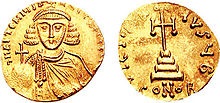
On June 3, 713 after the Opsikion troops revolt in Thrace in May, Byzantine emperor (since 711) Philippicus Bardanes (d. 713) is deposed and blinded (rather than de-nosed) during a drunken stupor in the Hippodrome, and replaced by his secy. Anastasius (Anastasios) II Artemius (d. 719), who becomes Roman Byzantine emperor #119 (until 715); he has Scholasticus, his new exarch of Ravenna (until 726) deliver a letter to the pope affirming his support for the Sixth Ecumenical Council of 680-1, which Bardanes had rejected.

On Feb. 23, 715 after expanding the caliphate into Spain, Transoxiana, Sind, and Byzantine lands, Umayyad caliph (since 705) Al-Walid I (b. 668) dies, and his younger brother Suleiman (Suleyman) (Arab. "peace") I bin Abd al-Malik (674-717) (son of Abd al-Malik) becomes Umayyad caliph (until 717); after getting confused as to whether the Hajj is supposed to be to Mecca's Qaabah or Jerusalem's Dome of the Rock, he goes to Mecca first, doesn't like it, then decides on Jerusalem, like his father?; seeing his chance, Byzantine emperor (since 713) Anastasius II sends an army led by Leo the Isaurian to invade Syria, ordering his fleet to anchor at Rhodes to destroy Muslim naval stores and block enemy approach; too bad, in May the Opsician troops mutiny, slay Adm. John, and proclaim low-born (really son of Tiberius III?) tax collector Theodosius (Theodosios) III (-754) (who tries to hide in the forest near Adramyttium until he is found and dragged out) as emperor; in Nov. they take Constantinople after a 6-mo. siege, causing Anastasius III to flee to Nicaea, submitting to the new emperor next year and becoming a monk in Thessalonica; Theodosius III becomes Byzantine emperor #120 (until Mar. 25, 717); on Aug. 11 iconophile (St.) Germanus I (634-740) becomes ecumenical patriarch of Constantinople (until 730), helping negotiate Anastasius III's surrender terms, then organizing a new council promoting Dyothelitism, the claim that Christ had two natures and two wills (2N2W).
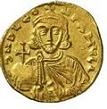
On Mar. 25, 717 emperor (since 715) Theodosius III is removed from the Byzantine throne by Commagene-born Leo III the Isaurian (Isaurican) (Syrian) (Konon) (685-741), who becomes Roman Byzantine emperor #121 (until June 18, 741), founding the iconoclastic Isaurian (Isurian) (Isaurican) (Syrian) Dynasty (ends 867), regenerating the empire; just in time too, because the Second Arab Muslim Siege of Constantinople begins in Aug. (until Aug. 15, 718).
In 726 after icons become widespread in Byzantine Christianity, Byzantine emperor Leo III the Isaurian and his son Constantine V issue an edict forbidding veneration of sacred images (icons) (based on Exodus 20:3-5), followed by another ordering their destruction, pissing-off the pop. and starting the Iconoclasm (Gr. "image breaking") War (ends 787); pressure from the Muslim pop. makes them do it?; meanwhile Leo III attempts to crack down on Italy and make it obey him rather than the pope as secular prince, levying heavy taxes on the great landowners, which really gets to Pope Gregory II, biggest landowner of all; meanwhile Liutprand of the Lombards attempts rapprochement with the papacy, with brief success.
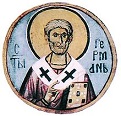
In 730 after iconophile patriarch of Constantinople (since 715) (St.) Germanus (634-740) writes a letter appealing to him, Pope Gregory II convokes a synod which condemns iconoclasm as heretical and excommunicates all iconoclasts incl. Byzantine emperor Leo III; too bad, the messengers carrying the papal letter are arrested in Sicily, and the letter never makes it to Constantinople; Leo III keeps the heat on, sending troops on search-and-destroy missions for sacred images hidden in lofts and wells and under beds, and removing the Roman province of Illyria (which later became Bulgaria) and S Italy (Sicily and Calabria) from papal jurisdiction, which the pope doesn't much object to, later proving to be a mistake when Bulgaria goes Greek Orthodox; Leo III deposes Germanus, and appoints fellow iconoclast Anastasios as ecumenical patriarch of Constantinople (until 754).

On June 18, 741 Byzantine emperor (since 717) Leo III the Isaurian (b. 685) dies, and his son Constantine V Copronymus (Gr. "name of shit") (718-75) succeeds him as Roman Byzantine emperor #122 (until Sept. 14, 775), continuing his iconoclast policies - throw them images into the what? In June 741 after Constantine V's accession, Armenian descent Byzantine gen. Artabasdos (Artavasdos) (-743) seizes the throne in Constantinople, causing Constantine V to flee to Amorion, abandoning the iconoclasm policy and restoring orthodox with the support of Pope Zacharias, crowning his wife Anna as Augusta and his son Nikephoros as co-emperor, and putting his son Niketas in charge of the theme of Armenia, securing the support of the themes of Thrace, Opsikion, and Anatolia.
In May 743 Artabasdus is defeated by Constantine V, who then defeats Nicetas; on Nov. 2 Constantine V enters Constantinople and captures Artabasdus, blinding his sons and exiling them to Chora Monastery on the city outskirts.

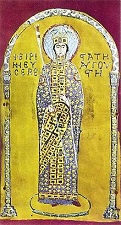
On Sept. 14, 775 emperor (since 741) Constantine V (b. 718) dies, and is succeeded by his eldest son Leo IV (the Khazar) (750-80) as Roman Byzantine emperor #123 (until June 18, 780) under the regency of his mother Irene the Khazar; an iconoclast, his wife (since 768) Irene of Athens (the Athenian) (Sarantapechaina) (752-803) is an iconophile, causing him to allow iconophile monks to retain images of the Theotokos, appointing iconoclast-turned-iconophile Paul IV the New of Cyprus as ecumenical patriarch of Constantinople in 780-4, causing the clergy to annoint him as "Friend to the Mother of God".
On Apr. 26, 776 Leo IV the Khazar sppoints his son Constantine VI as co-emperor, causing his five half-brothers incl. Caesar Nikephoros to revolt, which is quickly put down, and they are beaten, tonsured, and exiled to Cherson under guard.
In 778 Pope Hadrian I in a letter to Charlemagne first indirectly mentions the dubious document known as the Donation of Constantine (Constitutum Domini Constantini Imperatoris), dated Mar. 30 (of 315/317?), granting to the papacy "the city of Rome, and all the provinces, places and cities of Italy and the western regions" (the Papal States), claiming that Emperor Constantine I the Great resigned his title of emperor and donated it to the pope, who returned it to him with the implication that it is forever the pope's to give and take away; it also claims that Constantine I already gave the lands to the popes and that Pepin was merely restoring them; it is exposed as a forgery in 1440 by Lorenzo Valla; meanwhile the papacy tries to steal the imperial title from the Byzantine emperor and give it to the Frankish Carolingian kings by using the DOC as justification; the pope stops dating papal documents by the emperor's regnal year and begins using Charlemagne's; by next decade the popes begin sending official announcments of their election to the Frankish kings instead of the emperors.

Whadya like tonight, chicken? On Sept. 8, 780 emperor (since 741) Leo IV the Khazar (b. 750) dies from a poisoned crown from the Hagia Sophia (Irene's work?), and his 10-y.-o. son Constantine VI (771-804) becomes Roman Byzantine emperor #124 (until 797), with his mother ("Me, Myself and ?") Irene of Athens (the Athenian) (Sarantapechaina) (752-803) as regent; she soon becomes co-emperor, and rules with an iron fist in a velvet glove, restoring the practice of image worship.
On Sept. 24-Oct. 23, 787 the Second Council of Nicaea (Seventh Ecumenical Council) (last council with reps of the churches of Rome and Constantinople), called by Empress Irene supports her view of the veneration due to sacred images and icons, and regulates it while condemning iconoclasm, with the soundbyte: "It is for painters to execute; it is for the clergy to ordain the subjects and govern the procedure", claiming to end the Iconoclasm War (begun 726) and reunite the Eastern and Western Catholic Churches; too bad, her successor Emperor Nicephorus is an iconoclast, and ramps the war back up; the Nicean Church where the council is held is turned into a mosque after the Muslims conquer it in the 14th cent.


In 797 Empress Irene of Athens (the Athenian) (Sarantapechaina) (752-803) has her son Constantine VI blinded and imprisoned for life, becoming sole Byzantine emperor #125 (until 802) (the first woman in charge, and look, no Charles?), proposing marriage to Charlemagne as an ideal way to heal the East-West divide; having the Devil on the run, the Greek Church later canonizes her.

We'll lick your problems? In Oct. 802 as negotiations are underway to marry Charlemagne and reunite the empires, the patricians under iconoclast finance minister Nicephorus I (760-811) revolt and depose Empress/Emperor (since 797) Irene, then exile her to the isle of Lesbos; he is crowned as Roman Byzantine emperor #126 (until July 26, 811), reviving the Iconoclast War and founding the Nikephorian Dynasty (ends 813).


On July 26, 811 after Byzantine emperor (since 802) Nicephorus I launches a spring campaign against the Bulgars and sacks Pliska again, he is ambushed and KIA in Varbitsa Pass, becoming the first Roman emperor KIA in battle since Valens; he is succeeded on July 26 by his son Staurakios (Stauracius) (-812) as Roman Byzantine emperor #127, who is severely wounded in the same battle and is forced into retirement by his brother-in-law Michael I Rhangabe (770-844), who on Oct. 2 becomes Roman Byzantine emperor #127 (until June 22, 813), elevating his son Theophylactus (Theophylaktos) (793-) to co-emperor on Dec. 25 (until July 11, 813), going on to junk Nicephorus I's high tax program, reduce imperial income, and generously distribute money to the bureaucracy, army, and orthodox party in the Church, persecuting iconoclasts; Nicephorus' skull is made into a drinking cup for Khan Krum? - is that considered a sacred image?
On Jan. 11, 812 Byzantine emperor (since 811) Staurakios dies of wounds incurred at the Battle of Pliska. In 812 Thrace and Macedonia are overrun by the Bulgars, who take the key Byzantine fortress of Mesembria in Thrace, and now control a great part of the Balkan Peninsula; now that they are beaten and might need their help, Byzantine envoys from Michael I Rhangabe formally recognize Charlemagne as Latin emperor and augustus - are you comfortable with that sort of public embarrassment?

On June 22, 813 Khan Krum's striving, winning Bulgarians move S into Thrace and win another V against a 10-times-bigger Byzantine army at the Battle of Versinikia, causing the remnants to flee to Constantinople, after which emperor (since Oct. 2, 811) Michael I Rhangabe is deposed and exiled, and Armenian gen. Leo V the Armenian (775-820) (who deserted him at Versinicia to set him up?) becomes Roman Byzantine emperor #128 (until Dec. 25, 820), starting the Second Iconoclasm (ends 842); when the Bulgars arrive they find the city walls impregnable, spending some time taunting the pop. by sacrificing (burning) Byzantine captives and animals to their god Tantra while they watch, after which Krumball is offered a parley on the shore of the Golden Horn, which turns out to be an assassination trap, pissing him off and causing him to decimate the city's suburbs, incl. churches and monasteries, followed by Selymbria, Heraclea, Doanin, Rhaedestus, Aprus, and Adrianople, whose pop. he takes into slavery; meanwhile Leo V ambushes him at the Battle of Leo's Hill near Mesembria, sending part of his army out on the plains while he and the rest hide behind a hill, then springing into the battle, mowing down every Bulgar they can, incl. children. On Dec. 25, 813 Leo V the Armenian crowns his son Symbatios as co-emperor Constantine (until 820).

On Apr. 13, 814 after beginning a winter campaign with a first assault of 30K men penetrating S to Arcadiopolis and taking 50K slaves, followed by a 2nd assault in the spring headed straight for Constantinople, Khan Krum (canned crumbs?) dies, and his son Omurtag (Omortag) (the Builder) (-831) becomes khan of the First Bulgarian Empire (until 831), carrying on his daddy's war with the Byzantine Greeks, and getting his butt kicked, concluding a 30-year peace with them, then returning to Adrianople and the fortress of Mesembria; preferring lap dances to pillaging and rape, Omurtag begins building palaces in Pliska, and founds the new capital city of Preslav (Presthlava) (until 971), known for stone inscriptions in Greek.
In 815 Byzantine emperor Constantine (Symbatios) presides over a church council in Constantinople which reinstates the ban on veneration of icons.

On Dec. 25, 820 (a.m.) iconoclast emperor (since 813) Leo V the Armenian (b. 775) is hacked down while listening to Christmas hymns at the palace Chapel of St. Stephen by a gang of assassins disguised as monks working for his jailed (for conspiracy) military cmdr. Michael II (the Amorian) (the Stammerer) (770-829), although they mistakenly attack the officiating priest first, giving him time to grab a heavy cross from the altar and put up a fight first; after being rescued from the dungeons with his leg irons still on, Michael II is crowned as Roman Byzantine emperor #129 (until Oct. 2, 829), going on to exile Leo's mother and wife Theodosia to monasteries on the Princes' Islands, castrate and tonsure his four sons (incl. co-emperor Symbatios) and exile them to Prote as monks, and crown his son (by wife Thekla) Theophilos (Theophilus) (813-42) as co-emperor; the 1-emperor Syrian Dynasty ends, and the Amorian (Phyrgian) Dynasty begins (ends 867).
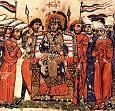
On Oct. 2, 829 emperor (since Dec. 25, 820) Michael II (b. 770) dies of a kidney ailment (the first Byzantine emperor in half a cent. to die peacefully in his bed), and his Armenian descent son Theophilos (Theophilus) (813-42) (Gr. "lover of God") becomes Roman Byzantine emperor #130 (until Jan. 20, 842), 2nd of the Phyrgian Dynasty, and last of the iconoclastic smashmouth emperors, going on to restore the U. of Constantinople under new rector Leo the Mathematician/Philosopher (790-870), and foster the new miniscule hand over the larger uncial while increasing the number of copyists' workshops (scriptoria). King Egbert conquers Mercia and its chief town of London, driving Wiglaf from the throne, then marches N and secures the nominal submission of Northumbria without a battle, obtaining recognition as overlord. Emperor Louis I drops Lothar's imperial title and sends him off to Italy.
In 831 Byzantine emperor (since 829) personally leads his armies in war against the Arabs in Cilicia, capturing Tarsus, then returning to Constantinople before being defeated in the fall in Cappadocia.
In 832 Caliph Al-Ma'mun invades Egypt; meanwhile the Byzantines are again defeated in Cappadocia, causing emperor Theophilos to sue for peace, offering 100K gold dinars and 7K POWs, which is accepted after Al-Ma'mun's death next year; meanwhile the Byzantines again persecute the icon worshipers.
In 834 Byzantine emperor Theophilos gives asylum to a group of refugees from the east, incl. a Persian named Nasr (Nasir) (Nusayr), who is baptized as Theophobos (Theophobus) (-842), marrying Theophilos' aunt Irene and becoming a gen.
On July 22, 838 the Abbasid Muslim Arabs under Caliph Al-Mutasim defeat the Byzantines under Emperor Theophilus at the bloody Battle of Dazimon (Anzen) in modern-day Dazman, Turkey; Armenian gen. Manuel is killed, and the Byzantine army retreats to Amaseia; on Sept. 23 after 55 days the Siege of Amorion (Amorium) in Asia Minor (largest Byzantine city in Asia Minor, and home of Theophilus' line) ends in the city being betrayed by an escaped Muslim slave who told them about a weak spot in the wall, and it is razed and the pop. slaughtered, incl. the 42 Martyrs of Amorion (Amorium), Byzantine officers and notables who are executed after refusing to convert to Islam, shocking the Byzantine pop. into singing mourning songs for cents.; the remainder are auctioned off as slaves in batches of five and ten.

On Jan. 20, 842 after having his Persian-born gen. Theophobos executed to secure the succession, emperor (since Oct. 2, 829) Theophilus dies of dysentery contracted on the Arab campaign, and his infant son Michael III (the Drunkard) (840-67) becomes Byzantine emperor #131 (until Sept. 24, 867) under the regency of Theophilus' widow Theodora, who restores the veneration of images once and for all with a synod decision on Feb. 19, ending the Iconoclast War (begun 726); pro-icon man Methodius succeeds iconoclast Grammatikos as ecumenical patriarch (until 847), after which the Orthodox celebrate the first Sun. of Lent as "Kuriaki tis Orthodoxias"; Empress Theodora begins persecuting the Paulician Christians - ugly is the new pretty? Meanwhile the Muslims capture Messina in Sicily from the Byzantines (until 1061), and prepare to attack Rome.
In 865 Swedish Rus Vikings row down the Dnieper River and across the Black Sea, sieging Mickelgard (Constantinople), which is saved by a storm which the inhabitants attribute to the Virgin? - did you say Valhalla? After the Byzantines put him under pressure to counter a possible German-Roman conversion attempt, pagan Bulgarian Khan Boris I first entertains Muslim envoys and contemplates conversion to polygamy-friendly Islam, but is finally converted to Greek Orthodox Christianity after being pussy-whipped by a Byzantine princess (whom he marries), and makes it the official religion of the Bulgarians by 870, forcing his subjects to get baptized and reinvent themselves, starting with family relationships, giving up polygamy (with a max. of 3 divorces), and then reforming the govt. along Byzantine lines - Natasha, Rocky and Bullwinkle too?

On Sept. 23/24, 867 Byzantine emperor (since 842) Michael III (b. 840) is murdered in a drunken stupor in his bedchamber by orders of Basil I the Macedonian (811-86), who also murders PM Caesar Bardas, and becomes Byzantine emperor #132 (until Aug. 2, 886), ending the Isaurian Dynasty (founded 717) and founding the Macedonian Dynasty (ends 1081); he goes on to compile the Basilian Code (Rule), and resume Leo III the Isaurian's campaign to force conversion of Jews; on Nov. 23 after refusing him the sacraments and denouncing him as a murderer, Basil I calls a church council that deposes, insults, and banishes Photius, then restores Ignatius as patriarch of Constantinople (until 877) - don't get mad get even?
About 880 Patriarch Photius of Constantinople compiles the Nomocanon, a relatively small set of homogeneous ancient church regulations, which are pretty much all the Eastern Orthodox Church gets, while the Western Roman Catholic Church just can't pass enough laws and ends up with a wall full?


On Aug. 29, 886 Byzantine emperor (since 867) Basil I (b. 811) dies after a wild boar hunting accident, and his 2nd son (by Eudokia Ingerina) Leo VI (Sophos) (the Wise) (866-912) becomes Roman Byzantine emperor #133 (until May 11, 912, with his younger brother (3rd son of Basil I and Eudokia Ingerina) Alexander III (870-913) continuing as co-emperor (since 879); Photius is again deposed and banished, and Basil I's younger brother Stephen I (867-93) becomes patriarch of Constantinople (until 893), but Rome refuses to recognize him; Leo VI becomes known for his erudition, earning his appellation.
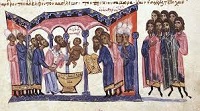
On Mar. 1, 901 Byzantine emperor Leo VI the Wise appoints his Italian-born friend Nicholas I Mystikos (Mysticus) (852-925) as ecumenical patriarch of Constantinople (until Feb. 907).
On July 29, 904 after they give up on attacking Constantinople, Salonika (Thessalonica) is surprise-attacked by Muslim pirates led by Leo of Tripoli, who sack it for a week and take 22K POWs, ransoming most of them later, becoming one of the greatest disasters of the cent. for the Byzantine Empire.
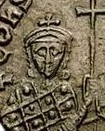
On Jan. 9, 906 after he fails to sire a son, Byzantine emperor Leo VI the er, Wise marries his mistress Zoe (Gr. "life") Karbonopsina (Carbonopsina) (Gr. "coal black eyes") (885-920) (same as Ochi Chornie in Russian) after she had given birth to Constantine VII Porphyrogenitus on Sept. 2, which is uncanonical in Eastern Orthodoxy, plus Patriarch Nicholas I Mystikos after baptizing Constantine VII forbade him from marrying a 4th time, causing Leo VI to recruit priest Thomas to perform the marriage and threaten to remove Nicholas, who defrocks Thomas but flops and recognizes the marriage, which doesn't stop Leo VI from replacing him in 907 after apologizing to Christ for marrying too many women.
In Feb. 907 Byzantine emperor Leo VI the Wise fires patriarch (since Mar. 901) Nicholas I Mystikos and replaces him with Euthymius I Syncellus (834-917), who becomes ecumenical patriarch of Constantinople (until May 912).
In 907 Varangian Rus leader Oleg of Kiev extorts a 1-sided trade agreement with the Byzantines, followed by a 2nd more lavish one in 911, making the Byzantines give them free supplies and baths coming and going, with the Byzantines requiring them to enter Constantinople in groups of 50 unarmed, live in the St. Mamas quarter, and be on commercial business bringing merchandise and refrain from violence.

On May 11, 912 Byzantine emperor (since 886) Leo VI the Wise (b. 866) dies, leaving his younger brother Alexander III (870-913) as sole emperor, becoming Roman Byzantine emperor #134 (until June 6, 913), becoming the first Byzantine emperor to use the term "autocrator" on his coinage, immediately dismissing most of Leo VI's advisors incl. Adm. Himerios and Patriarch Euthymios and reinstating Patriarch Nicholas Mystikos (until May 15, 925), going on to become known for laziness, drunkenness, and lechery, and making sacrifices to a golden boar in the Hippodrome to cure his impotence; his 7-y.-o. nephew Constantine VII Porphyrogenitus (905-59), son of Leo VI and his 4th wife Zoe Karbonopsina also claims the throne, causing him to lock Zoe in a nunnery; his nickname "born of porphyry" is propaganda to advertise how he was born in the Purple Room of the imperial palace, reserved for royal heirs (which legitimizes him even though a 4th marriage is uncanonical and makes him illegitimate otherwise); Euthymios doesn't give up, launching a war with Mystikos - sounds like Madonna's brother?

In 912 Prince Oleg dies, and Prince Igor I (-945) becomes Varangian ruler of Kiev (until 945); he and his mentor Grand Prince Oleg sail with a large army towards Constantinople, raiding the villages along the Bosporus and obtaining a treaty giving Russian merchants privileges along with shiploads of bribes for their "druzhina" (friends).
On June 6, 913 after provoking a war with Simeon I of Bulgaria by refusing to send tribute on his accession, Byzantine emperor Alexander III (b. 870) dies of exhaustion after a game of polo, leaving 8-y.-o. Constantine VII the Purple Room Kid as sole possessor of the purple under a 7-man regency led by Constantinople Patriarch (901-6, 912-925) Nicholas I Mystikos; meanwhile Simeon I of Bulgaria invades Thrace and Macedonia, but fails to take Constantinople, and in Aug. Mystikos negotiates a peace, crowning Simeon I emperor of the Bulgarians in a makeshift ceremony, with Simeon trying to dress it up with presents to young emperor Constantine VII along with promises to marry one of his daughters to him, actually plotting to take the Byzantine crown for himself.
In Mar. 914 with support from magistros John Eladas (-914), Leo VI's widow Zoe Karbonopsina overthrows and replaces patriarch Nicholas I Mystikos as leader of the regents, removing the rest and ruling alone, then revoking the peace agreement with Simeon, provoking a new war.
In 915 Byzantine troops defeat an Arab Muslim invasion of Armenia and negotiate a peace, freeing the Byzantines to campaign against the Bulgarians, who have raided deep into Thrace and captured Adrianople.
On Aug. 20, 917 after the Patzinaks are incited (bribed) by Byzantine empress Zoe Karbonopsina to invade and occupy Bulgarian Wallachia to slow Simeon I down, complete with transportation by the imperial free, which just makes him madder, sending two small armies to deal with them, his 60K-man main army kicks Byzantine Greek butt under gens. John Bos and Leo Phocas the Elder (Zoe's favorite) at the Third Battle of Anchialus (Achelous) (Anchialos) (708, 763) near Pomorie on the Bulgarian Black Sea Coast, killing 60K of 62K Byzantines, 75 years later Byzantine historian Paulus Deakon observes tens of thousands of skeletons there; meanwhile after fleeing back to Constantinople with the Bulgarians in pursuit, and being defeated again outside the city, white-as-a-sheet Byzantine empress Zoe Karbonopsina warns the Bulgarians against attacking the Queen City of Constantinople because their "commander in chief" Virgin Mary will destroy him, and proposes a peace treaty, which is accepted, and Simeon enters the city in triumph and is crowned as "tsar of all Bulgarians and Greeks" (2nd time), forcing the Byzantines to acknowledge equality of the two empires; he also demands that his daughter be betrothed to Zoe's son Constantine, which pisses her off, causing her to refuse and ally with Serbia and Hungary against him.

On Mar. 25, 919 after her crushing defeats by the Bulgarians weakens her grip on power, poorly-educated but military-savvy Armenian Adm. Romanos (Romanus) I Lecapenus (Lecapenos) (Lekapenos) (870-948) (whose father guardsman Theophylaktos "the Unbreakable" Romanos was born in Lakape) seizes Boukoleon Palace and removes Zoe Karbonopsina from power and puts her in a convent, then in Apr. marries his daughter (by Theodora) Helena Lekapene (Lecapena) (910-961) to Byzantine emperor Constantine VII, takes the title of Caesar on Sept. 24 along with the title "father of the emperor", and on Dec. 7 is crowned senior emperor, becoming Roman Byzantine emperor #135 (until 944), really ruling alone; Romanos I promotes his sons Christopher Lekapenos (Lecapenus) (eldest), Stephen Lekapenos (Lecapenus) (-963) (middle), and Constantine Lekapenos (Lecapenus) (youngest) to co-emperors; meanwhile the Byzantines extend their empire to the Euphrates and Tigris Rivers - just imagine, Saddam Hussein will one day rule here too?
In 925 Duke (since 910) Tomislav (-928) becomes king of Croatia (until 928), accepting his crown from the pope, and ruling over the territory as far S as Montenegro, except for the Byzantine-controlled coastal towns, allying with the Byzantines against the Bulgarians, expanding into the Duchy of Pannonia while fighting with the Hungarians.
In 944 Grand Prince (since 912) Igor I of Kiev (-945) attacks Constantinople with a fleet of 1K ships, and the smaller Byzantine fleet kicks their butts with Greek fire, setting most of the Russian fleet ablaze and causing them to turn tail and return to Kiev - where'd you get that sunburn? On Dec. 16, 944 Byzantine emperor (since 920) Romanos I Leucapenus is deposed by his sons Stephen and Constantine after his guilt over usurping the throne from Constantine VII makes him refuse to elevate them, and they force him to become a monk on the Prince's Islands.


In Jan. 945 after Romanus I's sons Stephen and Constantine threaten the throne of Constantine VII, the pop. revolts, and they are sent to join their father in exile in Samothrace, after which Constantine VII Porphyrogenitus (905-59) reigns alone as Roman Byzantine emperor #136 (until Nov. 9, 959), negotiating another commercial treaty with Grand Prince Igor of Kiev, who soon dies fighting rebels in Dereva, leaving his wife Princess (St.) Olga of Kiev (890-969) in charge as regent for her boy son Sviatoslav I (until 964), going on to wipe out the rebels to the last man and teaching him to chuck spears at them, and consolidate Kiev's control over cities as distant as Novgorod; the commercial treaty mentions luxury items they want from the Byzantines incl. silk; Constantine VII requires pesky untrustworthy antichrist Jews testifying in Christian courts to take the humiliating Oath More Judaico, which continues in use in Euro courts until the 20th cent.

In 957 Russian Grand Princess (St.) Olga of Kiev (890-969), wife of dead Grand Prince Igor I visits Constantinople, and is so wowed by the churches that she becomes a Christian and is baptized in Hagia Sophia by the patriarch of Constantinople with emperor Constantine VII Porphyrogenitus as her baptismal father, taking the name Helena after Constantine I the Great's mother; meanwhile her pagan son Sviatoslav I holds out; when Constantine VII proposes marriage to her, she replies that as her baptismal father that would be incest, causing to reply "Olga, you have outwitted me".

On Nov. 9, 959 Byzantine emperor (since 905) Constantine VII (b. 905) dies, and his son Romanus II (938-63) becomes Roman Byzantine emperor #137 (until Mar. 15, 963), banning his mother Helena Lekapene from court and sticking his five sisters into convents, going on to live a life of pleasure while letting his chief eunuch Joseph Bringas (-965) and wife Theophano run the govt.
In 960 Byzantine emperor Romanus II begins the reconquest of Crete, held since 823 by the Saracens (finished 961), sending a fleet of 12.3K ships with 27K oarsmen and marines and 50K troops under his brother Adm. Nikephoros Phokas (912-69).
In 961 after a 9-mo. siege of Sandax, the Byzantines under Nicephorus II Phocas reconquer creaky Crete (largest island in the Mediterranean) from the Arabs (until 1204), and reestablish Christianity there, building the Orthodox Church of St. Titus, housing the skull of St. Titus, a disciple of St. Paul and the first bishop of Crete; after the Turks recapture Heraklion in 1645, the skull is taken to Venice, and not returned until 1966.
In 962 after he gets too used to annual raids into Byzantine-held Anatolia, the Byzantines under Nikephoros Phokas liberate Cilicia and Aleppo from Sayf al-Dawla, emir of Aleppo, sacking his palace and capturing 390K silver dinars, 2K camels, and 1.4K mules; meanwhile after the Magyars raid Bulgaria yet again, Byzantine emperor Romanos II's brother Leo Phokas and Marianos Argyros lead an army that stops their incursions into the Byzantine-held Balkans.

On Mar. 15, 963 emperor (since 959) Romanus II dies unexpectedly after a long hunting expedition (poisoned by his wife Theophano?), with Joseph Bringas and their mother Theophano as regents for underage sons Basil II the Young Porphyrogenitus (958-1025) and Constantine VIII (960-1028), after which Theophano begins plotting with army CIC Nicephorus (Nicephoros) (Nikephoros) II Phocas (Phokas) (912-69), who arrives in Constantinople in Apr. to celebrate a triump for his conquests in Syria, but suspects Bringas is plotting against him and takes refuge in the Hagia Sophia, gainng the support of Patriarch Polyeuctus; on July 2 Phocas' troops proclaim him emperor and marches on Constantinople, and after the populace supports them they overthrow Joseph Bringas, who is exiled to the Asekretis Monastery in Pythia (near Nicomedia); on Aug. 16 Phocas becomes Roman Byzantine emperor #138 (until Dec. 11, 969), marrying Theophano and going on to take on the Muslims and Bulgarians, becoming known as "the White Death of the Saracens"; meanwhile Theophano hooks up with new lover gen. John Tzimiskes (925-76), Phocas' nephew.
In 965 the Byzantine Empire recovers Cyprus and Cilicia.

In 969 the Byzantines capture Antioch and the N Syrian coast (until 1084); the Hamdanid emirate of Aleppo contracts to the city, and its hinterland becomes a Byzantine satellite by the end of the cent.; on Dec. 10/11 emperor (since 963) Nicephorus II Phocas (b. 912) is murdered in his bedchamber by assassins working for his wife Theophano's lover John I Tzimisces (925-76), who succeeds him as Roman Byzantine emperor #139 (until Jan. 10, 976), proving a good military leader as well as lover?; Nicephorus II leaves the military tactics treatise Praecepta Militaria.
In Mar. 970 after invading and sending a message "I come upon you", the 50K-man Russian army of Sviatoslav I of Kiev is defeated by a 12K-man Byzantine Greek army under Bardas Skleros (Sclerus) at the Battle of Arcadiopolis (60 mi. W of Constantinople), and driven out of the Balkans.
In 970 John I Zimisces transplants a colony of Paulicians and Jacobites from the Chalybian Hills in Armenia to Mt. Haemus in Thrace, where the Paulicians gain control of Philippopolis, and establish villages and castles in Macedonia and Epirus, later spreading to Albigeois in S France.
In Apr. 971 Byzantine emperor John I Zimisces attacks the rushing Russians by land and sea, takes and destroys Little Preslav, then attacks Dorystolum (Dristra) (Silistra) on the Lower Danube River, blockading it until they skoot out of Bulgaria; Tsar Boris II is captured along with his family, and forced to abdicate, and the Bulgarian patriarchate is abolished, scaring the Byzantines into sending an army against him.

On Apr. 14, 972 Otto I's son Otto II marries Byzantine princess Theophano (Theophana) (Theophania) (Theophanu) (956-91), niece of John I Tzimiskes, who goes on to introduce Greek language and culture to his court.


On Jan. 10, 976 after announcing plans to curb the power of landowners, emperor (since Dec. 11, 969) John I Tzimisces (b. 925) dies (poisoned?), and brilliant but short and stocky Basil II (the Young) (Porphyrogenitus) (Bulgaroktonos) (Bulgaroctonus) (the Bulgar Slayer) (958-1025) (son of Romanus II) becomes Byzantine emperor #140 (until Dec. 15, 1025), fighting a civil war for over a decade to solidify his power; under him the empire reaches its height of power and last golden age, cementing a marriage alliance with Vladimir of Kiev, and esp. enjoying the kicking of Bulgar butt along with a little Fatimid and Armenian butt, travelling with his men to the field and eating their rations to show he's one of them; until 1025 he shares power with his younger brother (tall and slender, but a pampered snob?) Constantine VIII (960-1028), who fritters away all he gains?; being too young to want to mess things up, Basil at first devotes himself to his studies, letting the eunuch chief minister (947-85) Basil Lekapenos (Parakoimomenos) (Nothos) (the Bastard) (925-85) (illegitimate son of Romanus I Lekapenos, and pres. of the senate since 945) run things, and when he graduates magnum cum laude he cures the problem John I and Nicephorus II had with being able administrators, firing and exiling Basil in 985; meanwhile the Bulgarians begin raiding Byzantine lands, becoming a thorn in their side until 1014-18.
In 989 Vladimir I of Kiev strikes a deal with Byzantine emperor Basil II to evacuate Chersonesus, and supplies 6K soldiers (organized later into the Varangian Guard) to help him kick the butt of the last great rebel Asia Minor landowner Bardas Phokas (-989), who is KIA on Apr 13; meanwhile newly-PC Duke Vladimir I of Kiev is baptized and married in the Crimea to Basil II's younger sister (St.) Anna Porphyrogeneta (963-1011) (who had already refused a proposal from Hugh Capet because Franks as well as Russians are barbarians, but since his entire pop. goes along with the deal, she smells teen sainthood and lowers herself for Christ?); he also promises to divorce all umpteen of his pagan wives, but eh?; Anna dies childless; boss Basil now takes care of remaining great landowner Basil Lekapenos (925-989) and begins a systematic program of dissolution of the huge estates in Asia Minor, making him popular with the people.

On Dec. 15, 1025 after restoring much of S Italy to his control, and appointing Alexius Studites (-1043) as ecumenical patriarch of Constantinople (until 1043), Byzantine emperor (since 963) Basil II (b. 958) dies while planning an expedition to recover Sicily, leaving the Byzantine Empire the dominant power of the Balkans and Middle East, with secure frontiers along the Danube, the Armenian highlands beyond the Euphrates; dying without leaving a male heir, his younger brother (his complete opposite, as tall and graceful as he was short and stocky, a luxury lover who would never live with the troops and subsist on their rations, and who avoids state business while appointing cruddy officials, who soon drop Basil's land reform laws and let the wealthy land-owning aristocrats go back to decentralizing authority (like in the Frankish Carolingian monarchy) Constantine VIII (960-1028) becomes sole Roman Byzantine emperor #141 (until Nov. 11, 1028), presiding over a final downturn in Byzantine power as the Muslim Seljuk Turks begin contracting them and softening them up for the Muslim Ottoman Turks - pass the olives and wine?


On Nov. 15, 1028 Constantine VIII (b. 960) dies childless, and 60-y.-o. Romanus III Argyrus (Romanos III Argyros) (968-1034) becomes Byzantine emperor #142 (until Apr. 11, 1034), marrying Constantine VIII's 50-y.-o. 3rd daughter Zoe (Gr. "life") Porphyrogenita (978-1050), becoming #1 of her three emperor husbands (Michael IV in 1034-41, Constantine IX in 1042-50), soon turning Romanus III off with her infertility and hooking up with courtier Michael IV the Paphlagonian (1010-41) and plotting to take the throne - talk about late bloomers? Power the ultimate aphrodisiac?
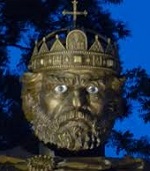
The mother and child reunion is only a motion away, or It's time for a good spring cleaning of loose burgers? On July 29, 1014 Byzantine Emperor Basil II the About-to-Be-Bulgar-Slayer outmaneuvers "invincible" tsar (since 997) Samuel (Samuil) I (-1014) and separates him from his force, then scores a big V at the Battle of Balathista (Belasitsa) Kleidion (Klidi) Pass on the Struma River near Serres (Seres) (Serrai) (Serai) on the N end of Lake Akihinou about 40 mi. NE of Salonika, gaining the W part of Bulgaria; Bulgar Slayer Basil II takes 15K POWs, blinds 99 out of every 100 of them, then blinds one eye of the 100th so he can lead the others home, sending them back to the Bulgarian capital of Ochrid (Ohrida) (Ochrida) (Achrida) (modern-day Ohrid) on Macedonia Lake in SW Macedonia (known for having 365 churches, causing it to be known as "the Jerusalem of the Balkans"), where shocked Samuel faints at the er, sight, and dies two days later on Oct. 6 of sorrow (stroke?) at Prespa in Macedonia, ending his 34-year reign; Basil II gives thanks to the Virgin Mary in Athens, then celebrates a triumph in Constantinople; Samuel's son Gabriel (Gavril) Radomir (Romanus) (970-1015) becomes tsar of Blind Bulgaria (until Aug. 1015), and tries to make peace, conceding the spoils and the Byzantine monopoly on the silk trade - where's my quill, I can't find it?
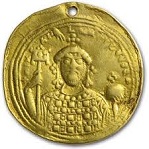
On Apr. 11, 1034 emperor (since Nov. 15, 1028) Romanus III (b. 968) is murdered in his bath after persecuting the Monophysites of Syria and causing thousands to flee to Muslim territory (later welcoming the Seljuk advance), and low-born epileptic Michael IV the Paphlagonian (1010-41) becomes Roman Byzantine emperor #143 after Zoe marries him (her 2nd of three marriages) and jockeys for his bootstrap election.
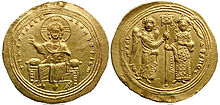
On Dec. 10, 1041 after putting his able brothers in high office, and resigning and becoming a monk, Byzantine emperor (since Apr. 11, 1034) Michael IV (b. 1010) dies right after taking his oaths, and his nephew and adopted son Michael V Kalaphates (the Caulker) (1015-42) becomes Byzantine emperor #144 (until Apr. 20, 1042), banishing his adoptive mother Zoe on Apr. 18/19 to become sole emperor), causing a popular revolt, with a mob surrounding the palace and demanding her restoration, causing her to depose him on Apr. 20; he flees to the Stoudion Monastery, but is dragged out, arrested, blinded, and castrated, dying as a monk on Aug. 24; Zoe Porphyrogenita (978-1050) becomes sole Roman emperor until next Apr. 19, when her younger sister Theodora II (980-1056) becomes co-emperor, causing Zoe to bed-hop again, marrying 3rd hubby Constantine IX next June to get her to step down, only to see Michael V exile him to Mytilene in Lesbos - anything to get away from that bitch Zoe?
In the 1050s Roman Catholic Europe begins to pass the Greek Orthodox Byzantine Empire and the Muslim World, and to politically penetrate the Mediterranean world, ending the early Middle Ages; France and England begin forming centralized nat. govts. which check or reduce the powers of independent feudal barons, while Germany goes the other way, developing territorial lordships supported by the German emperors.

In June 1050 Byzantine empress (since Nov. 15, 1029) Zoe Porphyrogenita (b. 978) dies, leaving her 3rd and last hubby (since 1042) Constantine IX Monomachus (Monomachos) (1000-55) to return from exile in Lesbos and becomes sole Roman Byzantine emperor #145 until Jan. 11, 1055), with Zoe's sister Theodora II waiting in the wings; Constantine IX goes on to support the mercantile classes and intellectuals over the military aristocracy, pissing them off, and living an extravagant life of pleasure with many mistresses while endowing the Nea Moni Monastery in Chios, the Mangana Monastery et al., becoming the emperor to preside over the Great Schism.

900 years before Joseph McCarthy a demogogue accuses the Church of infiltration by agents of an evil power, and it ends up with no head? On July 4, 1054 Chinese astronomers note a "guest star" in the constellation Taurus, the star Zeta Thauri in the Crab Nebula (later known as a source of gamma rays); it is visible in daylight for 23 days and at night for two years; American aborigines see it, along with Arab astronomers, but no European records it - maybe this is a sign that a new country will be born on July 4 halfway to China in America, which will never be ruled by the ever-split Church? On July 16, 1054 after Byzantine patriarch (since 1043) Michael Cerularius disputes Pope Leo IX's claim to jurisdiction in S Italy over the Norman takeover, and lifestyle disputes over unleavened bread (azymes), celibate clergy, Saturday fasts et al. reach the breaking point, Constantiopole Studion monk Niketas Stethatos (Nicetas Pectoratus) writes a bestseller, not stressing that, but instead attacking the Roman Catholics on theoretical lines, making a big thing of their addition in 633 of the 2-word "filioque" clause ("and from the Son") to the 381 First Council of Constantinople Creed, claiming it denies the supremacy of the Father in the Trinity (even though filio and non-filio churches had coexisted peacefully up till now?); after reading it and blowing his top, patriarch Michael Cerularius and his whole church are excommunicated by deceased Pope Leo IX's delegate, Benedictine cardinal Humbert of Silva Candida (Moyenmoutier) (1000-61) (Moyen Moutier), and he responds by excommunicating the pope and the entire Roman Catholic Church, and the hard-hearted Second Great Schism (last) of the churches of Rome and Constantinople begins (ends 1965?); from now on the Greek Orthodox Church, led by the ecumenical patriarch of Constantinople rejects the supremacy of the Roman Catholic pope and the use of the word "purgatory", and only accepts the authority of its first seven ecumenical councils; Orthodox priests are permitted to marry, but only those from celibate monastic orders can become bishops (enjoying all the hos they can buy?); the major patriarchates are Constantinople, Alexandria, Antioch, and Jerusalem, with the Church of Russia added in 1598 - if you start me up, if you start me up I'll never stop?

On Jan. 11, 1055 Byzantine emperor (since June 11, 1042) Constantine IX (b. 1000) dies after leaving the empire a mess and weakening the military, and after overpowering his counsellors (who try to get him to name Bulgarian duke Nikephoros Proteuon on his deathbed) by coming out of the convent and convening the Senate and have the imperial guard proclaim her emperor, Theodora (Gr. "gift of God") II (980-1056), younger sister of Zoe rules alone as Roman Byzantine emperor #146 (until Aug. 31, 1056), while Greek patriarch of Constantinople (1043-58) (author of the Great Schism) Michael I Cerularius (Caerularius) (Kerularios) (1000-58), pissed-off at her appointment of clerics and centralization of power tries in vain to get her to marry to ensure the succession.

On Aug. 31, 1056 emperor (since Jan. 11, 1055) Theodora (980) dies after selecting the elderly finance minister Michael VI Bringas Stratiokitos (Stratioticus) ("the Warlike") (Gerontas) ("the Old") (-1059) (relative of courtier Joseph Bringas) as Roman Byzantine emperor #147 (until Aug. 31, 1057), who beats off a challenge by Constantine IX's nephew Theodosios Monomachus (Monomachos) only to alienate the military by restoring the rank of ex-gen. Nikephoros Bryennios (Nicephorus Bryennius) but refusing to restore his wealth and estate, then sending him to Cappadocia with a 3K-man army, which he turns against him.

On Aug. 31, 1057 after he loses the Battle of Petroe (Hades) on Aug. 20, and his lame attempts to negotiate using Michael Psellos as negotiator are ended by a riot in Constantinople, Byzantine emperor (since 1056) Michael IV (-1059) is deposed by Patriarch Michael Cerularius of Constantinople (so powerful now that he has become a kingmaker), who cuts off his hair and imprisons him in a monastery; on Sept. 1 after being proclaimed by his army on June 8, Isaac I Comnenus (Comnenos) (1005-61) of the military family of Comnenus (Komnenos) becomes Roman Byzantine emperor #148 (until Nov. 22, 1059), founding the Comnenus (Komnenos) Dynasty, which rules from 1081-1185, but for now Cerularius is the real emperor, proving it by wearing purple shoes; Isaac attempts to reform the finances, abolishing sinecures, etc., but although he saves the empire he's too old for the job and soon abdicates; he becomes the only Byzantine emperor to strike a military pose bearing a naked sword on coinage.

In Aug. 1059 the Treaty of Melfi is signed by Pope Nicholas II and the Normans, making Robert Guiscard and Richard of Aversa, prince of Capua into papal vassals with the power to take S Italy from the Greeks, and Sicily from the Muslims; Apulia is given to Robert Guiscard and raised from a county to a duchy by the pope - you're the apulia of my eye? On Nov. 22 after a successful campaign against Andrew I of Hungary and the Pechenegs that results in a peace treaty with Hungary, during which he is nearly struck by lightning while leaning against a tree, then grows ill, attributing it to God's displeasure, whipped on by Michael Psellos, Isaac I Comnenus abdicates and retires to a monastery, and on Nov. 24 is succeeded by effete intellectual anti-military snob finance official Constantine X Ducas (Doukas) (1006-67), who becomes Roman Byzantine emperor #149 (until May 22, 1067), giving free rein to civil and church officials while treating the military with suspicion, bloating its payroll with court officials, replacing standing soldiers with mercenaries, failing to repair frontier fortifications, and attempting to raise taxes, pissing-off the pop. while fatally weaking Byzantine defenses by disbanding the local militia of 50K Armenian troops just as the Seljuk Turks are advancing from the E, going on to lose most of Byzantine Italy to the Normans under Robert Guiscard except Bari.
The anchovy-pizza issue begins? In 1060 the Normans under brothers Robert Guiscard (1016-85) and Roger Guiscard (1031-1101) capture Rheggio, complete the conquest of Calabria, and begin the conquest of Sicily (finished 1090), which is controlled by the Saracens and Byzantines; the complete Muslim rule of Sicily that began in 965 ends next year, and they are completely ousted by 1091; meanwhile the anti-military attitude of Constantine X and his admin. causes the military to chafe and commit hostile acts?
In 1064 the Hungarians seize Belgrade from the Byzantines.
In 1066 Sultan Alp Arslan attacks the Byzantine Empire.



On May 22, 1067 Byzantine emperor (since Nov. 24, 1059) Constantine X Ducas (b. 1006) dies, and since his son Michael VII Ducas (Doukas) (1050-90) is incompetent, Romanus (Romanos) IV Diogenes (1030-72) marries Constantine's widow and Michael's regent Eudoxia (Eudokia) Makrembolitissa (1021-96) in order to rule the empire, and becomes Roman Byzantine emperor #150 next Jan. 1 (until Oct. 24, 1071).



Here cum da Turks so kiss the world goodbye, destination Moon? On Aug. 26, 1071 (Fri.) after first proposing a peace treaty, which is rejected, 30K orthodox Sunni Seljuk Turks from Turkestan under Sultan Alp Arslan ("Lion Hero") (Muhammad bin Dawud Chaghri) (1029-72) decisively defeat a 70K-man Byzantine force under Emperor Romanus IV Diogenes at the Battle of Manzikert (Malazgirt) (Melasgird) N of Lake Van, killing 2K-8K incl. the entire Varangian Guard along with the Norse and Anglo-Saxon mercenaries, and 2K Turkish mercenaries, capturing him after Andronicus Dukas and other magnates desert him along with 20K-35K mainly Frankish and Norman mercenaries, taking 4K POWs; Alp Arslan has the dusty tattered Romanus IV brought before him, and places his foot symbolically on his neck, then orders him to be treated as a king, releasing him after eight days for a 1.5M solidi ransom and a guarantee of 360K more each year; Turkoman chief Atsiz seizes and conquers Palestine; the Turks now control Jerusalem and have an open gate to the C Anatolian plateau, which they occupy and dechristianize (Muslimize) over the next two cents., cutting off all pilgrim routes to Jerusalem until the First Crusade in 1095; less-than-competent junior emperor (since May 22, 1067) Michael VII Ducas (Parapinakes) (Minus a Quarter) (1050-90), son of Constantine X is forced to assume rule by the bureaucrats as Roman Byzantine emperor #151 (until Mar. 24, 1078), appointing Byzantine scholar Michael Psellos (1017-78) as his chief adviser while devoting himself to learning instead of govt. admin., causing his military to deteriorate further; the Caliphate of Cairo in Egypt is still intact, as are the Dominions of the Almoravids in Africa and Spain; meanwhile Malik Danishmend founds a Seljuk principality in N and C Anatolia, which later becomes a rival to Rum.
In 1072 after being released by the Seljuks and returning to Constantinople, Emperor Romanus IV attempts to regain his throne, but John Doukas and Michael Psellos repudiate his agreement with Alp Arslan and declare war on him, forcing his wife Eudoxia into a nunnery, after which Romanus IV's army is defeated in Dokeia, and he retreats to the fortress of Tyropoion, then to Adana in Cilicia before surrendering after first sending Arslan all the money he has as a downpayment on the ransom, clinging to the chance; too bad, after he resigns on condition of sparing his life, John Doukas reneges and has him blinded on June 29, sending him to exile in Prote in the Sea of Marmara, where he soon dies from infection.


On Jan. 7, 1078 after revolting against Michael VII and obtaining Seljuk troops to aid him in marching to Nicaea, Byzantine gen. Nicephorus III Botaniates (Nikephoros III Botaneiates) (1002-81) proclaims himself emperor, which is ratified by the aristocracy and clergy, causing Michael VII to abdicate and enter a monastery, then on Mar. 24 he enters Constantinople in triumph and is crowned by Patriarch Kosmas I as Roman Byzantine emperor #152 (until Apr. 1, 1081); Michael VII's wife (since 1065) Maria of Alania (Martha Bagrationi of Georgia) (1053-1118) marries the new emperor; a number of army revolts break out, all suppressed by Gen. Alexius Comnenus - the death of Michael's teacher Psellos has something to do with it?

The Ronald Reagan of the Byzantines pumps up the defense budget while promising voodoo economics? On Apr. 1, 1081 after Byzantine gen. Alexius Comnenus revolts, seizes and plunders Constantinople with a force of mercenaries, and overthrows emperor (since Mar. 24, 1078) Nicephorus III (b. 1002), who retires to a monastery and dies on Dec. 10, he is crowned Roman Byzantine emperor #153 Alexius I Comnenus (Alexios I Komnenos) (1048-1118) (until Aug. 15, 1118), refounding the Comnenus Dynasty and turning it around, beginning the Comnenian (Komnenian) Restoration (ends 1185); he goes on to appeal to the pope to help stem the Seljuk tide, as everybody can see that the supposedly moribund divided Muslim empire not only has risen again but seems on the brink of destroying them all, leading to the First Crusade in 1096-9; the military aristocracy finally takes over the empire and promises big Vs in years to come, while Alexius I reforms the finances and uses the surplus to buy off his enemies?


In 1081 Norman adventurer Robert Guiscard (1016-85), who came to Italy as a pilgrim and began his career as a brigand in Calabria gathers a Norman army which contains a contingent of Sicilian Muslims, and crosses from Brindisi to Epirus in the reverse direction to that of Pyrrhus in the -270s, laying siege to the salad-spritzer stronghold of Durazzo (Dyracchium) in Albania, threatening the Byzantine EWmpire in the Balkans; meanwhile his brother Roger Guiscard (1031-1101) (later Roger I of Sicily) continues with the final conquest of Sicily (ends 1090).
In 1084 Seljuk sultan Suleyman of Rum (d. 1086) captures Antioch, which had been under Byzantine rule since 969 (until 1098).
In 1094 Constantine Diogenes (b. 1070) claims the Byzantine throne, crosses the Danube River with an army of Cumans, and sieges Adrianople, then is defeated and KIA by Alexius I Comnenus in the Battle of Taurocomon.

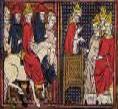
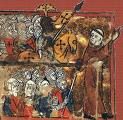



In 1095 the Fatimids of Egypt under emir (sultan) Aphdal take advantage of the quarrels among the Seljuks and take Palestine incl. Jerusalem and Tyre; Peter the Hermit (Peter of Amiens) (1050-1115), a priest of Amiens in Picardy (a former soldier under the counts of Boulogne, who took holy orders after his wife got old and ugly) visits the Holy Sepulchre in Jerusalem, gets pissed-off at the "sufferings of the natives and pilgrims of Palestine", and goes to ecumenical patriarch of Constantinople (1084-1111) Nicholas III Grammaticus (-1111) lobbying for Byzantine emperor (1081-1118) Alexius I Comnenus (Alexios I Komnenos) (1048-1118) to take it back, but is stonewalled, causing him to land in Bari and meet with Pope (1088-99) Urban II (Otto de Lagery) (1042-99), who shines to the idea, telling him to go out and preach the cause, which he does with gusto in Italy and France; "His diet was abstemious, his prayers long and fervent, and the alms which he received with one hand, he distributed with the other: his head was bare, his feet naked, his meagre body was wrapped in a coarse garment; he bore and displayed a weighty crucifix; and the ass on which he rode was sanctified, in the public eye, by the service of the man of God... every breast glowed with indignation when he challenged the warriors of the age to defend their brethren, and rescue their Saviour... The most perfect orator of Athens might have envied the success of his eloquence... and Christendom expected with impatience the counsels and decrees of the supreme pontiff" - Gibbon, Ch. 58; the whole story is phony baloney, made up by later writers as a coverup?; meanwhile, after receiving a letter from Byzantine emperor Alexius I seeking help against the Seljuks, Urban II hastily summons a church council to discuss the problem (really the opportunity to unite the two churches under himself); the 200-bishop, 4K-clergy, 30K-laity Council of Placentia hears Byzantine ambassadors pleading their Western European Christian brethren to come save Constantinople from the Turks, to take the battle to Muslim Asia before the Muslim Turks take the battle to Europe (later used by U.S. Pres. George Dubya Bush?), revealing the pope's true reason for the Crusade; like Bush, he wants Congress to approve it first, so he calls the 8-day Council of Clermont in Auvergne, France (his native country), which he attends on Nov. 27 with 13 archbishops, 225 bishops, and 400 priests, while thousands of adoring laity (plus lords and knights) attend; it proclaims the Truce of God (a suspension of hostilities four days of each week), places women, priests, husbandmen and merchants under the protection of the church from the current private wars, and the nine Christian Crusades to Jerusalem begin with the First Crusade when on Nov. 27 Pope Urban II gives a Killer Sermon, calling for an end to private wars among Christians and an all-out effort to sweep the Muslim infidels back and restore the site of the Holy Sepulchre into Christian hands, sweetened by a plenary (paid in full for all sins) indulgence for enlistment, telling them not to do it for vengeance but for contrition or penance; (you had to be there, but) as the crowd shouts "God wills it, God wills it!" (Deus vult, Deus vult!) (Deus lo volt) (Deix el volt), the pope exclaims, "And let this memorable word, the inspiration surely of the Holy Spirit, be forever adopted as your cry of battle, to animate the devotion and courage of the champions of Christ. His cross is the symbol of your salvation; wear it, a red, a bloody cross, as an external mark, on your breasts or shoulders, as a pledge of your sacred and irrevocable engagement"; after great numbers of clergy and laity get red and put the bloody cross on, and ask popey to lead them into battle, he, ahem, begs that his official duties preclude him from taking time from his busy schedule, and appoints Bishop Adhemar (Ademar) of Le Puy (-1098) (the first bishop he ever elevated) as his legate to the Crusades in Dec., and Count Raymond IV of Toulouse (Raymond I of Tripoli) (Raymond of Saint-Gilles) (1038-1105) as the military cmdr., with instructions to depart for the Holy Land on Aug. 15 of next year (Festival of the Assumption); meanwhile Urban II stays far from the action, traveling around in the rear giving more speeches to raise more suckers, er, soldiers and support; not to be left out, Benedictine brain man Guibert of Nogent (1055-1124) informs the Crusaders that Jerusalem must be seized as a necessary prelude to its eventual capture by Antichrist, followed by the Second Coming of Christ, with the soundbyte "The End of the World is already near" - he meant 1099, the next available Millennium Fever year?



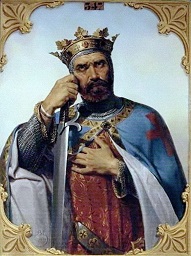
On Feb. 11, 1096 despite Philip I's excommunications preventing him, a lunar eclipse makes Count Hugh the Younger of Vermandois (1057-1101) decide to join the First Crusade, taking the smart route via the Alps and Rome to Bari, then across the Adriatic Sea to Illyricum, sending an "absurd message" (The Alexiad by Anna Comnena) to Byzantine emperor Alexius I Comnenus: "Know, Emperor, that I am the King of Kings, the greatest of all beneath the heavens. It is fitting that I should be met on my arrival and received with the pomp and ceremony appropriate to my noble birth", later sending 24 envoys to the doux of Dyrrhachium with the message: "Be it known to you, Doux, that our Lord Hugh is almost here. He brings with him from Rome the golden standard of St Peter. Understand, moreover, that he is supreme commander of the Frankish army. See to it then that he is accorded a reception worthy of his rank and yourself prepare to meet him"; too bad, his fleet is lost in a storm, and he is thrown ashore near Epirus and brought to Dyrrachium, where the doux, the emperor's nephew John Comnenus (Komnenos) shows him hospitality and has him escorted by Gen. Manuel Boutoumites (Butumites) to the emperor, who talks him into swearing fealty and swearing that he will restore all former Byzantine territories lost to the Turks, and hold any conquests as fiefs; too bad, he tries to talk Godfrey of Bouillon into doing ditto, and receives the reply: "You left your own country as a ruler... with all that wealth and a strong army. Nnow from the heights you've brought yourself to the level of a slave. And then, as if you had won some great success, have you come here to tell me to do the same?", to which Hugh replies "We ought to have stayed in our own countries and kept our hands off other people's." On Apr. 20, 1096 (Easter), with Millennium Fever at a high pitch, and large numbers of unemployed mercenaries left over from Normandy and Sicily needing work, the People's Crusade (60K mainly poor knights and peasants), led by barefoot, ass-riding, cross-wearing Peter the Hermit (Peter of Amiens) (1050-1115) leaves Cologne for the Holy Land, and is soon joined by 20K German peasants led by the monk Godescal, followed by another 200K lowlifes, led by two holy mascots, a goose and a goat, who warm up by massacring prosperous Jewish colonies along the Rhine River (Cologne, Moselle, Verdun, Treves, Mentz, Spires, Worms, etc.) for fun and profit along the way after being put up to it by Count Emicho, who is killed by King Coleman of Hungary in late May; on May 3 the Crusaders drag 11 Jews into a church in Speyer, then kill them when they refuse to convert, while the rest of the Jews are protected by Bishop Johannsen, who gets some of the guilty Crusaders executed; on May 27 Archbishop Ruthard of Mainz hides 1.3K Jews in cellars, causing the Crusaders to break in and massacre 1,1014, a remnant being saved by concealment in the cathedral, and four Jews accepting baptism later committing suicide; on June 1 after Bishop Egilbert of Trier offers protection to Jews only on the condition of conversion, several women kill themselves and their children by drowning in the Moselle River; in June after the Jews of Cologne are given shelter in Christian homes while the Crusaders burn their quarter and kill stragglers, Bishop Hermann sneaks them to Christian homes in the country, but is discovered, and most of them are massacred, incl. 200 in two villages, and mass Jewish suicide in four others; on Aug. 20 after Bishop Allebranches of Worms tries to hide Jews in his palace and a crowd sieges it, he advises conversion to save themsleves, but 800 (most) commit suicide; the Jewish colonies take 70 years to recover; the first party of Crusader lumpen, lurdans, and rabble under the command of Walter de Pexejo and Walter the Penniless (Gautier Sans-Avoir) passes through Hungary safely, but are attacked in Bulgaria; Peter the Hermit and his 20K crusaders follow, but sack Belgrade and Semlin in June after seeing the clothing of 16 Crusaders on the walls of the latter, then march to Nissa (Nish) in Serbia, where they are first greeted hospitably but have their butts kicked on July 3 after an accidental quarrel; they then proceed to Constantinople, arriving in Aug.; while Peter is negotiating with the Byzantine emperor, his 300K-man army, led by the well-financed Walter the Penniless (eight horsemen for each 15K foot soldiers) is annihilated on Oct. 21 by Turkish bowmen at the Battle of the Plains of Nicaea (Nice), leaving a "pyramid of bones" (Gibbon); the Crusaders in Constantinople are shocked when they encounter the Turcopoles (Turopoliers), mixed Greek-Turkish mounted archers working for the emperor who profess to be Christian but might be Muslim inside, but they end up employing them as long as they eat at separate tables?; avg. Crusader height is 5'3", and they wear chain not plate mail, which isn't invented until the late 12th cent.; their horses are puny compared to the Muslims for lack of Arabian blood, and it takes two cents. to catch up. The second stringers are down, so call in the first string? On Aug. 15 after selling Bouillon to Bishop Orbert of Liege for 1300 marks of silver and 3 marks of gold (1 mark = 230g), bilingual (French and German) Godfrey (Godfroi) (Godefroi) (Geoffrey) de Bouillon (1058-1100), duke (since 108) of Lower Lorraine and Margrave of Antwerp, a direct descendant of Charlemagne in the female line and a descendant of Sigisbert, last Merovingian king) leaves for the Crusades with his brothers Eustace and Baldwin at the head of 80K infantry and 10K cavalry; too bad, he starts out by declaring that he would avenge the blood of Jesus upon the Jews, and kill all who won't convert, abetted by a monk who claims that an inscription on the Holy Sepulchre orders all Christians to convert them; William I the Conqueror's eldest son Robert Curthose pawns Normandy to William II Rufus for 10K marks (1% of its yearly revenue) to finance his departure for the Holy Land, his party consisting of Frankish and Norman barons Tancred (1075-1112) (nephew of Robert Guiscard by his daughter Emma and Marquess Odo), Bohemund (Bohemond) I de Hauteville, Count of Taranto (1057-1111) (son of Robert Guiscard) (the #1 military man of the First Crusade, who allegedly fights like a starved lion among a flock of sheep), Count (since 1093) Robert II of Flanders (1065-1111), and Count (since 1089) Stephen II of Blois and Chartres (1045-1102) (known for writing gung-ho Letters to Wife Adele About the Crusade), led by papal legate Bishop Adhemar of Puy and Raymond of Toulouse in several large contingents totaling well over 100K; on Dec. 25 Godfrey's main force of 60K arrives in Constantinople, where suspicious Emperor Alexius I is at first startled because he only asked the pope for 300 top knights, and instead sees a host of heretical locusts, which he locks outside the city gates, but finally gives up on stopping them and decides to use them, making the leaders promise to do homage to him for all territory conquered from their common infidel foes in return for giving them boat passage across the Bosphorus and opening food markets - I'll bet they renege? Taking advantage of their troubles with the Crusaders, David IV of Georgia renounces tribute to the Seljuks. Welf II/V of Bavaria divorces old hag Matilda of Tuscany, allowing his daddy Welf I/IV (d. 1101) to patch things up with HRE IV and get his dukedom back next year; too bad, he never remarries and leaves the dukedom swinging in 1120.
On Apr. 10, 1097 Bohemund arrives in Constantinople ahead of his army; Tancred arrives with the army a short time later; Duke Robert of Normandy arrives in May with the last large Crusader army; along the way Crusaders pass through Phlaginia (ancient Butelion) on the Dragur River at the foot of Mt. Pelister in Macedonia,and massacre the pop. and raze the town after discovering they are "heretics", after which a number of Greek monasteries are built in the area, causing it to be called Monastir; the principality of Lesser Armenia aids the Crusaders with equipment and troops; on May 14 the Crusaders siege Nicaea, where Turk leader Kilidge-Arslan (Soliman) holes up with 50K cavalry, and twice attacks the 6-mi.-dia. Christian camp, but the Crusaders capture it on June 19 after first bringing boats from the sea on sledges to Lake Ascanius, renaming it Iznik; the Turks agree to surrender only to Alexius, who takes over and sends the Crusader army under the guidance of a Greek general towards Phrygia, causing them to grumble that the emperor is a traitor to their cause; Soliman calls in all his markers and assembles a force of 200K-360K cavalry (Turks, Medes, Persians, Chaldeans), then catches up with the Crusaders on July 1 at the Battle of Dorylaeum (Eskishehir) 35 mi. S of Nicaea in Phyrgia in hot summer weather, and catches the 20K-man vanguard unprepared, almost defeating them with fast light mounted archers and dismounted archers who hold the bows in their feet while laying on their backs to increase the velocity until Duke Godfrey and the Count of Vermandois arrive with 60K cavalry, followed by Raymond of Toulouse, the Bishop of Puy, and the rest of the Crusader force, and rout Soliman, who evacutes Roum (Iconium) (Asia) with 10K guards, leaving the Latins to bemuse themselves with newfangled camels, then march 500 mi. through Lesser Asia unimpeded, finding the way to Syria blocked by the emirs of Cappadocia, taking Heraclea (modern-day Eregli in Konya Province) in Aug. by a cavalry charge, then coming to a desert which wastes them with heat, thirst, and steep passes on Mount Taurus in the Anti-Taurus Mts., killing 500 plus many horses incl. Baldwin's wife Gothilda, freaking him out because her lands will return to her family, making him desperate to make up for the loss by seizing and looting a city to the E; Soliman moves the capital of the Turkish Sultanate of Rum (Roum) (founded 1077) to Konya (Konia) (Iconium) in SC Anatolia, and the Byzantines recover the entire W coast of Anatolia. On Sept. 10 Tancred and Baldwin leave the main Crusader forces with 1.2K knights, capturing Tarsus and placing the Norman standard on its walls, followed by Mopsuestia (Mamistra); they then quarrel and fall out. On Oct. 21 after Bohemund and Robert of Flanders lead a foraging expedition that is attacked by the Turks outside the city on Oct. 20, the Crusaders begin the Siege of Antioch (ends June 3, 1098); Antioch, known for its strong thick walls with interlocking towers that foil battering rams is led by able Seljuk Turkish cmdr. Yagi-Shihan (-1098), known for his thick grey beard and big hairy ears, who sends the Christian pop. of the city outside the walls to dig trenches then locks them out, forcing the starving Crusaders to have to feed them too; in Dec. the Crusaders defeat a relief army from Damascus outside the city.
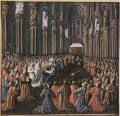
In early Feb. 1098 Tancred and his followers return to the main Crusader force; Tancred finds Peter the Hermit fleeing to Constantinople and returns him to the Crusader force; a delegation arrives from Fatimid Egypt sending greetings and offering to ally with the "great and small princes of the Christians" against the Turks, who are described as "a race foreign to me and dangerous to my kingdom"; on Feb. 9 the Crusaders and Fatimids battle Ridwan of Aleppo before the Fatimids return to Egypt with an agreement that if the Crusaders capture and hold Antioch, the Egyptians will retake Jerusalem and help Christians finish their pilgrimage and be assured of restoration of their churches and shrines, after which the Egyptians siege Jerusalem in Aug. and take it from the Seljukes before returning to Egypt, causing the Crusaders to waffle in their decision to march to Jerusalem until next year after deciding that the terms that they must arrive unarmed in groups of 200-300 is taken as an insult, rushing to take it in early 1099 and catching the Fatimids unprepared as they are tearing down the defenses to welcome the pilgrims; on Mar. 9 after Godfrey of Bouillon's brother Baldwin (Baudouin) of Boulogne (1058-1118) is invited by Greek Orthodox Armenian ruler Thoros of Edessa (-1098) of Edessa (Urfa) (modern-day Sanliurfa in SE Turkey) to help resist the Seljuks, capturing Turbessel (Tell Bashir) along the way, he makes an alliance with him in Feb., talking him into adopting him as his son and heir then inciting the people against him by promising to protect them from the Seljuks, getting him assassinated on Mar. 9 and his head carried triumphantly through the streets, after which he is given possession of the city, becoming count #1 of the County of Edessa (ends 1144), the first principality of the new kingdom of Outremer ("beyond the sea"), which lasts 54 years; meanwhile the Siege of Antioch (begun Oct. 21, 1097) grinds on for 7 mo., with at least 100K dead on each side, until Bohemund finds a traitor on the other side, Syrian Christian Tony Shalhoub, er, Phirouz, cmdr. of three towers, a wealthy Armenian Christian convert to islam who accepts a bribe and throws down ladders to help the Christians invade the city in a planned night attack on June 3, allowing them to capture all of the city except the central citadel after a great indiscriminate slaughter that makes the city stink to high heaven with piles of corpses; after hearing false news of the capture of the citadel, Yagi-Shihan flees the city, repents, starts crying, and is killed by a shepherd, who mounts his head on a stick, returning it to the Franks in the city; the next day a 600K-man Seljuk relief army led by Mosul atabeg Kerboga (Kerbogha) and 28 Turkish emirs appears, and on June 5 Stephen II of Blois flees, telling the advancing Byzantine army under Alexius I that he had just seen the kerboga man and all is lost, causing him to chicken-out and return to Constantinople and later get pussy-whipped by his wife Adela to try a 2nd fatal crusade in 1102; on June 7 the Turkish relief army begins a siege of Crusader-held Antioch, demanding unconditional surrender; on June 15 just as Crusader morale is breaking, a vision of St. Andrew by priest Peter Bartholomew (Bartholemy) (-1099) of Marseille, France leads him to choose 12 disciples and miraculously dig up the Holy Lance (Spear of Destiny) (Lance of Longinus) (the head of a Saracen lance he conceals in his robes and secretes at the bottom of a 12-ft. pit when they were about to give up after 1.5 days) in St. Peter's Cathedral in Antioch in front of a big crowd; many believe in this holy farce and morale soars, and Count Raymond of Toulouse latches onto it; on June 28 the Franks led by Bohemund (most of them dismounted due to having eaten all but 200 of 60K horses) win a decisive V against the Seljuk army, aided by the Holy Lance, plus the timely and miraculous appearance of three white-robed knights in the hills, which Bishop Adhemar claims are the martyrs St. George, St. Theodore, and St. Maurice (which J.R.R. Tolkien steals for his 1955 novel "The Two Towers"?); finally the central citadel is captured; Bohemund receives Antioch as a principality; too bad the Crusaders turn the city into a brothel, and an epidemic sweeps it, killing 50K incl. Bishop Adhemar in Aug.; Count Hugh of Vermandois is sent back to Constantinople to appeal for reinforcements to emperor Alexius I, but is pooh-pooh, and returns to France rather than fulfill his vow to make a pilgrimage to Jerusalem, getting scorned by the pop. and threatened with excommunication by Pope Paschal II, not to mention his wife Adelaide. On Dec. 12 after the Crusaders in Antioch suffer from starvation despite raiding the surrounding countryside, some Crusaders led by Raymond IV of Toulouse (Raymond I of Tripoli) (Raymond of Saint-Gilles) (1038-1105) and Bohemund I de Hauteville, Count of Taranto (1057-1111) siege and occupy Marre (Marra) (Ma'arra) (modern-day Maarat al-Numaan) between Aleppo and Hama and massacre the 8K pop., but still can't find enough food, resorting to cannibalism of Muslim corpses, boiling the adults and grilling the children along with choice buttock pieces from adults; "A dainty dish is Paynim flesh, with salt and roasting due" ("The League of Antioch").

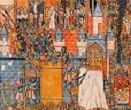


On Jan. 13, 1099 Count Raymond of Toulouse leads the ragged horseless Crusaders onward to Big J, the brass ring city of Jerusalem, while Bohemund and his followers (except Tancred) claim Antioch for their own for the 2nd Outremer principality, and refuse to recognize the suzerainty of the Byzantine emperor, causing them to go to war; on Feb. 14-Apr. 5 a contingent of Crusaders under Count Raymond of Toulouse detour to lay siege to Arqa in Syria, but fail to take the town, and the whole expedition proves a bust, exhausting his resources. On Apr. 8 to satisfy skeptics of the Holy Lance, Peter Bartholomew is put through the "Trial of Ordeal" (fire) at the insistence of conniving Flemish priest Arnulf Malecorne of Choques (Rohes) (-1118), who hopes to take Adhemar's place in the Crusader ranks; Peter runs very smooth and very sexy through the 12-in. path in a 14-ft.-long pile of 4-ft.-high burning faggots, but is badly burned and dies of his injuries on Apr. 20, and the Holy Lance "soon vanished in contempt and oblivion"; meanwhile after Jerusalem is captured Arnulf becomes Latin patriarch of Jerusalem #1 (and again in 1112-18) - Gibbon, Ch. 58. In May 1099 the ragtag Crusaders, 40K strong incl. 5K cavalry (knights) leave Antioch to Laodicea, down the seashore through Tripoli, Tyre, Sidon, Acre, Ashkelon, and Caesarea to the brass ring city of Big J, Jerusalem, arriving with 1.5K cavalry and 12K healthy foot soldiers. On June 7 after the Egyptian Fatimids under Caliph #9 Abul-Qasim Ahmad al-Mustali (Mostali) bil-Lah (1074-1101) offered safe passage to the Holy Sepulchre along with expensive gifts, all in vain, and the Crusaders waited 10 mo. after the defeat of Kerboga "to enjoy the luxury of Syria" (Gibbon), 13K Crusaders begin the Siege of Jerusalem (pop. 200K); the 40K Egyptian defenders under Iftikhar al-Dawla (Arab. "pride of the dynasty") defeat the early assaults while awaiting reinforcements, which are too late, allowing the Crusaders to conquer the city on July 15 after (you guessed it) 40 days; on July 15 First Crusade leader Godfrey (Godfroi) de Bouillon (1058-1100), duke of Lower Lorraine, whose camp was pitched on Mount Calvary enters Jerusalem, and his Crusaders merrily begin a 3-day massacre of the pop., killing 70K for Christ (incl. driving quaking Jews to their synagogue then burning them alive), while the flag of Godfrey's Jerusalem Cross flies over the city; "If you want to know what was done to the enemies found in the city, know this, that in the portico of Solomon and in his Temple, our men rode in the blood of the Saracens up to the knees of their horses" - Godfrey de Bouillon and Raymond Daimbert, Letter to Pope Urban II from Jerusalem; "They went together through the streets with their swords and spears in hand. All that they met they slew and smote right down, men, women, and children, sparing none... They slew so many in the streets that there were heaps of dead bodies, and one might not go nor pass but upon them that so lay dead... There was so much blood shed that the channels and gutters ran all with blood, and all the streets of the town were covered with dead men." (William of Tyre, 12th cent.); the Crusaders toake the crescent off the top of the Dome of the Rock and replace it with a cross, then build a Christian altar, only to see the Muslims take it back in 1187 and reverse the process. On July 17 a secret conclave is held, and Count Raymond of Toulouse asks for the kingship of Jerusalem, and is refused; Godfrey de Bouillon is offered ditto, and declines the title of king but suggests the title "Baron and Advocate (Defender) of the Holy Sepulchre", and is crowned by Peter the Hermit's associate King Tafur (from Calabria?); the secret conclave are mainly monks from Calabria via Godfrey's home in the Ardennes Forest who accompanied him on the Crusade, and move into the new Abbey of Mount Zion (Sion), built at Godfrey's request?; Raymond leaves Jerusalem, never to return, along with the French nobles; the new Latin Kingdom of Jerusalem, based on the cities of Jerusalem (falls in 1187), Antioch (falls in 1268), and Tripoli (falls in 1289) controls only a sliver of territory along the Syrian coast, except for the County of Edessa in SE Anatolia (until 1144), and depends on the Crusades of 1148, 1188, 1202, 1217, 1228 and 1249 for reinforcements, otherwise making little dent on the Muslim world?; the last Crusader fortress of Green Acres, er, Acre falls in 1291. On Aug. 12 after mistaking the Crusaders for Byzantine mercenaries, offering them an alliance against the Seljuk Turks, only to see them capture Jerusalem from his Fatimid forces, causing him to come quick, Egyptian vizier (1094-1121) Al-Malik al-Afdal ibn Badr al-Jamali Shahanshah (1066-1121) and 20K-50K Fatimids are surprised-attacked and defeated at the Battle of Ascalon by 1.2K knights and 9K infantry (last battle of the First Crusade), and Godfrey de Bouillon becomes the first king of the new Kingdom of Outremer ("Beyond the Sea") for one year with a force of 300 knights and 2K infantry, aided by Tancred; Baldwin is sent to rule Edessa; Raymond Daimbert, archbishop of Pisa becomes the patriarch of Jerusalem; one quarter of Jerusalem and Jaffa are ceded to the Church; the Muslim Dome of the Rock is converted into the Templum Domini (Temple of the Lord); Godfrey de Bouillon allegedly composes the Assizes of Jerusalem, a legal code for the Latin Kingdom of Jerusalem, which is kept in the Holy Sepulchre until the city is retaken by Saladin in 1187; meanwhile the Crusaders abandon Ascalon, allowing al-Afdal to use it as a base for yearly attacks until 1107, incl. three major battles in Ramla in 1101, 1102, and 1105, following by frequent raids into Frankish territory until his assassination on Dec. 11, 1121. On July 29 Pope (since 1088) Pope Urban II (b. 1042) dies without learning the good news that his bloody red Crusaders won the Super Bowl after being pumped by his rave Clermont Council pep talk of 1095, and on Aug. 13 Italian Cluniac monk and cardinal (since 1076) Rainerius is elected Pope (#159) Paschal II (-1118), carrying on Hildebrand's policy against secular investiture; Antipope (since 1080) Clement III has been beaten, and loses most of his influence.
In Sept. 1100 a large army of Lombard Crusaders, mainly peasants, led by Archbishop Anselm IV of Milan leaves from Milan; too bad, when they reach Byzantine territory they begin pillaging, causing Byzantine emperor Alexius I to arrive with his troops and escort them to a camp outside Constantinople, after which they break out, invade the big city and pillage his Blachernae Palace, killing his pet lion, after which the Byzantines round them up and ferry them across the Bosporus to Nicomedia.
On May 7, 1104 after faking a retreat for 2 (3?) days then suddenly turning and making their stand, catching the Crusaders not wearing their armor, the Battle of Harran 12 mi. of Harran near ar-Raqqah is a decisive V for the Seljuk Turks under Mosul gov. Jikirmish and Sokman, Artiquid lord of Mardin over the Crusader states of Antioch under Bohemond I, Edessa under Baldwin II, allied with Prince Tancred of Galilee, Joscelin of Courtenay, Antioch patriarch Bernard of Valence, Jerusalem patriarch Daimbert of Pisa, and Edessa archbishop Benedct, becoming the first major battle after the First Crusade, stopping Frankish expansion; Baldwin II and Joscelin are captured, and not ransomed until 1108; the Byzantines take advantage of the D to recapture Latakia and parts of Cilicia, while many towns ruled by Antioch revolt nd are reoccupied by Muslim troops, and Armenian territories revolt in favor of Armenia or the Byzantines; Bohemond I makes Tancred regent of Antioch and returns to Italy and raises a huge Frankish army, takes it to Epirus and unsuccessfully sieges Durazzo, while emperor Alexius I avoids open battle; Baldwin I of Jerusalem retakes Acre, making it the chief Crusader port, taking advantage of the spice trade to make them wealthy, growing to 25K pop. by the 1130s; after their troops bear the brunt of the D at Harran, Edessa limps along until 1144, surviving only because of divisions among the Muslims.
In 1108 Bohemond I's attack on the Byzantines fizzles with a D in Devol (Diabolis) in modern-day Albania, and he is forced to sign the Treaty of Devil with emperor Alexius Comnenus, recognizing Byzantine suzerainty over Antioch, with a Greek patriarch to be appointed; Bohemond I returns to Apulia and dies, and his nephew and regent refuses to accept the treaty, increasing distrust between the Byzantines and Crusaders; it takes until 1137 for the Byzantines to restore control, and until 1158 to make it a vassal again.
In 1109 after Crusader Raymond of Saint-Gilles (1041-1106) spends the last five years of his life setting up for the final V, aided by Byzantine emperor Alexius I, building the Citadel of Raymond of Saint-Gilles on Mons Peregrinus (Pilgrim's Mountain), Tripoli is captured by his son Bertand (-1112), who becomes count #1 of the County of Tripoli (ends 1289), which becomes a busy port and center of silk weaving, with the pop. speaking the Lange d'Oc of Provence; the inland settlemennt of Pilgrim's Mountain grows from a citadel into a suburb, hosting the Church of the Holy Sepulchre of Pilgrim's Mountain, the Church of Saint Mary's of the Tower, and the Carmelite Church, becoming a major base for the Knights Hospitaller, who in 1142 are given the Krak des Chevaliers by Count Raymond II of Tripoli.
In 1117 the Seljuks make peace with the Byzantines in Akroinon, abandoning the entire coastal area of Anatolia, plus all of Anatolia W of a line from Sinope through Ankara (Ancyra) and Philomelion.


On Aug. 15, 1118 C.E. Byzantine emperor (since Apr. 1, 1081) Alexius I Comnenus (b. 1048) dies after executing Bogomils sect leader Basil the Physician (-1118) for heresy, and his short ugly swarthy (Moorish-looking) but extremely pious son John II Comnenus (Kalojoannes) (the Good) (the Beautiful) (1087-1143) becomes Roman Byzantine emperor #154 (until Apr. 9, 1143), with his wife (since 1104) Irene (Piroska) of Hungary (1088-1134) as empress, proving of high moral integrity and ability, getting compared to Roman emperor Marcus Aurelius, concentrating on taking back the old frontier on the Euphrates and the Latin states of Syria; too bad he's less than top drawer as a military leader?; his ambitious bred-to-the-purple brain woman sister Anna Comnena (Komnene) (1083-1153), who expected to have her statesman-historian hubby (since 1097) Gen. Nikephoros Bryennios (Nicephorus Bryennius) (1062-1137) take the throne plots to have her brother John II assassinated at Alexius I's funeral, but it falls through, and after her hubby chickens-out ("Nature had mistaken the two sexes and had endowed Bryennios with the soul of a woman" - Choniates), she is stifled; after hubby's death she is retired to the Convent of Kecharitomene in Constantinople, turning into a historian herself (first female historian?), writing the 15-vol. Alexiad, a panegyric on her family and father's reign which becomes a major historical source for the period, explaining why she hates the Crusaders' guts.
On Jan. 16, 1120 the Council of Nablus, convened by Jerusalem King Baldwin II and Patriach Warmund establishing 25 canons along with the limits of secular and religious authority, beoming the first written laws of the Latin Kingdom of Jerusalem; Hugues de Payens obtains permission from Baldwin II and Warmund to found the Knights Templar. In 1120 the Byzantines under John II Comnenus begin a campaign against the Seljuks in Anatolia (ends 1121).
In 1121 the Byzantines recover SW Anatolia from the Seljuks, but have to break off and take on invading Patzinaks in the Balkans.
In 1122 the Byzantines under John II Comnenus exterminate the Patzinak Turks in the Balkans at the Battle of Beroia (Boruy) (Eski Zagra), ending their threat. The Byzantines refuse to renew their trading privileges with the Venetians, causing Venice to declare war (ends 1126).
In 1134 the Byzantines war with Lesser Armenia, which allies with the Latin kingdom of Antioch (ends 1137).

On Apr. 8, 1143 John II Comnenus (b. 1118) cuts his hand on a poisoned arrow while boar hunting on Mount Taurus in Cilicia, dying of septicemia several days later, and on Apr. 5 his son Manuel I Comnenus (Komnenos) (1118-80) becomes Roman Byzantine emperor #155 (until Sept. 24, 1180) after being chosen over his older brother because of valor in battle, going on to keep up the family name, becoming the #1 Comnenus, putting pressure on Hungary to keep it in turmoil; under his reign Constantinople is acknowledged as the capital of the Western world and the center of culture; his chasing of the elusive mirage of a new universal Roman Empire causes him to marry a Latin babe (Princess Maria of Antioch) (his first wife is Irene, sister-in-law of Conrad II), employ Latin nobles and intermarry them with the Greek aristocracy, get tough with the Hohenstaufen emperors and Normans, and engage in costly campaigns in the Mediterranean for little gain, all of which plays into the hands of the Seljuks of Rum, who use it as breathing space to recover while he bankrupts his empire?; Manuel I believes in the AIMA Prophecy, which predicts that the names of the Comnenus emperors will spell aima, the Greek word for blood, causing him to name his son (by his 2nd wife Maria of Antioch) Alexius II.
In June 1147 Louis VII of France sets out for the Second Crusade from the Basilica of St. Denis with his manly wife Eleanor of Aquitaine, leaving his kingdom in the hands of Abbot Suger; he and Conrad III of Germany take separate routes to avoid conflicts; after hearing about it, the Church forbids women to join future Crusades; unlike the First Crusade, attacks on Jews are openly encouraged, with Abbe Pierre of Cluny uttering the soundbyte: "What is the good of going to the end of the world at great loss of men and money to fight the Saracens when we permit among us other infidels who are a thousand times more guilty toward Christ than the Mohammedans?" I think we're alone now, the beating of our hearts is the only sound? In summer Conrad III's army reaches Byzantine territory, and Emperor Manuel I Comnenus permits them to move through his territory for the sake of his wife Irene (Conrad's sister-in-law Bertha of Sulzbach) (-1159); seeing his chance, the Normans under Roger II of Sicily begin a grab on the Greek-held islands, starting a war with the Byzantines (ends 1158), ravaging Euboea and Attica, plundering Thebes and Corinth, and carrying away silk workers, establishing them at Palermo.
I think we're alone now, the beating of our hearts is the only sound? On Oct. 25, 1148 after the Greeks clash with the Crusaders outside the walls of Constantinople (where they arrived in Sept.), nearly defeating them, and Emperor Manuel I stops it with diplomacy, securing an alliance with Conrad III against Roger II of Sicily, after which the army is speedily ferried across the Bosphorus to Damalis, while the emperor stabs him in the back by giving info. on his strength and movements to the Turks, the Seljuks of Rum under Masud I defeat the 20K-man Second Crusader German army (unaided by the Byzantines) at the Second Battle of Dorylaeum (Eskishehir), and on Nov. 16 ambush and defeat the starving French army (unaided by the Byzantines) at the Battle of Laodicea (Denizli), killing or capturing most of Bishop Otto of Freising's force and selling the POWs into slavery; Conrad III and his remaining 2K men join Louis VII's army and fight on.
In 1150 Saxon Germans from the Moselle region settle in the Zips and S Transylvania regions of Hungary after being called in to help defend the frontiers against the Poles and Byzantines; meanwhile Pechenegs and Szeklers are also called in to settle along the frontier for protection.
In 1151 the Venetians pave the way for the Byzantines to conquer Ancona from Roger II of Sicily and his Norman fleet.
In 1152 the Byzantines under top-of-his-game Emperor Manuel I Comnenus defeat the Serbs, then begin a war with the Hungarians (ends 1156) after the latter attempt to take Serbia and Bosnia.
In 1153 the Byzantines defeat the Hungarians.
In 1155 William I's cousin Robert de Bassonville (1120-82) revolts and takes Bari with the help of a Byzantine army under Michael Palaeologus, and when William I falls sick in Sept.-Dec. 25 and leaves the kingdom to Maio of Bari and archbishop (since 1150) Hugh of Palermo (-1161), a revolt begins seeking to have them removed, but Maio gets out of it by having his #2 Asclettin imprisoned by the king. Raynald de Chatillon raids and plunders Cyprus, pissing-off Byzantine emperor Manuel I Comnemnus, who captures him in 1159 in Antioch, making him beg for mercy.
In 1155 the Byzantines grant trade privileges to Genoa to counteract Venice.
In 1156 the Byzantines win their war against the Hungarians (begun 1152) and make peace, with the Hungarians recognizing the emperor's suzerainty of Serbia and Bosnia.
In 1157 Stephen of Armenia begins raiding Byzantine territories around Marash (modern-day Kahramanmaras) in S Turkey, pissing-off his half-brother Toros II, who doesn't want the Byzantines to come after him.
In 1159 Greek Byzantine emperor Manuel I kicks Raymond of Antioch's butt and forces him to renew his homage, then negotiates with Nur ad-Din in Syria; on his return he is attacked by Kilij Arslan II of Rum as he passes his capital of Konya (Iconium) - I like that old time rock 'n' roll?
In 1161 Seljuk sultan Kilij Arslan II of Rum is defeated by Byantine emperor Manuel I's nephew John Contostephanus, and travels to Constantinople to recognize the primacy of the emperor.
On Feb. 7, 1165 Armenian marshal (son of Levon I) Stephen of Armenia (b. 1111) is invited to a banquet by Andronicus Euphorbenus, Byzantine gov. of Tarsus, and murdered, causing his half-brother Toros II of Lesser Armenia to massacre Greeks within his territories; war is averted only by the intervention of Amalric I of Jerusalem.
In 1165 Byzantium allies with Venice against Holy Roman Emperor Frederick I Barbarossa.
Say, you won't dance with the music? In 1165 after the Hungarians continue to fail to 'get' it, Emperor Manuel I Comnenus begins another war with the Hungarians (ends 1168), taking Dalmatia.
In 1168 the Byzantines win their war with Hungary (begun 1165), and receive part of Croatia; from now on Emperor Manuel I Comnenus actively intervenes in Hungarian dynastic affairs and eventually makes Bela III his puppet vassal.
In 1170 the Byzantine acquisitions in Italy and Dalmatia cause a war with Venice (ends 1177); all Venetian traders in Constantinople are arrested and their goods seized, but the threadbare Byzantine fleet is unable to do much.
In Sept. 1171 after Serbian grand prince Stefan I Nemanja sides with them in the hopes of gaining independence from Byzantine rule, the Venetians incite the Slavs of the E Adriatic coast to rebel also, and hire a German fleet to replace their navy, conquering Ragusa and Chios from the Byzantines.
In 1174 the Byzantines under emperor Manuel I Comnenus defeat the Venetians, followed by Stefan I Nemanja of Serbia, and take him POW back to Constantinople, making him vow to never attack them again.
In 1177 Byzantine emperor Manuel I scores a V against the Seljuks in Bithynia, and John Vatatzes drives them out of the Meander Valley.

By 1180 there are 60K Latins (Italians) living in Constantinople, trading with Venice, Pisa, and Genoa, and competing with Greek Byzantine traders, inflaming jealousies - feeling divine, we know how to do it? Marrying too young is a mistake? On Sept. 24, 1180 emperor (since Apr. 5, 1143) Manuel I Comnenus (b. 1118) dies, and his 11-y.-o. son Alexius II Comnenus (Alexios II Komnenos) (1169-83) becomes Roman Byzantine emperor #156 (until Sept. 24, 1183), with his mother Maria of Antioch (1145-82) as regent, who relies almost exclusively on Latins; he marries 8-y.-o. Agnes of France (1172-?), daughter of Louis VII; Stephen Nemanya of Serbia sees his chance, and begins establishing his independence from Constantinople and conquering southern territories; Kilij Arslan I

That's how it begins-uh? In 1182 after anti-Latin sentiment causes a popular revolt in Constantinople, Andronicus I Comnenus (Andronikos I Komnenos) (1118-85) (an uncle of Alexius II) leaves retirement, obtains backing from the army and marches on Constantinople, overthrowing the regents and massacring the Latin pop., mainly Venetian and Genoese merchants, and waging war with Patriarch Theodosius I (who is arrested), and porphyrogenita Maria Komnene (eldest child of Manuel I) and her hubby (Caesar) Renier of Montferrat, who are poisoned; remaining nuisance Empress Maria of Antioch is imprisoned and strangled by eunuch Pterygeonites and Constantine Tripsychos; Alexius II's marriage to Agnes is annulled, and he is married to his own daughter Irene, with Andronicus acknowledged as co-emperor.

You got to treat her like a lady and she'll give in to you? On Sept. 24, 1183 14-.y.-o. emperor (since Sept. 24, 1180) Alexius II (b. 1169) is strangled with a bow string at Andronicus I's orders, and he becomes the sole emperor, Roman Byzantine emperor #157 Andronicus I Comnenus (Andronikos I Komnenos) (1118-85) (until Sept. 12, 1185); he then marries Alexius' 11-y.-o. widow Agnes, cleans the court of the hated Latins, massacring them, then reforms the govt. and lessens taxes; Stefan I Nemanja allies with Bela III of Hungary and Kulin of Bosnia and uses all this as an excute to invade Byzantine soil, advancing through the Morava Valley to Sophia, after which the Hungarians drop out, and they go on to raid W Bulgaria; the AIMA Prophecy is reset?

In 1185 the Normans renew their war with the Byzantines, taking Durazzo, then sending a fleet to storm Salonika and massacre the pop., which pisses-off the Greek landed aristocracy (which he is trying to curtail anyway?) against emperor (since Sept. 24, 1183) Andronicus I (b. 1118), and on Sept. 12 they depose, torture, and execute him; his great-nephew (son of Andronicus, who is the son of Andronicus I's father Isaac's sister Theodora and her hubby Constantine Angelus) Isaac II Angelus (Isaaco II Angelos) (1155-1204) (not the same one as the tyrant of Cyprus?) becomes Roman Byzantine emperor #158 (until 1195), and marries Margaret (Margit) (Maria) of Hungary (Antioch) (1175-1223), daughter of royally fertile Bela III of Hungary and his 1st wife Anne of Chatillon-Antioche, founding the Angelos Dynasty (ends 1204); after making peace with the sultanate of Rum, the Byzantines under Gen. Alexius Branas (Alexios Vranas) (-1187) score a V over the Normans at the Battle of Demetritsa, driving them out of the Balkans by 1191; too bad that Angelis is no angel, the old corruption is back, and the empire starts coming apart while powerful families begin going independent (the Sguros in Greece, the Gabras in Trebizond).
In 1186 the Byzantines defeat Asen and Peter, causing them to flee to the Cumans and return with an army, raiding into Thrace then devastating the Balkan region, annihilating much of the Greek pop.






On May 1, 1187 the Battle of Cresson sees the Knights Templar and Hospitalers defeated by the Ayyubids led by Saladin's son al-Afdal. Beating me, beating me down, into the ground, falling away from me? Crusaders from the Kingdom of Jerusalem break the truce and attack a caravan carrying the sister of cool all-black-wearing Kurdish Ayyubid sultan of Egypt and Syria (since 1171) Saladin (Salah ad-Din Yusuf ibn Ayyub) (1138-93), causing him to begin a holy war (jihad) against the Crusaders, invading the Kingdom of Jerusalem with his nephew Taqi al-Din and Gok-Bori and 200K Saracen troops (aided by Yaqub al-Mansur of Spain), then sieging the city of Tiberias; Byzantine Emperor Isaac I'm-No-Angelus allies with Saladin to avoid messing up his hair, and a relief army is organized by the Latins, led by Jerusalem king Guy de Lusignan, Count Raymond III of Tripoli (1140-1187), and Balian of Ibelin (1141-93) (not a blacksmith like Orlando Bloom in the 2006 Ridley Scott film "Kingdom of Heaven"?), but it gets trapped on July 4 at the Battle of the Horns of Hattin (Karnehatin) near the Sea of Galilee 6 mi. from Tiberias, and the heat-stroked Latin army is wiped out, with only 3K of 20K Christians escaping Saladin's 30K troops; after personally beheading Raynald of Chatillon, Saladin spares Guy de Lusignan with the soundbyte "Real kings don't kill each other"; the True Cross is fixed upside down on a lance and sent to Damascus, and several of Saladin's men leave his army to take their Frankish POWS with them; on July 5 Saladin captures Tiberias, allowing Countess Eschiva, Princess of Galilee (1118-87) safe passage to Tripoli with her family, followers, and possessions; on July 6 Saladin gives the Templar and Hospitaler POWs the chance to convert to Islam, and some become devout Muslims, while the rest choose martyrdom, incl. Hospitaler St. Nicasius; Guy de Lusignan is taken as a POW to Damascus and held for ransom; after Maimonides of Cairo talks him into it, Saladam permits Jews as well as Muslims to return and settle; on July 29 Saladin takes Sidon; plug-ugly Crusader Reginald of Sidon (-1202) (who speaks Arabic and grooves on Arabic lit., causing the other Crusaders to distrust him) bugs out of the rear of the Battle of Hattin and flees to Tyre, attempting to negotiate its surrender to Saladin until Conrad of Montferrat arrives and kicks him out, causing him to flee to the Crusader stronghold of Beaufort after finding that Saladin has captured Sidon, where he holes-up until 1190. On Sept. 20 after conquering Acre, Ibelin, Nablus, Toron, Sidon, Beirut, Ramla, and Ascalon, giving Balian time to organize the city defenses and create 60 new knights from the burgesses to supplement the 2-14 he had, Saladin begins the Siege of Jerusalem, and after knocking down some walls but finding the Christian diehards prepared to destroy the city and kill each other rather than surrender, he shows why he's a wise and honorable sport and permits the fashion model Queen Sibylla, the Christian defenders, and the Christian pop. to leave with safe passage, ransoming 7K men for 30K bezants, with two women or 10 children being equal to one man for the same price, the rest being forced into slavery after a 50-day payment period lapses; on Oct. 2 Balian of Ibelin hands over the keys to the Tower of David, and the Christian losers march away in three columns, with Balian and Patriarch Eraclius leading the last one on Nov. 20, ending the Latin Kingdom of Jerusalem (founded 1099); although he does not sack the city, Saladin ravages the Church of the Holy Sepulchre and turns it into a mosque, later returning it to the Christians after an agreement with Byzantine emperor Isaac II Angelus; the hostages end up in Tripoli; Saladin goes on to capture all Crusader territory except the seaport of Tyre, which remains in the hands of the Franks, and the cities of Antioch and Tripoli. On Sept. 27 after Stefan I Nemanja of Serbia attacks the Repub. of Dubrovnik, and Norman reinforcements arrive to help them, he signs a peace treaty declaring eternal peace, with nominal rule by Serbian kings, and the statehood of the repub. guaranteed. On Oct. 20 Pope (since 1185) Urban III allegedly dies of a broken heart after hearing the bad news from the Holy Land at Ferrara while en route to excommunicate HRE Frederick I Barbarossa for his antics, and on Oct. 21 Cardinal Alberto de Morra is elected Pope (#172) Gregory VIII (-1187), but he dies on Dec. 17 after only 1 mo. 27 days after proclaiming the Third Crusade and making overtures to reconcile Frederick I with the Church so he can be free to kick Muslim butt and get the Holy Sepulchre back, and on Dec. 19 Roman-born Paolo Scolari is elected Pope (#173) Clement III (-1191), immediately seeking to heal the old rift between the papacy and the Roman pop.
In 1194 after taking Sofia and the Upper Struma River Valley, the Bulgarians under Ivan Asen I invade Macedonia, causing the Byzantines under Basil Vatatzes (Western army) and Alexios Gud (Eastern army) to meet them at the Battle of Arcadiopolis near Lule Burgas in Anatolia; too bad, the Byzantines are annihilated, and Vatatsi is KIA; the D causes emperor Isaac II Angelos to plead to Bela III of Hungary for help.

In Mar. 1195 after personally leading a campaign against Bulgaria in Thrace and leaving camp to go hunting, giving his ungrateful older brother Alexius Angelus (who was redeemed from captivity and showered with honors by the emperor) the chance to proclaim himself emperor and get the soldiers behind him, emperor Isaac II Angelus is captured in Stagira, deposed, blinded, and imprisoned in Constantinople in Apr. along with his son Alexius IV by Alexius III Angelus (1153-1211) who is crowned Roman Byzantine emperor #159 (until July 18, 1203), and continues the campaign, which ends up a bust, causing him to offer peace to Tsar Ivan Asen I, but the latter demands the return of all Bulgarian lands, causing peace negotiations to fall through - these eyes have seen a lot of love but they're never going to see another woman like I had with you?
In 1196 the Battle of Serres in Greece is yet another Bulgarian V against the Byzantines under Gen. Sevastokrator Isaac, who is KIA after the cavalry is surrounded; too bad, before reaching the Bulgarian capital, Tsar Ivan Asen I is murdered by his cousin Ivanko, who had been bribed by the Byzantines, and tries to take the throne and ends up fleeing to Constantinople.
In 1196 HRE Henry VI, as heir to the Norman dynasty demands Durazzo and Thessalonica from Byzantine Emperor Alexius III, who stalls by giving him a huge bribe.


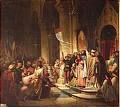
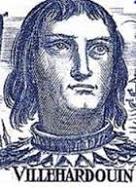


In Apr. 1201 (Lent) Fourth Crusade envoys Geoffrey of Villehardouin (Geoffroi de Villehardouin) (1160-1212) (Marshal of Champagne), Doge (1192-1205) Enrico (Henricus) Dandolo (1107-1205) et al. conclude the Treaty of Venice, with Venice, agreeing to transport 33.5K men and 4.5K horses in return for a 85K mark payment, and leave on June 29, 1202 for Egypt, which is thought to be the best route to the Holy Land; on May 24 Crusade leader Count Theobald III of Champagne (b. 1179) dies in Troyes, and his posth. son (born on May 30) Theobald (Thibaud) (Thibault) IV (the Troubadour) (the Chansonnier) (the Posthumous) (1201-52) succeeds him as count of Champagne in France (until July 8, 1253), immediately facing crushing debts from his crusading uncle Henry II of England, plus a succession dispute by Henry II's daughter Philippa and her hubby Erard I of Brienne, Count of Ramerupt (1170-1246), which takes until 1222 to resolve by buying him off; meanwhile in June the Assembly of Crusaders in Soissons elects famous Lombard soldier Marquess Boniface I of Montferrat (1150-1207) to lead the Crusade. On Dec. 25 a meeting is held in the forest town of Hagenau in Alsace-Lorrane between Philip of Swabia, dethroned Byzantine emperor Isaac II Angelus' son Alexius (brother of Philip's wife Irene), and Boniface, where a successful pitch is made to divert the Fourth Crusade to Constantinople to reinstate Isaac I, obviously in return for much baksheesh? Bulgar Tsar Kaloyan makes peace with the Byzantines, being allowed to retain most of the E Balkan area.

Ain't it good to know you got a friend? On Apr. 20, 1203 the Fourth Crusaders leave Zara for Corfu, then take Durazzo, where Isaac II Angelus' son (by his wife Margaret of Hungary) (the Crusaders' eager-to-please accomplice) Alexius IV Angelus (Alexios IV Angelos) (1182-1204) is proclaimed emperor, and on June 23 they arrive in Constantinople and begin a siege, causing Alexius III to flee to Adrianople on the night of July 18, after which they free and restore Isaac II Angelus, and make him proclaim Alexius IV co-emperor on Aug. 1, becoming Roman Byzantine emperor #160 (until Jan. 28, 1204); as the Crusaders' puppet Alexius IV bankrupts the treasury to pay them a heavy tribute of 100K marks, and the Greek and Roman churches are remarried for the time being, on paper, but not in reality, as the patriarch has no intention of going to Rome to request the grant of the pallium and the believers ain't about to change any of their ways; meanwhile Alexius asks the Crusader army to delay their planned Sept. 29 (Michaelmas) departure for Syria for one year, giving them time to discover how totally incompatible they and their new bride are, resulting in spousal abuse and a permanent dysfunctional relationship? Evil King John throws away northern France with a lame move?


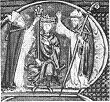



Everyone wants an old school lord and master? On Jan. 1, 1204 after some Crusaders attack a mosque in Constantinople, causing citizens to confront them, and a fire ravages a section of the city, causing the Latin pop. to take refuge in the Crusader camp, Byzantine emperor Alexius IV launches fire ships at the Venetian fleet, which they stop; on Jan. 25 after pissed-off Greeks mad about paying money to stinkin' heretic Latins start a riot, Alexius III's son-in-law Alexius V Ducas (Alexios V Dukas) Mourtzouphlos (Gr. "bushy eyebrows"?) (1140-1204) sees his chance and has Alexius IV Angelus (b. 1182) and Isaac II Angelus (b. 1156) arrested and killed on Jan. 27/28, and is crowned as Roman Byzantine emperor #161 on Feb. 5 (until Apr. 12), ending negotiations with the Crooked Crusaders and refusing to make any more payments, while strenghtening the city defenses, personally leading a surprise attack on the Crusader camp and beating back a Crusader assault on Apr. 9; too bad, on Apr. 12-13 soldiers of the Fourth Crusade, comprised of French nobles and their followers, as well as Venetians and Flemings (OE "men from the lowlands"), surprise, capture, and Sack the Hell Out of Constantinople, then rub this date rape in by declaring it a marriage, announcing the Latin Empire of the East (Romania), based in Constantinople (ends 1261), conveniently cutting Venice's rival "La Superba" Genoa (who is backed by Greece) out of the trade routes; Alexius V ducks out and escapes to Mosynopolis in Thrace, HQ of deposed emperor Alexius III, and marries his daughter Eudocia Angelina, until his new father-in-law turns on him and has him blinded and cast out, after which the Crusaders under Thierry de Loos capture him in Nov., bring him back to Constantinople, condemn him for treason against their puppet Alexius IV, and throw him from the top of the Theodosian Column in Dec., and he becomes the last Byzantine emperor in Constantinople until 1261; Boniface of Montferrat captures Boukoleon Palace on the shore of the Sea of Marmara, discovering a gaggle of women incl. Empress Margaret, daughter of Bela II of Hungary, whom he marries; happy camper Pope Innocent Three Times is the Charm declares the Great Schism ended, but the icon-loving Greeks refuse to give up that easy, and the result is its permanent hardening within two generations as the rapee tries to get loose and turn states' evidence or set the bed on fire?; a council composed equally of Crusaders and Venetians divides the Eastern Empire, giving the imperial crown to Count (since 1194) Baldwin of Flanders, crowning him Baldwin I (1172-1205), Latin emperor #1 of the East on May 16 in the Hagia Sophia in Constantinople (until 1205); Thomas Morosini (1170-1211) of Venice replaces the Greek patriarch, becoming the first Latin patriarch of Constantinople (until July 1211); Boniface of Montferrat is made king of Salonika (Thessalonica), which incl. part of Thrace, Macedonia, and Thessaly; the rest of the empire is split up among various baron vassals; Venice receives three-eighths of the city, plus Adrianople, Gallipoli, Crete (until 1669), Euboea (a triarchy), Naxos, Andros, the SW tip of the Peloponnesus (Coron and Modon), Durazzo and other posts on the coast of Epirus, the Ionian islands, and some islands in the Aegean; some believe the Shroud of Christ is taken back to France among the huge loot of holy relics by Knight Templar Richard de Clare, 4th Earl of Hertford (1162-1218), along with many priceless treasures melted down into coins; the looting happened because the Venetians, who supplied the ships took so long that many Crusaders made their own way and thus underbooked them, causing them to look for a way to get paid?; actually the long-simmering animosities between Venice and Constantinople, exacerbated by religious rivalry and that old Greek-Roman thang helped to breed a bank-robber-in-the-family mentality?; Pope Innocent III professes to be (really is?) shocked (innocent?), along with most of Europe, and excommunicates the Venetians for it, but makes hay of his opportunity to Latinize the Greek Orthodox Church, hardening the schism further; in 1207 after living through the Apr. 13, 1204 battle for Constantinople between the W Euro Roman Catholics and Byzantine Orthodox Catholics, French marshal of Champagne Geoffrey of Villehardouin (Geoffroi de Villehardouin) (1160-1212) begins writing De la Conquete de Constantinople (On the Conquest of Constantinople), a 3rd person memoir in lovely French, becoming one of the first works of French prose - another day here in the park, I think it was the Fourth of July, or, what a lady what a night, or, get that icon down? On Nov. 14 Pope Innocent III writes to the Roman Catholic clergy in the East, calling the transfer of imperial power in Constantinople from the Greeks to the Latins "the Lord's doing, and it is marvelous in our eyes", a quote from Psalms 118:23; the overthrow of the Byzantine Empire leads to successor Latin states in Greece; Michael I Comnenus Ducas (Michael I Komnenos Doukas) (1170-1214) sets up the independent Greek Empire (Despotate) of Epirus (ends 1340, then 1356-1479), which attempts to expand to the E and lasts until the Turks take it over in the 15th cent.; Theodore I Comnenus Lascaris (Theodoros I Komnenos Laskaris) (1174-1222), son-in-law of Alexius III founds the Empire of Nicaea in Bithynia (which eventually becomes top dog) as Theodore I (until 1221), and makes an alliance with sultan Kilij Arslan III of Rum to block the Crusader advance into Anatolia, but is defeated by the Crusaders under Peter de Bracheuil; Alexius III and David Comnenus sets up the Empire of Trebizond (Trapezuntine Empire) on the N coast of Anatolia, with Alexius at Trebizond and David at Sinope (ends 1461); the capture of Big C ends trade with Kiev, causing it to further decline until its final destruction by the Mongols in 1240; after they pass him as Latin emperor of Constantinople for Baldwin of Flanders because his brother Conrad married into the Byzantine royal family, the Venetians send Crusade leader Boniface of Montferrat (1150-1207) to conquer Thessalonica, which he does, founding the Kingdom of Thessalonica (ends 1224), which acknowledges subordination to Baldwin I, expanding by next year S through Thessaly, Boeotia, Euboea, and Attica; meanwhile crusading barons led by Burgundian nobleman Otto (Othon) II de la Roche (1170-1234) conquer Attica and the Peloponnesus, and he becomes the first duke of Athens (until 1225), acquiring Thebes by 1211; Bulgarian Tsar Kaloyan uses the opportunity to firm his kingdom up, seizing W Macedonia and aligning with Pope Innocent III, who sends a papal legate to crown him, along with a primate for Bulgaria.
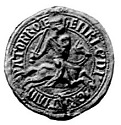
The Latins take over Byzantium only to inherit their problem with the Bulgar buggers? On Apr. 14, 1205 the Bulgars under Kaloyan, supported by the Cumans and local Greeks kick Frankish Crusader butt at the Battle of Adrianople, and capture Emperor Baldwin I (b. 1172), imprison him in Baldwin's Tower in Veliko Tarnovo, then kill (poison?) him; after receiving the bad news, next Aug. 20 his brother Henry of Flanders (1174-1216) succeeds him as Henry I, Latin emperor of Constantinople #2 (until June 11, 1216) (the ablest of the Latin emperors?) while the Bulgars overrun Thrace and Macedonia and exterminate much of the Greek pop.

In 1205 Guillaume (William) de Champlitte (1160-1209) and Geoffrey of Villehardouin conquer Achaea, and divide it into 12 feudal baronies on the French pattern (until 1278), with William I of Champlitte becoming prince #1 of Achaea (until 1209); the Achaean armorial is a cool yellow Latin cross on a red shield; despite being run by Roman Catholics, the Orthodox Greco-Slavic pop. is well treated and the govt. is popular with them?
In 1207 Theodore I Lascaris of Nicaea, allied with the Seljuks of Rum defeats David Comnenus and drives him back to Sinope, then concludes a truce with Latin emperor Henry I to oppose the advance of Alexius III of Trebizond, who is allied with the Seljuks.
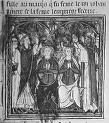
On Sept. 13, 1210 French Crusader John of Brienne (1170-1237) reaches Acre, and on Sept. 14 he marries Marie de Montferrat (1192-1212) (queen of Jerusalem since 1205), and on Oct. 3 is crowned king of Cypress and Jerusalem in Tyre (until 1225).
In 1214 Michael I Comnenus Ducas (b. 1170) dies, and next year his nephew Theodore Comnenus Ducas (Theodore Komnenos Doukas) (-1253) becomes despot of chuckalucka Epirus with whipped cream (until 1230), and announces his intention of expanding at the expense of the Latins and Bulgars by taking Durazzo and Corfu from the Venetians.

On June 11, 1216 Henry I of Flanders, Latin emperor of Constantinople (since 1205) dies in Thessaloniki (poisoned), and is succeeded by his brother-in-law (through his sister Yolande) Peter II of Courtenay (1155-1219), who is consecrated in Rome by Pope Honorius III next Apr. 9, and is captured en route to Constantinople by Theodore Comnenus Ducas of Epirus, dying in prison in 1219; his wife Yolanda of Flanders (Hainaut) (1175-1219) reaches Constantinople and rules as regent (until Aug. 1219), making peace with Theodore I Lascaris of Nicaea, who marries her daughter Marie (Maria) de Courtenay (1204-28).

In 1217 Peter II of Courtenay is captured by Theodore Dukas Angelus, despot of Epirus, and his wife Yolande becomes regent (until 1219), while her daddy John of Brienne (1170-1237) becomes Latin king of Jerusalem (until 1225); meanwhile in the spring after Pope Honorius III bars pesky Frederick II from participating, the Fifth Crusade begins (ends 1221); the Crusaders, led by Leopold VI of Austria and Andrew II of Hungary leave for Acre, where they are joined by John of Brienne, Hugh I of Cyprus, and Prince Bohemund IV of Antioch in an attack against the Ayyubids in Syria; Jerusalem Patriarch Raoul of Merencourt goes along, carrying a relic of the True Cross to pump them up; too bad, a screwup in funding causes a motley crew of cripples, aged, infirm, thieves et al. to join the army and be transported to the Holy Land, where they prove useless (except to prove to Muslims that Christians stink?); too bad, after they reach Jerusalem they find the walls and fortifications torn down and the Muslim defenders gone, and the Euros end up returning home next year; meanwhile, while no field battles are fought, both sides fight battles near their opponent's camps with the object of capturing or destroying their facilities; Andrew II overspends, causing him to sell royal land to oligarchs; the Latin Province of Syria is established, with Franciscian brother Elias as minister; by 1229 the Franciscans have a small house in Jerusalem near the 5th station of the Via Dolorosa.
In Aug. 1219 Yolanda of Flanders (1175) dies, and French crusader-trouvere Conon (Coesnes) (Conain) (Quenon) (Quenes) de Bethune (Béthune) (1159-1219) becomes regent of the Latin Empire of Constantinople, dying on Dec. 17 in Adrianople.
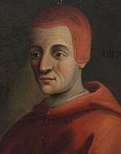
In 1220 after accompanying Peter II of Courtenay from Rome as papal legate and being captured with him then released, Giovanni Colonna (1170-1245) becomes regent of the Latin Empire of Constantinople (until Mar. 25, 1221).
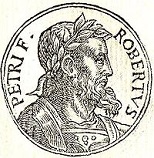
On Mar. 25, 1221 after his older brother Marquis Philip of Namur renounces the succession, Robert of Courtenay (-1228), younger son of Peter II of Courtenay and Yolanda of Flanders becomes Robert I, Latin emperor of Constantinople (until 1228), immediately appealing for help from Pope Honorius III and Philip II of France, who send little aid.

In Aug. 1222 Theodore I Lascaris dies, and on Dec. 15 his son-in-law John III Ducas (Doukas) Vatatzes (1193-1254) becomes emperor of Nicaea (until Nov. 3, 1254), proving a great general and ruler, bringing his empire peace and prosperity - a better mouth, guaranteed?
In 1224 Theodore Comnenus Ducas of Epirus captures Thessalonica and ends the Latin kingdom of Thessalonica (founded 1204), then proclaims himself Emperor of the West, going on to conquer Philippopolis and Andrianople; meanwhile John III Vatatzes of Nicaea defeats the Franks at the Battle of Poimanenon, then takes the islands of Samos, Chios, and Lemnos off the Anatolian coast, followed by Rhodes, and sends an army across the straits to capture Adrianople; meanwhile Robert I of Courtenay, Latin emperor of Constantinople is defeated by Theodore Dukas Angelus of Epirus at the Second Battle of Serres in Greece (first in 1196), after which he drives the invading Nicaeans away from Adrianople; when the dust settles Robert's territories are reduced to the city of Constantinople alone.

In 1225 Otto de la Roche resigns, and his son Guy I de la Roche (1205-63) becomes Latin duke #2 of Athens (until 1234).
In 1226 Robert of Courteney, Latin emperor of Constantinople is defeated by Theodore of Epirus and John III of Nicea, causing him to promise to marry Eudoxia, daughter of late Nicaean emperor Theodore I Lascaris, but since his sister Marie de Courtenay was his wife, Patriarch Manual Sarantenos prohibits the marriage, causing him to switch to the Lady of Neuville (-1228) (Eudoxia?), pissing-off a Burgundian gentleman, who organizes a conspiracy of knights in Constantinople to attack the house of the new wife and her mother, cutting off their lips and nostrils and throwing them in the sea, causing Robert to flee to Rome to obtain assistance from Pope Gregory IX, after which he falls sick and dies in 1228 in Morea during the return visit at the court of Geoffrey I of Villehardouin, prince of Achaea.
On Feb. 18, 1229 the Crusaders under cool multilingual brain man HRE Frederick II negotiate the Treaty of Jaffa and Tell Ajul with al-Kamil, ending the Sixth Crusade (begun 1228), agreeing to a commercial convention along with the surrender to the Crusaders of part of the Kingdom of Jerusalem, incl. the complete tour package of Jerusalem, Nazareth, Bethlehem, and Lydda, along with a corridor to the sea for Christian tour groups, and a 10-year truce; the Christians retake Jerusalem until 1239; on Mar. 18 HRE Frederick II crowns himself king of Jerusalem in the Church of the Holy Sepulchre, along with his infant son Conrad IV (b. 1228), for whom he acts as regent; the patriarch of Jerusalem, who opposed Frederick at every turn to please his boss the pope orders all clergy locked up so they can't help in the ceremony; hobbled by his ban he returns in June, seizes Cyprus with his Longobard troops, defeats a papal army in Sicily, and makes peace overtures to try to get the ban lifted; meanwhile the pope and the emperor trade epithets, accusing each other being the Antichrist (and they're both right?); former Latin king of Jerusalem (1210-25) John of Brienne returns to Jerusalem, and is chosen by the Latin barons of Constantinople to become regent of boy emperor Baldwin II of Constantinople, then becomes emperor in 1231 until he comes of age in 1237.
In 1229 Geoffrey I of Villehardouin (b. 1169) dies, and his eldest son Geoffrey II of Villehardouin (1195-1246) becomes prince #3 of Achaea (until May 6, 1246), becoming the most powerful vassal of the Latin Empire of Constantinople, helping the Crusader states in Greece regroup around him, going on to rescue Constantinople 3x and receiving the reward of suzerainty over Euoboea by Emperor Baldwin II, becoming known for his benevolent and just rule.
On Mar. 9, 1230 after Theodore Comnenus Ducas of Epirus (d. 1253), who sees Bulgaria as the only obstacle between him and Constantinople invades with 85K men without a declaration of war, Bulgarian tsar (since 1218) a href="http://en.wikipedia.org/wiki/Ivan_Asen_II_of_Bulgaria">Ivan (John) Asen II (-1241) defeats and captures and blinds him and captures or kills his entire army in the Battle of Klokotnitsa (Klokotnica) (in modern-day Haskovo Province, Bulgaria) (luckiest battle in Bulgarian history), then occupies W Thrace, Macedonia, and N Albania all the way to Dyrrachion, styling himself tsar of the Bulgarians and Greeks, and giving Thessalonica Theodore's brother Manuel Comnenus Ducas (Manuel Komnenos Doukas) (1187-1241)) (until 1237); Theodore and his son John spend seven years in captivity (until 1237), while Manuel goes on to lose Thrace, most of Macedonia, and Albania to the Bulgarians, making Thessalonica a vassal; meanwhile Michael II Comnenus Ducas returns from exile and seizes control of Epirus.
In 1237 blind Theodore Comnenus Ducas and his son John Comnenus Ducas (John Komnenos Doukas) (-1244) are released by the Bulgarians, and return to Thessalonica, inciting a revolt against Theodore's brother Manuel Comnenus Ducas, and John becomes ruler of Thessalonica (until 1239), while Theodore retires to Vodena.
In 1239 deposed Manuel Comnenus Ducas (-1244) returns with help from Nicaea and regains control of Thessalonica, calling himself emperor, pissing-off John III Ducas Vatatzes of Nicaea, who in 1242 invades and forces him to reduce his title to despot and recognize Nicaean suzerainty.
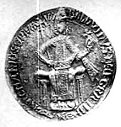
On Apr. 15, 1240 after coming of age and pawning Christ's alleged Crown of Thorns to a Venetian merchant for 13,134 gold pieces in 1237, Constantinople-born Baldwin of Courtenay returns and becomes Baldwin II (1217-73), the last Latin king of Constantinople (until July 24/25, 1261), spending most of his reign traveling to Italy and France scratching for money.
On May 6, 1246 prince (since 1229) Geoffrey II of Villehardouin (b. 1195) dies, and William of Villehardouin becomes William II (-1278), prince #4 (last) of Achaea (until May 1, 1278).

On Nov. 3, 1254 after conquering S Thrace and Macedonia from Bulgaria, allowing Michael II of Epirus to help himself to W Macedonia, then defeating him and forcing him to recognize Nicaean suzerainty, Nicaean emperor (since 1221) John III Ducas Vatatzes (b. 1193) dies in Nymphaeum, and his only son Theodore II Ducas Lascaris (Theodore II Doukas Laskaris) (1221-58) succeeds him as Greek emperor #2 of Nicaea (until Aug. 18, 1258). The term "Holy Roman Empire" is first used for the Empire of the West or Roman Empire started by Charlemagne in 800 (Holy Empire since 1157).
In 1254 the Bulgarians under Tsar Michael Asen I invade Serbia in support of Dubrovnik, forcing Stefan Uros I to make separate peace agreements; Michael Asen I attempts to reconquer the lost territories in the Balkans from Nicaea, but is badly defeated by Theodore II Lascaris at the Battle of Adrianople (Adrianopolis) on the Tundzha River 130 mi. NW of Constantinople.

On Aug. 18, 1258 Theodore II Lascaris (b. 1221) dies, and his 7-y.-o. son John IV Ducas Lascaris (John IV Doukas Laskarus) (1250-1305) becomes emperor #3 of Nicaea (until Dec. 25, 1261), with Michael Palaeologus as regent.

In 1259 Michael VIII Palaeologus (Palaiologos) (1223-82) becomes co-emperor of Nicaea (until Dec. 11, 1282), and defends the empire against a coalition of Michael II of Epirus, Manfred of Sicily, and William II of Achaea (after he marries Anna Komnene Doukaina, daughter of Michael II of Epirus), while working for the big enchilada of getting Constantinople back into Greek Orthodox hands; in Sept. William II attacks the Nicaeans at the Battle of Pelagonia, but is defeated after his Epirote army deserts, and after hiding under a haystack he is captured and held in captivity in Nicaea until 1262.

Build muscle, slim fat, lose weight? On July 25, 1261 after making an alliance with the Bulgarians and concluding the 1261 Treaty of Nymphaeum (Nymphaion) with Genoa on Mar. 13, promising them the privileges enjoyed by the Venetians, and catching the Venetian fleet away and crossing the Bosphorus Strait with a Greek army under Gen. Alexius Comnenus Strategopoulos, Nicaean emperor (since 1259) Michael VIII Palaeologus (Palaiologos) (1223-82) surprise-attacks Constantinople, entering the city through a secret passage and recapturing it without much difficulty from the hated Latins, ending the Latin Empire (founded 1204), and restoring the Byzantine Empire in a downsized version under Nicaean leadership after its 57-year exile; Baldwin II wakes up, flees after forgetting to take his scepter and crown with him, and boards a Venetian galley, which heads to Negropont, Athens, Apulia, and France, retaining his title of Latin emperor of Constantinople while sponging off Charles of Anjou, who takes over Sicily in 1267, diverting him from recapturing Big C; the Palaeologan (Palaiologos) Dynasty, the last Byzantine dynasty is founded (ends 1453), finally officially adopting the old Roman double-headed eagle as the official armorial (ending up turning the Byzantine Empire into a subject for paleographists and paleontologists?); after being left behind in Nicaea and blinded on Dec. 25 (his 11th birthday) to make him ineligible for the throne, John IV Ducas Lascaris (b. 1250) is exiled and imprisoned in a fortress in Bithynia, after which Michael VIII marries off his sisters to two Italians and a Bulgarian noble so their descendants can't threaten the imperial succession; despite an attempt to keep the blinding secret, the news comes out, causing Patriarch Arsenios to excommunicate him until the appointment of Patriarch Joseph I in 1268; former emperor Baldwin II escapes to Italy and transfers his claims on the throne of the Latin Empire of Romania (East) (Constantinople) to Charles I of Naples and Sicily or the Two Sicilies (Charles of Anjou and Provence) (1226-85) (youngest son of French king Louis VIII); the duchy of Athens continues for the next two cents., controlled in turn by French, Spanish, and Italian rulers, becoming one of the most brilliant feudal courts of Europe in the 14th cent.
1263 The Battle of Makryplagi (Makry Plagi) is a decisive V for the Latin Principality of Achaea over the Byzantine Empire.
1264 Emperor Michael VIII Palaelogus sends 50 ships to attack the Venetians in Acre, pissing them off and causing them to attack their Genoese rivals in Tyre, only to give up when reinforcements arrive.

1266 On May 24-27, 1267 William II of Villehardouin, prince of Achaea and his former Latin lord Baldwin II of Constantinople acknowledge Charles I of Naples (Sicily) (Anjou) (1227-85), as lord of Achaea in the Treaty (Treaties) of Viterbo, transferring most of the rights of the defunct Latin Empire of Constantinople to him.
In May 1274 after Byzantine emperor Michael VIII Palaeologus allies with the papacy against Charles I of Naples and Sicily, the Second Ecumenical Council of Lyons (first 1245) convenes, and the Greek Byzantines recognize the authority of the Roman Catholic pope in return for the council authorizing funds for another Crusade, which is never carried out, causing Michael VIII to be villified after his death, and the attempted reunion of the Roman and Greek churches to fall flat; on July 4 an embassy led by Mongol clerk-translator Rychaldus (Richardus) arrives to deliver a report on behalf of Mongol Christian gen. Abaqa seeking an alliance to drive the Mamluks out of Syria; meanwhile to quiet Byzantine critics and prevent another conclave of Viterbo, Pope Malcolm, er, Gregory X decrees that the cardinals have to be locked up until they elect a pope, founding the Papal Conclave (Lat. "with key").

In Jan. 1278 after purchasing it, Sicilian king (1266-85) Charles I of Naples (Anjou) (1227-85) is crowned king of Jerusalem, and acknowledged by the barons in Acre. On May 1, 1278 prince (since 1246) William II of Villehardouin (b. ?) dies, and Charles I of Naples succeeds him as king of Achaea, ending the Villehardouin Dynasty and beginning the Anjevin Dynasty, making it a province of Naples and turning the duchy of Athens into the most powerful independent state in Greece; William leaves the Manuscrit du Roi, showing what a noble poet he was?

On Dec. 11, 1282 emperor (since 1259) Michael VIII Palaeologus (b. 1223) dies, and his eldest surviving son Andronicus II Palaeologus (Andronikos II Palaiologos) (1259-1332) becomes Byzantine emperor (until 1328), immediately renouncing the church union established at the Second Council of Lyons in 1274.

In 1328 after accidentally killing his brother Manuel in 1320, causing their father Michael IX Palaeologus to die in grief and his grandfather Andronicus II Palaeologus to disown him, after which he flees to Thrace and proclaims himself emperor in Apr. 1321, starting the Byzantine Civil War of 1321-8 and forcing Andronicus II to make him co-emperor in Feb. 1325, Byzantine emperor (since 1282) Andronicus II Palaeologus resigns, and Andronicus III Palaeologus (Andronikos III Palaiologos) (1297-1341) becomes sole emperor (until June 15, 1341); next year he personally leads an expedition against the Ottomans under Orkhan I in Anatolia, and is defeated on June 10-11 at the Battle of Pelekanon near Nicomedia, causing the Byzantines to permanently abandon their cities in Anatolia.


On June 15, 1341 emperor (since 1328) Andronicus III (b. 1297) dies, and his 9-y.-o. son John V Palaeologus (Palaiologos) (1332-91) becomes Byzantine emperor (until Aug. 12, 1376), with his mother Anna of Savoy (1306-65) as regent, and his father's best friend Gen. John Cantacuzene (Cantacuzenos) (maternal relative of the Palaeologus family) as chancellor, but Anna doesn't trust him, declaring him an enemy of the state, causing him on Oct. 26 to declare himself emperor John VI Cantacuzene (Cantacuzenus) (Cantacuzenos) (1292-1383), and begin the successful 6-year Byzantine Civil War of 1341-47 (Second Palaeologan Civil War) with her, her son, and Patriarch John XIV in Thrace, with Anna allying with the Bulgarians and Cantacuzene with the Serbians and Ottomans, after which in summer 1343 Anna sends an emissary to Pope Clement VI in Avignon to seek help, and in Aug. 1343 he pawns the Byzantine crown jewels to Venice for 30K ducats.
In 1345 the Ottomans absorb the Turkoman principality of Karasi, bringing them to the S shores of the Dardanelles, then cross into Europe at the request of John Cantacuzene, helping him take towns along the Black Sea, and form an alliance by giving his daughter Theodora in marriage to Orkhan I; from now on the Ottomans freely cross the Bosporus Straits.
On Feb. 3, 1347 Hesychast book lover and able gen. John VI Cantacuzene reenters Constantinople as emperor, appointing anti-Hesychast scholar Demetrius Cydones (Cydonius) (Demetrios Kydones) (1324-98) as his chancellor, and deciding to try to reconcile the Greek and Latin churches, preparing a golden bull signed in cinnabar ink "giving our lord the pope his proper title and recognizing the primacy and universality of the Roman Church", and requesting a joint synod in Constantinople, Negroponte, or Rhodes to discuss union, also promising to personally lead a rescue army to Smyrna; John VI Cantacuzene is accepted by John V Palaeologus as senior co-emperor (until 1355); too bad, to win he allies himself with the Ottoman Turks, becoming the dork who is responsible for giving them a foothold in Europe, making an Ottoman V over Constantinople unstoppable even if they could have obtained Western military aid.
In 1366 the Ottomans lose Mel Gibson, er, Gallipoli (until 1376), but capture Thrace, and make Adrianopole their main base for European conquest, shrinking the Byzantine dominions.
In 1373 Byzantine emperor John V becomes an Ottoman vassal, recognizing the suzerainty of Ottoman Sultan Murad I - love the skin you're in?
In spring 1379 after being robbed on the Danube River, then visiting patriarch Euthymius of Turnovo, Bulgarian-born metropolitan of Kiev Cyprian arrives back in Constantinople, and shortly thereafter John V and Manuel II break out of prison with Venetian and Turkish help, causing Andronicus IV to flee by rowboat across the Golden Horn to the Genoese quarter in Galata along with his mother Helena and her aging father John VI Cantacuzene, after which patriarch Macarios is deposed, with Cyprian signing the deposition orders, and uttering he soundbyte: "I could not go out of it [Constantinople] because the imperial city was beleagured by much disorder and trouble; the sea was held by the Latins [warring Venetians and Genoese], whereas the dry ground was controlled by the God-hating Turks"; meanwhile boyar-backed Moscow metropolitan Mityai travels unsuspecting to Constantinople, stopping to receive support from the Golden Horde in Sarai, then suddenly drops dead before reaching it, causing the Muscovites to forge documents making priest Pimen (-1389) the new metropolitan, then learning of the fall of Macarios and turning back to Moscow; meanwhile Patriarch Euthemius of Turnovo launches the Second Slavic Influence (first was by Cyril and Methodius), an infusion of Hesychasm into easy-sell Russia, along with an effort to replace obsolete Church Slavonic.
By the 138s the Byzantine Empire has been reduced by the Ottomans to Constantinople, Thessalonica, Trebizond, and some parts of the Peloponnesus.

On Feb. 16, 1391 Byzantine emperor (since 1341) John V Palaeologus (b. 1332) dies, and the Byzantines lose their last possession in Asia Minor to the Turks; his grandson John VII Palaeologus seizes power for a short time; meanwhile on Feb. 16 John V Palaeologus's son Manuel II Palaeologus (Manuel II Palaiologos) (1350-1425) becomes Byzantine emperor (until July 21, 1425); trouble is, he's a hostage of Ottoman Sultan Beyazid (Bajazet) I?; in the winter he writes Dialogue Held with a Certain Persian, the Worthy Mouterizes, in Ankara of Galatia, on Christianity vs. Islam, containing the immortal soundbyte: "Show me just what Muhammad brought that was new, and there you will find things only evil and inhuman, such as his command to spread by the sword the faith he preached", which is quoted by Pope Benedict XVI on Sept. 12, 2006; it concludes "God is not pleased by blood, and not acting reasonably is contrary to God's nature. Faith is born of the soul, not the body. Whoever would lead someone to faith needs the ability to speak well and to reason properly, without violence and threats. To convince a reasonable soul, one does not need a strong arm, or weapons of any kind, or any other means of threatening a person with death", to which the Muslim replies that God isn't bound even by his own word, and that nothing can make him reveal the truth to us, and that he could even make us practise idolatry if he wants.
In 1421 John VIII Palaeologus (Palaiologos) (1392-1448) becomes co-emperor of the Byzantines with his father Manuel II (until 1425).
In June 1422 e Constantinople is sieged by Murad II, and co-emperor John VIII Palaeologus supervises the defense.
In 1422 false Mustafa launches another revolt, and Ottoman Sultan Murad II thrusts into Europe, crosses the Hexamillion Wall of Corinth and conquers the Peloponnesus, killing False Mustafa and forcing Byzantine emperor Manuel II Palaeologus to pay tribute for the rest of his life (until 1425).

On July 21, 1425 Byzantine emperor (since 1391) Manuel II Palaeologus (b. 1350) dies, and his eldest son (by Helen Dragas) John VIII Palaeologus (Palaiologos) (1392-1448) becomes sole emperor (until Oct. 31, 1448), last one before the fall.

In 1437 Byzantine emperor (since 1425) John VIII Palaeologus (Palaiologos) (1392-1448) appoints Latin-speaking theologian Isidore of Kiev (Thessalonica) (1385-1463) as metropolitan of Kiev, Moscow, and all Russia in an attempt to unite the Russian Orthodox Church with the Roman Catholic Church and gain Constantinople's protection against the horrible Ottomans; Russian grand prince Vasily II doesn't accept him, but Isidore of Kiev still manages to talk him into allying with Roman Catholicism to save the Byzantine Empire and the Orthodox Church of Constantinople, and receives funding from him.
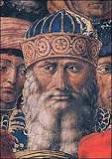

On Feb. 8, 1438 Byzantine emperor (125-48) John VIII Palaeologus arrives in Venice with a retinue of 700 incl. Constantinople patriarch Joseph II and 20 metropolitans, plus other big brains incl. Neoplatonist philosopher Gemistus Pletho (Plethon) (Georgius Gemistus) (1355-1452), who advocates a return to the Olympian gods, and his student Johannes (Basilius) (Basilios) Bessarion (1403-72); on Apr. 9 the Ecumenical Council of Ferrara convenes, with the patriarch refusing to kiss the pope's foot and instead bowing and kissing his cheek; John VIII Palaeologus pleads for assistance from the Turks encircling Constantinople, proposing a union of the Greek and Roman Catholic Churches; Pletho goes on to meet with Cosimo de' Medici, who founds the Platonic Academy of Florence under Marsilio Ficino (1433-99), who translates all of Plato's works and other Neoplatonist works by Plotinus et al. into Latin, helping revive Greek learning in W Europe; the academy is dissolved after the 1492 death of Lorenzo de' Medici (b. 1449). the academy is dissolved after the 1492 death of Lorenzo de' Medici (b. 1449).
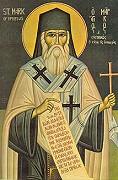
On Jan. 10, 1439 after the plague strikes Ferrara, the Ecumenical Council of Florence (begun 1431) continues the Council of Ferrara under the patronage of Cosimo de Medici; on July 6 the Roman Catholic and Eastern Orthodox Churches sign a treaty uniting on paper, with 1-sided terms favoring Rome, in return for Pope Eugene IV calling for a new crusade against the pesky Turks; too bad, when the Byzantine prelates return home, the Orthodox pop. gets pissed-off and either replaces them or makes them repudiate the union; Hesychast metropolitan Manuel Eugenicus (Eugenikos) (St. Mark of Ephesus) (1392-1444) of Ephesus is the lone Orthodox prelate to refuse to sign the union proclamation, making him a hero and getting him canonized in 1456; too bad despite lobbying by metropolitan Isidore of Kiev, the Council of Basel (ends 1449) creates a fresh schism; on Dec. 18 after he gets talked into switching allegiances, Pope Eugene IV makes Johannes (Basilius) (Basilios) Bessarion (1403-72) a cardinal, causing him to remain in Italy, using his knowledge of Greek to collect Greek mss. while promoting humanist studies; too bad, Isidore's flock rejects any union with the Latins, and refuses to let him return, electing a new patriarch of their own; the whole affair ends Moscow's longtime loyalty to Constantinople, and when it falls in 1453 they take it as God's judgment on them, bolstered by the Legend of the White Cowl, which claims that Rome deviated from the true (Orthodox) faith because of "pride and ambition", and the New Rome (Constantinople) did ditto, leaving Russia as the Third and Final Rome.

On Oct. 31, 1448 pale and disillusioned John VIII Palaeologus (b. 1392) dies childless, and after a dispute Sultan Murad II chooses his younger brother Constantine (Konstantinos) XI Dragases Palaeologus (Paleologos) (1404-53) to be the last Byzantine emperor (although he doesn't know it yet), and he is crowned next Jan. 6 (until May 29, 1453), entering isolated Constantinople on Mar. 12; his appointment as Roman consul #? is the last in a chain stretching back 1957 years; the Ottomans now slobber over Constantinople, the gateway to Europe, while the emperor vainly tries to get help from his uncaring Western Christian bro's.

On Feb. 3, 1451 sultan (since 1421, except 1444-6) Murad II (b. 1404) dies, and on Feb. 18 19-y.-o. Mehmed (Mohammed) II (the Conqueror) (1432-81) reascends the throne as Ottoman sultan #7 (until 1481), swearing on the Quran to the Byzantine embassy that he will respect their territorial integrity; having a lot to prove, he vigorously expands the family domain in Europe and Anatolia, earning the title of Conqueror (Fatih); remembering how the nobles kept him down, he works to centralize the state and make himself absolute ruler, confiscating property of leading Turkish families, promoting his devshirme (slave) elite, establishing the office of grand vizier, and becoming the first Ottoman ruler to codify state legislation in two major codes (kanunnames); too bad sin is in, and he spends too much, debases the currency, increases taxes and causes economic discontent?

On Dec. 12, 1452 desperate Emperor Constantine XI vainly declares the Greek Orthodox Church united with the Roman Catholic Church in an attempt to get Western military help for the looming Ottoman invasion of Constantinople, which they yawn off; Greek-born ecumenical Cardinal Isidore of Kiev (1385-1463) is sent from Rome by Pope Nicholas V with 200 soldiers, becoming the last diplomat of the Holy See to visit Constantinople until Francesco Lardone in 1959, leading 300 Byzantine clergy in a vain celebration of the reunion.



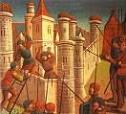

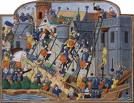
On Jan. 29, 1453 a relief force of two ships from Genoa with 700 men arrives in Constantinople, and its capt. Giovanni Giustiniani Longo from Chios is made cmdr. of Constantinople's defenses; on Feb. 26 (night) 700 Italians flee on seven ships, after which the city gates are closed and a giant chain strung across the Golden Horn. On Apr. 6 after assembling in Jan. on the plains of Adrianople and then reducing every city in their way, 150K Muslims, Janissaries, and Dervishes (incl. some Christians who wanted to get in on the loot) under 21-y.-o. whodya-wanna-call Ottoman Sultan (since 1451) Mehmed (Mehmet) (Mohammed) II (the Conqueror) (1432-81), the Saddam Hussein and Osama bin Laden of the 15th cent. begin the 54-day Final Siege of Constantinople (founded 330 C.E.), defended by 7K Christian knights; the sultan does the traditional Islamic thing of offering the emperor a chance to surrender in exchange for their lives, but he refuses, preferring to fight rather than switch, after which the artillery immediately begins bombarding the city with 70 cannons, incl. a 27-ft.-long 762m (30 in.) 35-ton bronze Shock'em Allah called the Great Turkish Bombard (Dardanalles Gun) (Basilic) (Sahi) (Muhammad's Gun) (designed by Hungarian engineer Urban), which lobs 1.2K-lb. balls up to 1 mi. at the key St. Romanus Gate; on Apr. 12 the 200-ship Ottoman fleet under Bulgarian renegade adm. Suleiman Baltoghlu arrives from Gallipoli, sealing the city off by sea completely; on Apr. 18 (night) the first assault by thousands of mad mullahs is repelled; on Apr. 20 (morning) four large vessels loaded with provisions (four Genoese and one Greek) arrive, and the lame Ottoman fleet fights them all day but fails to stop them from entering the city, pissing-off the sultan, who orders adm. Baltoghlu executed and replaced by Hamza Bey, then has half of his ships pulled on wooden platforms along a greased log roadway he previously constructed by the neutral Genoese colony of Pera across from Constantinople, then launched in the Golden Horn; Muslim assaults on May 7 and May 12 are repelled; by mid-May the Venetian Senate is still debating whether to send aid, and on May 23 a fast ship sent out in early May to greet the expected fleet returns with bad news; on May 22 a lunar eclipse freaks the superstitious Christians, who believe a prophesy that the city can't be taken under a full moon; on May 23 a thunderstorm freaks them more, followed by a strange ghost light surrounding the dome of the Hagia Sophia, which they interpret as the Holy Ghost abandoning it, which doesn't stop hundreds of refugees from crowding in; a captured Muslim engineer is made to talk and give info. allowing the Christians to locate and destroy the Muslim tunnels, buying time; on May 25 the sultan's advisers tell him to raise the siege before the Euros arrive and get them surrounded, but they don't call him the Conqueror for nothing, so he plans an all-out final assault; on May 28 the doomed Christians, sensing the end stage a holy procession, holding the last Christian service in Hagia Sophia, reconciling themselves to dying for their faith; on May 28-29 (Mon.-Tues.) at midnight the final siege begins; although the Christians repel wave after wave, things go bad when their cmdr. Giovanni Giustianini Longo gets wounded, and instead of standing his post orders that he be taken back through the gates to the city, causing the rest of the Genoese to think the gate has been breached, causing them to rush back to it, leaving the emperor and his Greek troops to face the Janissaries alone, after which they are KIA; after the 60-ft.-wide 20-ft.-deep moat and three sets of walls and towers (the inner two walls having 96 towers each) are breached, the city surrenders, after which the Allahu Akbars rape and massacre the helpless don't-say-dhimmi pop., chaining the rest to sell them into slavery (lucky non-white infidel beasts get to do unspeakable things to our white Christian wimmen, incl. gasp, nuns, and after 9/11, we're next?), leaving only 50K after being stopped after 24 hours by Mehmed II, who weeps after viewing the destruction, and utters the immortal soundbyte: "What a city we have given over to plunder and destruction", then awards himself the title of Caesar; Greek-born ecumenical Cardinal Isidore of Kiev (1385-1463) dresses a corpse up in his robes and watches the Turks cut off its head and parade it through the streets, then manages to get shipped to Asia Minor as a slave, later buying his freedom and returning to Rome, adopting the Latin Rite and becoming bishop of Sabina, and later Latin patriarch of Constantinople and archbishop of Cyprus sans jurisdiction, later making the mistake of returning to Moscow and holding a Latin Rite, which gets him imprisoned again; a legion of Cretans manning three towers near the entrance to the Golden Horde holds out and are given safe passage; the Ottoman sailors abandon their ships to rush into the city and get their share, allowing several Christian ships loaded with refugees to escape, incl. Giustianini, who dies a few days later in Chios; after the sultan heads into the city straight to it and personally breaks the altar, Hagia Sophia is turned into a mosque, and the Christian icons plastered over; last Byzantine emperor (since 1448) Constantine XI Palaeologus (Palaiologis) (b. 1405) dies defending the walls, and they stick his head on a pike; on Sept. 30 with infallible timing Pope Nicholas V issues a call for a new Crusade (first time the printing press is used to issue papal appeals?); the loss of Constantinople solidifies Europe around Rome, removing the age-old obstacle to uniting it religiously, while an Islamic prophesy makes the Muslims believe they will conquer Rome next; a major drive to repopulate Istanbul (Turk. "in the city or downtown") (Gr. "eis ten polin" = "into the city") begins, with the 60-alleyway Grand Bazaar (largest enclosed market in the world) built in 1455-61, turning it into the showpiece of the Middle East, with 400K pop. before 1800, about 45% Christian and Jewish; the Muslim Turks are now on the frontier of Germany, and put Venice on the defensive over her eastern colonies for the next 250 years; the Muslims set up a paper mill in Constantinople - how long until a Turk founds Atlantic Records and catapults Ray Charles and the Rolling Stones to stardom? Nothing is all bad? The fall of Constantinople to the Turks causes a large number of Greek scholars to flee to Italy, where they pump up the Renaissance in classical learning; it also leads to renewed efforts to find new westward routes to India and China across the Atlantic as the Ottomans are in a position to close overland trade routes to the Silk Road; after taking over Constantinople, the Muslims find lots of star and crescent flags, and adopt them as their symbol since Sultan Othman I allegedly had a dream of a crescent moon growing until it filled the world, even though Richard I Lionheart had used the symbol in the late 12th cent. when kicking Muslim butt for Christ. The Byzantine Period of the Greek Language ends, and the Modern Period of the Greek Language begins. The S Balkan region (from the Peloponnesus to the Danube River, incl. Albania, Constantinople, Thessaloniki, Thrace, N Greece and Macedonia, Serbia, and Moesia) begins to be called Rumelia (Rumeli) (Turkish "Land of the Romans") as the Muslim Ottomans conquer it from the Christians, who are all Romans as far as they are concerned; up till now they called it Anatolia Rumelia. The Shroud of Christ is sold by Marguerite de Charny to Duke Louis I of Savoy, who moves it to Chambery, France (until 1578); it was really such a poor fake that it disappears for 50 years until Leonardo da Vinci (1452-1519) can be hired to produce the modern good one, based on his own portrait?
In Oct. 1540 after the Ottomans take their remaining outposts in the Ionian and Aegean Seas, Venice signs a peace treaty with Ottoman Sultan Suleiman I the Magnificent in Constantinople, agreeing to recognize the Turkish territorial gains and pay 300K gold ducats.